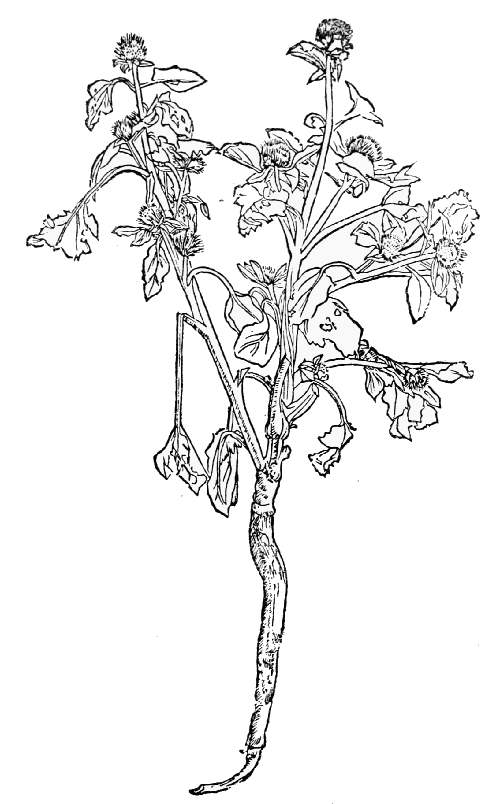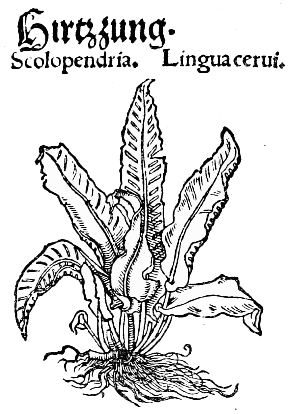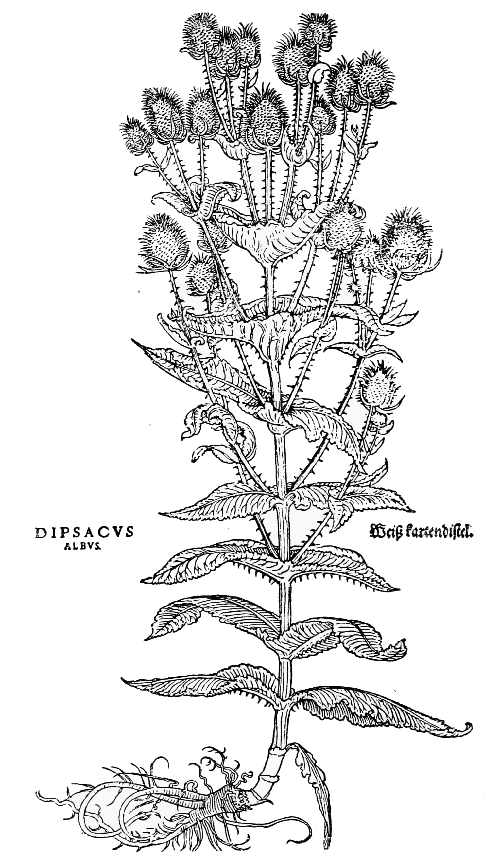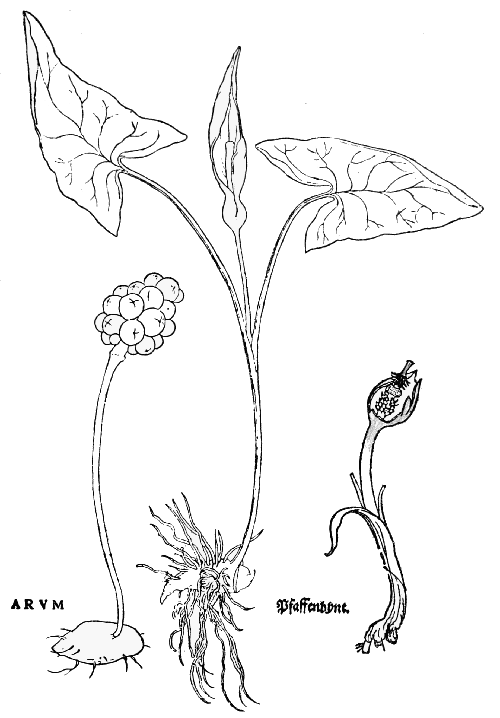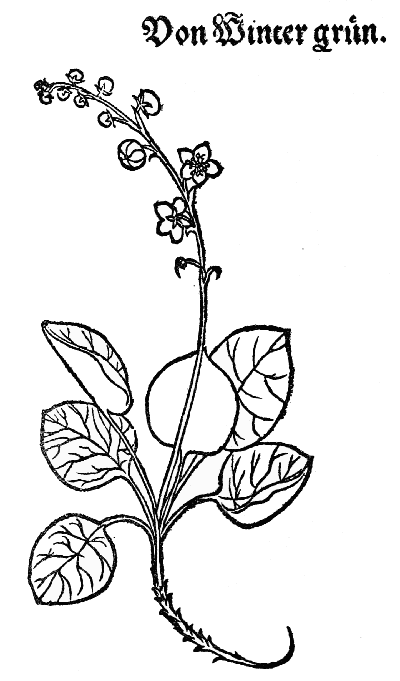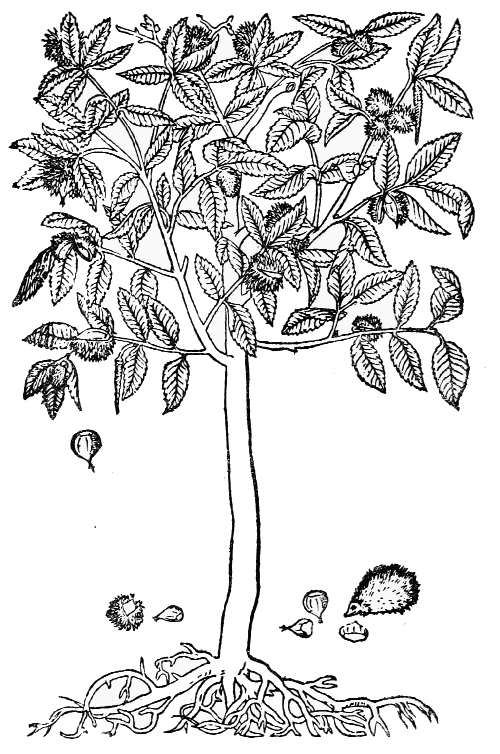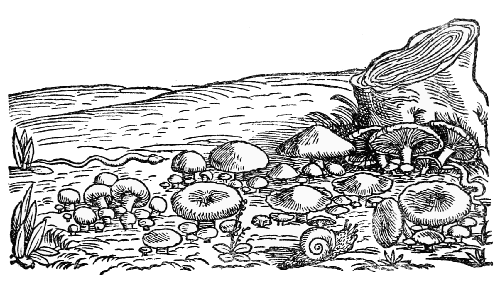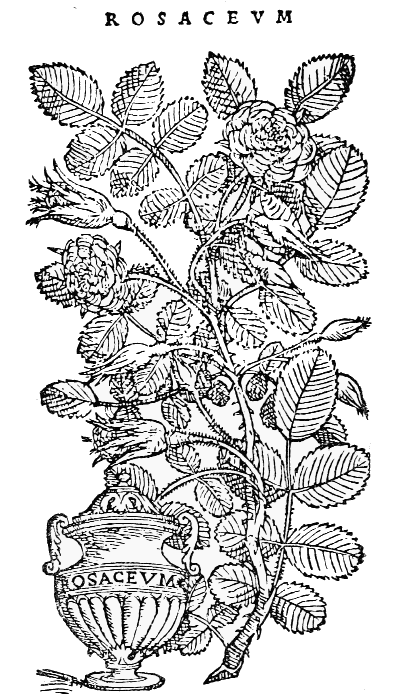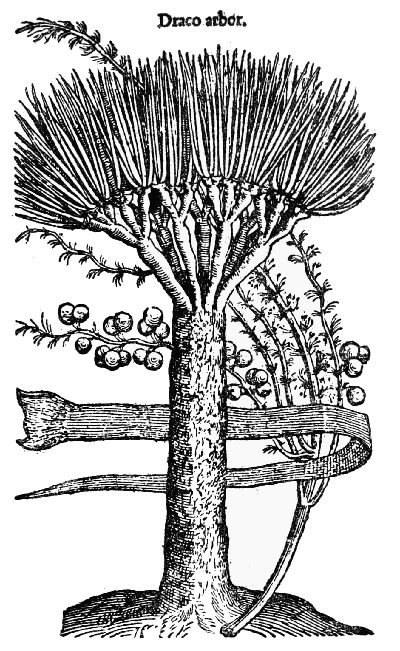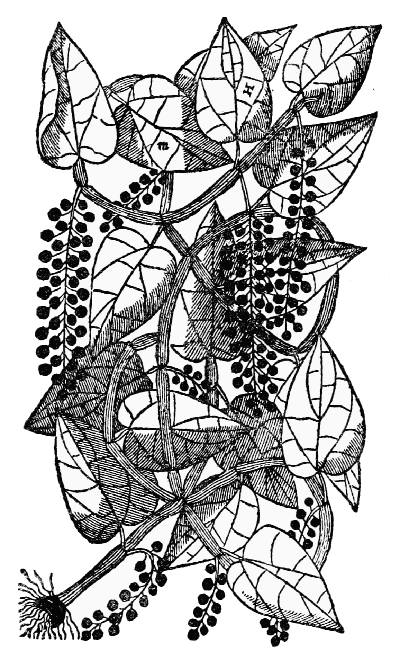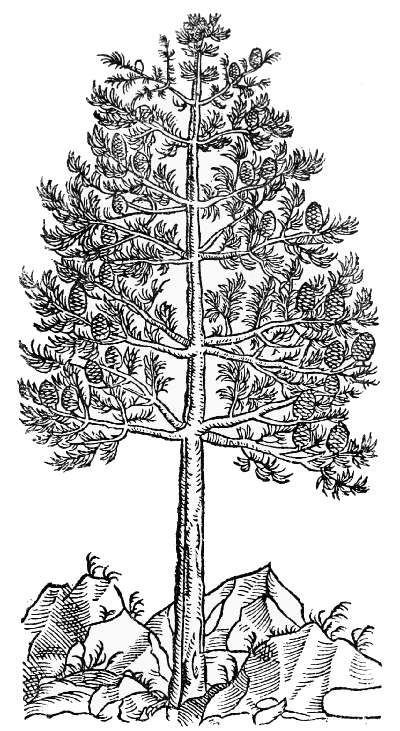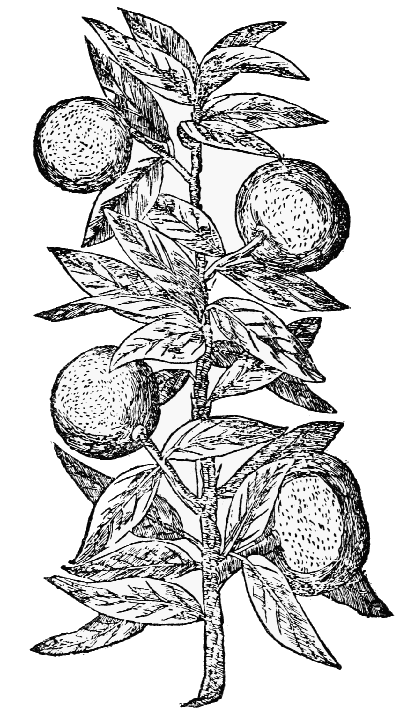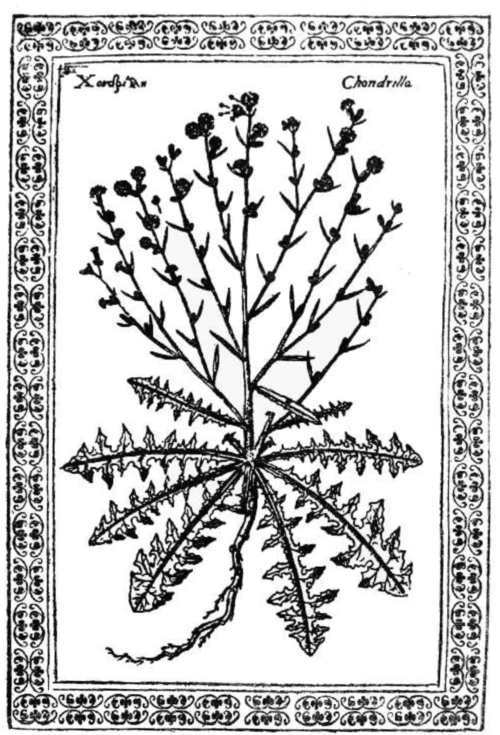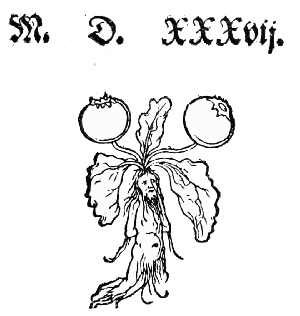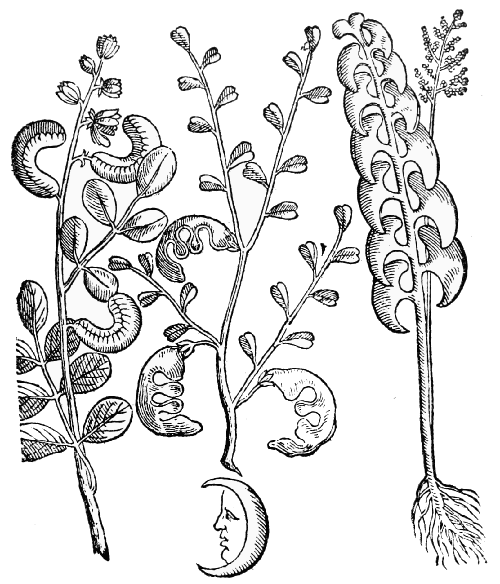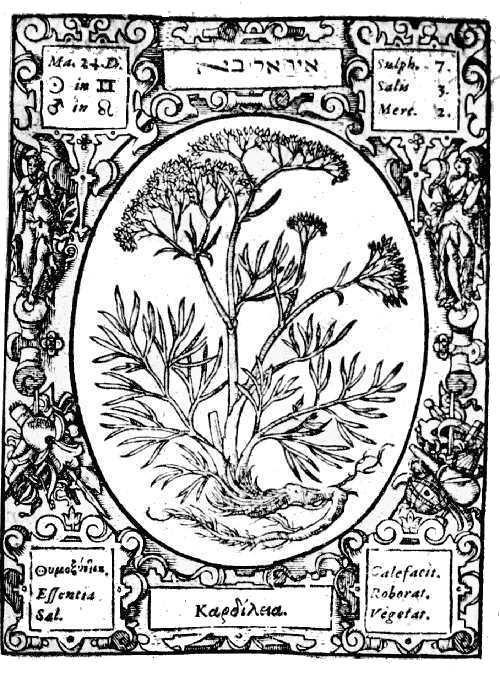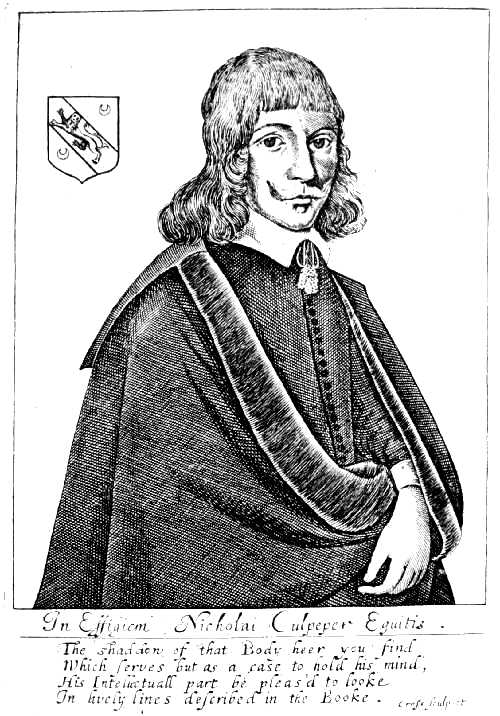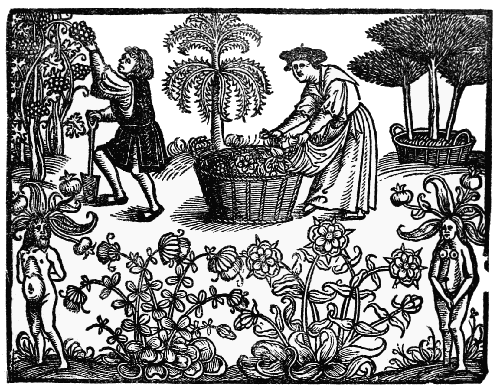.
HERBALS
THEIR ORIGIN AND EVOLUTION
A CHAPTER IN THE HISTORY OF BOTANY
1470-1670
CAMBRIDGE UNIVERSITY PRESS
London: FETTER LANE, E.C.
C. F. CLAY, Manager
Edinburgh: 100, PRINCES STREET
London: WILLIAM WESLEY & SON, 28, ESSEX STREET, STRAND
Berlin: A. ASHER & CO.
Leipzig: F. A. BROCKHAUS
New York: G. P. PUTNAM’S SONS
Bombay and Calcutta: MACMILLAN & CO., Ltd.
All rights reserved
HERBALS
THEIR ORIGIN AND EVOLUTION
A CHAPTER IN THE HISTORY OF BOTANY
1470-1670
BY
AGNES ARBER
(Mrs. E. A. NEWELL ARBER)
D.Sc., F.L.S., FELLOW OF NEWNHAM COLLEGE, CAMBRIDGE
AND OF UNIVERSITY COLLEGE, LONDON
Cambridge:
at the University Press
1912
Cambridge:
PRINTED BY JOHN CLAY, M.A.
AT THE UNIVERSITY PRESS
TO MY FATHER
H. R. ROBERTSON
“Wherefore it maye please your ... gentlenes to take these my labours in good worthe, not according unto their unworthines, but accordinge unto my good mind and will, offering and gevinge them unto you.”
William Turner’s Herbal, 1568.
PREFACE
To add a volume such as the present to the existing multitude of books about books calls for some apology. My excuse must be that many of the best herbals, especially the earlier ones, are not easily accessible, and after experiencing keen delight from them myself, I have felt that some account of these works, in connection with reproductions of typical illustrations, might be of interest to others. In the words of Henry Lyte, the translator of Dodoens, “I thinke it sufficient for any, whom reason may satisfie, by way of answeare to alleage this action and sententious position: Bonum, quo communius, eo melius et præstantius: a good thing the more common it is, the better it is.”
The main object of the present book is to trace in outline the evolution of the printed herbal in Europe between the years 1470 and 1670, primarily from a botanical, and secondarily from an artistic standpoint. The medical aspect, which could only be dealt with satisfactorily by a specialist in that science, I have practically left untouched, as also the gardening literature of the period. Bibliographical information is not given in detail, except in so far as it subserves the main objects of the book. Even within these limitations, the present account is far from being an exhaustive monograph. It aims merely at presenting a general sketch of the history of the herbal during a period of two hundred years. The titles of the principal botanical works, which were published between 1470 and 1670, are given in Appendix I.
The book is founded mainly upon a study of the herbals themselves. My attention was first directed to these works by reading a copy of Lyte’s translation of Dodoens’ Herbal, which happened to come into my hands in 1894, and at once aroused my interest in the subject. I have also drawn freely upon the historical and critical literature dealing with the period under consideration, to which full references will be found in Appendix II. The materials for this work have chiefly been obtained in the Printed Books Department of the British Museum, but I have also made use of a number of other libraries. I owe many thanks to Prof. Seward, F.R.S., who suggested that I should undertake this book, and gave me special facilities for the study of the fine collection of old botanical works in the Botany School, Cambridge. In addition I must record my gratitude to the University Librarian, Mr F. J. H. Jenkinson, M.A., and Mr C. E. Sayle, M.A., of the Cambridge University Library, and also to Dr Stapf, Keeper of the Kew Herbarium and Library. By the kindness of Dr Norman Moore, Harveian Librarian to the Royal College of Physicians, I have had access to that splendid library, and my best thanks are due to him, and to the Assistant-Librarian, Mr Barlow. To the latter I am especially indebted for information on bibliographical points. I have also to thank Mr Knapman of the Pharmaceutical Society, Dr Molhuizen, Keeper of the Manuscripts, University Library, Leyden, and the Librarian of the Teyler Institute, Haarlem, for giving me opportunities for examining the books under their charge.
The great majority of the illustrations are reproduced from photographs taken directly from the originals by Mr W. Tams of Cambridge, to whom I am greatly indebted for the skill and care with which he has overcome the difficulties incidental to photographing from old books, the pages of which are so often wrinkled, discoloured orix worm-eaten. For the use of Plate XVIII, which appeared in Leonardo da Vinci’s Note-Books, I am under obligations to the author, Mr Edward McCurdy, M.A., and to Messrs Duckworth & Co. Text-figs. 7, 18, 77, 78 and 112 are reproduced by the courtesy of the Council of the Bibliographical Society, from papers by the late Dr Payne, to which the references will be found in Appendix II, while, for the use of Text-fig. 108, I am indebted to the Royal Numismatic Society. For permission to utilise the modern facsimile of the famous Dioscorides manuscript of Juliana Anicia, from which Plates I, II, and XV are derived, I have to thank Prof. Dr Josef Ritter von Karabacek, of the k. k. Hofbibliothek at Vienna. In connection with the portraits of herbalists here reproduced, I wish to acknowledge the generous assistance which I have received from Sir Sidney Colvin, formerly Keeper of Prints and Drawings, British Museum.
I would also record my thanks to Mr A. W. Pollard, Secretary of the Bibliographical Society, Prof. Killermann of Regensburg, Signorina Adelaide Marchi of Florence, Mr C. D. Sherborn of the British Museum (Natural History) and Dr B. Daydon Jackson, General Secretary of the Linnean Society, all of whom have kindly given me information of great value. For help in the translation of certain German and Latin texts, I am indebted to Mr E. G. Tucker, B.A., Mr F. A. Scholfield, M.A., and to my brother, Mr D. S. Robertson, M.A., Fellow of Trinity College, Cambridge.
I wish, further, to express my gratitude to my father for advice and suggestions. Without his help, I should scarcely have felt myself competent to discuss the subject from the artistic standpoint. To my husband, also, I owe many thanks for assistance in various directions, more particularly in criticising the manuscript, and in seeing the volume through the press. I am indebted to my sister,x Miss Janet Robertson, for the cover, the design for which is based upon a wood-cut in the Ortus Sanitatis of 1491.
A book of this kind, in the preparation of which many previous works have been laid under contribution, is doubtless open to a certain criticism which William Turner, “the Father of British Botany,” anticipated in the case of his own writings. I think I cannot do better than proffer my excuse in the very words of this sixteenth-century herbalist:
“For some of them will saye, seynge that I graunte that I have gathered this booke of so manye writers, that I offer unto you an heape of other mennis laboures, and nothinge of myne owne,... To whom I aunswere, that if the honye that the bees gather out of so manye floure of herbes, shrubbes, and trees, that are growing in other mennis medowes, feldes and closes: maye justelye be called the bees honye:... So maye I call it that I have learned and gathered of manye good autoures ... my booke.”
AGNES ARBER.
Balfour Laboratory, Cambridge,
26th July, 1912.
CONTENTS
| CHAP. |
|
PAGE |
| I. | The Early History of Botany | |
|
1. Introductory |
1 | |
|
2. Aristotelian Botany |
2 | |
|
3. Medicinal Botany |
6 | |
| II. | The Earliest Printed Herbals (Fifteenth Century) | |
|
1. The Encyclopædia of Bartholomæus Anglicus and ‘The Book of Nature’ |
10 | |
|
2. The ‘Herbarium’ of Apuleius Platonicus |
11 | |
|
3. The Latin ‘Herbarius’ |
16 | |
|
4. The German ‘Herbarius’ and related Works |
18 | |
|
5. The ‘Hortus Sanitatis’ |
25 | |
| III. | The Early History of the Herbal in England | |
|
1. The ‘Herbarium’ of Apuleius Platonicus |
35 | |
|
2. Banckes’ Herbal |
38 | |
|
3. ‘The Grete Herball’ |
40 | |
| IV. | The Botanical Renaissance of the Sixteenth and Seventeenth Centuries | |
|
1. The Herbal in Germany |
47 | |
|
2. The Herbal in the Low Countries |
70 | |
|
3. The Herbal in Italy |
79 | |
|
4. The Herbal in Switzerland |
90 | |
|
5. The Herbal in France |
98 | |
|
6. The Herbal in England |
100 | |
|
7. The Revival of Aristotelian Botany |
116 | |
| V. | The Evolution of the Art of Plant Description | 119 |
| VI. | The Evolution of Plant Classification | 134 |
| VII. | The Evolution of the Art of Botanical Illustration | 154 |
| VIII. | The Doctrine of Signatures, and Astrological Botany | 204 |
| IX. | Conclusions | 221 |
| Appendix I | ||
|
A Chronological List of the Principal Herbals and Related Botanical Works published between 1470 and 1670 |
227 | |
| Appendix II | ||
|
A List, in Alphabetical Order, of the Principal Critical and Historical Works dealing with the Subjects discussed in this Book |
241 | |
| Index | 247 |
LIST OF ILLUSTRATIONS
FRONTISPIECE
Leonhard Fuchs (1501-1566) [Engraving by Speckle in De historia stirpium, 1542]
PLATES
| PLATE |
|
Face page |
| I. |
“Sonchos” [Dioscorides. Codex Aniciæ Julianæ. circa A.D. 500]. Reduced |
4 |
| II. |
“Stratiotes” [Dioscorides. Codex Aniciæ Julianæ. circa A.D. 500]. Reduced |
8 |
| III. |
Wood-cut of Plants [Konrad von Megenberg. Das půch der natur. 1475]. Reduced |
10 |
| IV. |
“Orbicularis” [Herbarium Apuleii Platonici. ? 1484]. (The tint represents colouring, which was probably contemporary) |
12 |
| V. |
“Mandragora” = Mandrake [Herbarium Apuleii Platonici. ? 1484]. (The tint represents colouring, which was probably contemporary) |
34 |
| VI. |
Joachim Camerarius, the younger (1534-1598) [Engraving by Bartholomæus Kilian. Probably between 1650 and 1700. Department of Prints and Drawings, British Museum] |
68 |
| VII. |
Charles de l’Écluse (1526-1609) [Print in the Botany School, Cambridge] |
74 |
| VIII. |
Mathias de l’Obel (1538-1616) [Engraving by François Dellarame. 1615. Department of Prints and Drawings, British Museum] |
78 |
| IX. |
Fabio Colonna (1567-1650) [Ekphrasis. 1606] |
88 |
| X. |
Konrad Gesner (1516-1565) [Print in the Botany School, Cambridge] |
92 |
| XI. |
Gaspard Bauhin (1560-1624) [Theatrum Anatomicum. 1605] |
94 |
| XII. |
John Gerard (1545-1607) [The Herball. 1636] |
108 |
| XIII. |
John Parkinson (1567-1650) [Theatrum botanicum. 1640] |
114 |
| xiiiXIV. |
Andrea Cesalpino (1519-1603) [Drawn by G. Zocchi and engraved by F. Allegrini, 1765, after an old portrait in the Museum of the Botanic Garden at Pisa. Print in the Botany School, Cambridge] |
116 |
| XV. |
“Phasiolos” = Bean [Dioscorides. Codex Aniciæ Julianæ. circa A.D. 500]. Reduced |
154 |
| XVI. |
“Dracontea” [Herbarium Apuleii Platonici. ? 1484]. (The tint represents colouring, which was probably contemporary) |
156 |
| XVII. |
Study of Aquilegia vulgaris L., Columbine [Albrecht Dürer, 1526. Drawing in the Albertina, Vienna]. Reduced |
168 |
| XVIII. |
Study of Ornithogalum umbellatum L., Star of Bethlehem, and other plants [Leonardo da Vinci. 1452-1519. Drawing in the Royal Library, Windsor]. Reduced |
170 |
| XIX. |
“Crocus Byzantinus” and “Crocus Montanus hispan.” [Part of a plate from Crispian de Passe. Hortus Floridus. 1614] |
202 |
| XX. |
“Cervaria fœmina” [Thurneisser. Historia sive Descriptio Plantarum. 1587] |
216 |
| XXI. |
Nicholas Culpeper (1616-1654) [A Physicall Directory. 1649. Engraving by Cross] |
218 |
FIGURES IN THE TEXT1
[The initial letters, which will be found at the beginning of each chapter, are taken from Pierre Belon’s ‘Les Observations de plusieurs singularitez et choses memorables, trouvées en Grece, Asie, Judée, Egypte, Arabie, et autres pays estranges,...Imprimé à Paris par Benoist Prévost.’ 1553.]
| TEXT |
-FIG. |
PAGE |
| 1. |
“Plantago” = Plantain [Herbarium Apuleii Platonici, ? 1484] |
12 |
| 2. |
“Artemisia” [Herbarium Apuleii Platonici, ? 1484] |
13 |
| 3. |
“Lilium” [Herbarius Moguntinus, 1484] |
14 |
| 4. |
“Aristolochia longa” [Herbarius Moguntinus, 1484] |
15 |
| 5. |
“Serpentaria” [Herbarius Moguntinus, 1484] |
16 |
| 6. |
“Brionia” [Arnaldus de Villa Nova, Tractatus de virtutibus herbarum, 1499] |
17 |
| 7. |
“Acorus” = Iris [Herbarius zu Teutsch, Mainz, 1485] |
23 |
| 8. |
“Leopardus” [Ortus Sanitatis, Mainz, 1491] |
25 |
| 9. |
“Daucus” = Carrot [Ortus Sanitatis, Mainz, 1491] |
26 |
| 10. |
“Passer” = Sparrow [Ortus Sanitatis, Mainz, 1491] |
27 |
| 11. |
“Pavo” = Peacock [Ortus Sanitatis, Mainz, 1491] |
27 |
| 12. |
“Arbor vel lignum vite paradisi” [Ortus Sanitatis, Mainz, 1491] |
28 |
| 13. |
“Narcissus” [Ortus Sanitatis, Mainz, 1491] |
29 |
| 14. |
“Bauser vel Bausor” [Ortus Sanitatis, Mainz, 1491] |
30 |
| 15. |
“Panis” = Bread [Ortus Sanitatis, Mainz, 1491] |
31 |
| 16. |
“Ambra” = Amber [Ortus Sanitatis, Mainz, 1491] |
32 |
| 17. |
“Unicornus” [Ortus Sanitatis, Mainz, 1491] |
33 |
| 18. |
A Herbalist’s Garden [Le Jardin de Santé, ?1539] |
34 |
| 19. |
Wood-cut of Plants [Bartholomæus Anglicus, Liber de proprietatibus rerum, Wynkyn de Worde, ? 1495]. Reduced |
37 |
| 20. |
“Yvery”= Ivory [The Grete Herball, 1529] |
42 |
| 21. |
“Nenufar” = Waterlily [The Grete Herball, 1529] |
44 |
| 22. |
“Walwurtz männlin” = Symphytum, Comfrey [Brunfels, Herbarum vivæ eicones, Vol. I. 1530]. Reduced |
48 |
| 23. |
“Helleborus Niger” = Helleborus viridis L., Green Hellebore [Brunfels, Herbarum vivæ eicones, Vol. I.1530]. Reduced |
49 |
| xv24. |
“Synnaw” = Alchemilla, Ladies’ Mantle [Brunfels, Herbarum vivæ eicones, Vol. ii. 1531]. Reduced |
51 |
| 25. |
“Caryophyllata” = Geum, Avens [Brunfels, Herbarum vivæ eicones, Vol. iii. 1540]. Reduced |
52 |
| 26. |
Hieronymus Bock or Tragus (1498-1554) [Kreuter Bůch, 1551] |
53 |
| 27. |
“Erdberen” = Fragaria, Strawberry [Bock, Kreuter Bůch, 1546] |
54 |
| 28. |
“Pimpernuss” = Pistacia, Pistachio-nut [Bock, Kreuter Bůch, 1546] |
56 |
| 29. |
“Tribulus aquaticus” = Trapa natans L., Bull-nut [Bock, De stirpium, 1552] |
57 |
| 30. |
“Brassicæ quartum genus” = Cabbage [Fuchs, De historia stirpium, 1542]. Reduced |
59 |
| 31. |
“Polygonatum latifolium” = Solomon’s Seal [Fuchs, De historia stirpium, 1542]. Reduced |
61 |
| 32. |
“Cucumis turcicus” = Cucurbita maxima Duch., Giant Pumpkin [Fuchs, De historia stirpium, 1542]. Reduced |
63 |
| 33. |
“Erdöpffel” = Ranunculus ficaria L., Lesser Celandine [Rhodion, Kreutterbůch, 1533] |
65 |
| 34. |
“Ocimoides fruticosum” = Silene fruticosa L. [Camerarius, Hortus medicus, 1588] |
67 |
| 35. |
“Palma” = Seedlings of Phœnix dactylifera L., Date Palm [Camerarius, Hortus medicus, 1588] |
69 |
| 36. |
Rembert Dodoens (1517-1585) [A Niewe Herball. Translated by Lyte, 1578] |
71 |
| 37. |
“Capparis” = Capparis ovata L. [Dodoens, Pemptades, 1583] |
73 |
| 38. |
“Anemone trifolia” [Dodoens, Pemptades, 1583] |
75 |
| 39. |
“Lacryma Iob” = Coix lachryma-Jobi L., Job’s Tears [de l’Écluse, Rariorum ... per Hispanias, 1576] |
77 |
| 40. |
Pierandrea Mattioli (1501-1577) [Engraving by Philippe Galle, Virorum Doctorum Effigies, Antwerp, 1572] |
80 |
| 41. |
“Pyra” = Pyrus communis L., Pear [Mattioli, Commentarii, 1560] |
81 |
| 42. |
“Avena” = Oats [Mattioli, Commentarii, 1560] |
82 |
| 43. |
“Trifolium acetosum” = Oxalis [Mattioli, Commentarii, 1565]. Reduced |
83 |
| 44. |
“Malus” = Pyrus malus L., Apple [Mattioli, Commentarii, 1565]. Reduced |
84 |
| 45. |
“Arbor Malenconico” or “Arbor tristis” = Tree of Sorrow [Durante, Herbario Nuovo, 1585] |
86 |
| 46. |
“Apocynum” [Colonna, Phytobasanos, 1592] |
87 |
| 47. |
“Kalli” = Salicornia, Glasswort [Prospero Alpino, De plantis Ægypti, 1592] |
89 |
| 48. |
“Lachryma Iob” = Coix lachryma-Jobi L., Job’s Tears [Simler, Vita Conradi Gesneri, 1566] |
91 |
| 49. |
“Solanum tuberosum esculentum” = Potato [Bauhin, Prodromos, 1620] |
95 |
| xvi50. |
Jacques d’Aléchamps (1513-1588) [Wood-cut, circa 1600, Department of Prints and Drawings, British Museum].Enlarged |
97 |
| 51. |
“Ornithogalum magnum” [d’Aléchamps, Historia generalis plantarum, 1586] |
99 |
| 52. |
“Tabaco” = Nicotiana, Tobacco [Monardes, Joyfull newes out of the newe founde worlde, 1580] |
105 |
| 53. |
“Reubarbe” = Centaurea rhaponticum L. [Lyte, A Niewe Herball, 1578] |
107 |
| 54. |
“The breede of Barnakles” [Gerard, The Herball, 1597] |
111 |
| 55. |
“Barberry” = Berberis [Part of a large wood-cut from Parkinson, Paradisus Terrestris, 1629] |
114 |
| 56. |
“Cardamomum” = (?) Solanum dulcamara L., Bittersweet [Ortus Sanitatis, Mainz, 1491] |
121 |
| 57. |
“Pionia” = Peony [Arnaldus de Villa Nova, Tractatus de virtutibus herbarum, 1499] |
123 |
| 58. |
“Petasites” = Butterbur [Fuchs, De historia stirpium, 1542]. Reduced |
126 |
| 59. |
“Sedum majus” [de l’Écluse, Rariorum per Hispanias, 1576] |
128 |
| 60. |
“Battata Virginiana” = Solanum tuberosum L., Potato [Gerard, The Herball, 1597] |
129 |
| 61. |
“Rose Ribwoorte” = an abnormal Plantain [Gerard, The Herball, 1597] |
131 |
| 62. |
“Beta Cretica semine aculeato” [Bauhin, Prodromos, 1620] |
132 |
| 63. |
“Carui” [Ortus Sanitatis, Mainz, 1491] |
135 |
| 64. |
“Buglossa” [Ortus Sanitatis, Mainz, 1491] |
137 |
| 65. |
“Nenufar” = Waterlily [Arnaldus de Villa Nova, Tractatus de virtutibus herbarum, 1499] |
139 |
| 66. |
“Nenuphar” = Nymphæa alba L., White Waterlily [Brunfels, Herbarum vivæ eicones, Vol. I. 1530]. Reduced |
141 |
| 67. |
“Gele Plompen” = Nuphar luteum Sm., Yellow Waterlily [de l’Obel, Kruydtbœck, 1581] |
142 |
| 68. |
“Ninfea” = Waterlily [Durante, Herbario Nuovo, 1585] |
144 |
| 69. |
“Tussilago” = Tussilago farfara L., Coltsfoot [Fuchs, De historia stirpium, 1542]. Reduced |
147 |
| 70. |
“Plantago major” = Plantain [Fuchs, De historia stirpium, 1542]. Reduced |
149 |
| 71. |
“Althæa Thuringica” = Lavatera thuringiaca L. [Camerarius, Hortus medicus, 1588] |
150 |
| 72. |
“Pulsatilla” = Anemone pulsatilla L., Pasque-flower [Camerarius, De plantis Epitome Matthioli, 1586] |
152 |
| 73. |
“Brionia” [Herbarius Moguntinus, 1484] |
158 |
| 74. |
“Ireos vel Iris” [Arnaldus de Villa Nova, Tractatus de virtutibus herbarum, 1499] |
159 |
| 75. |
“Capillus Veneris” = Maidenhair Fern [Arnaldus de Villa Nova, Tractatus de virtutibus herbarum, 1499] |
160 |
| xvii76. |
“Cuscuta” = Dodder [Arnaldus de Villa Nova, Tractatus de virtutibus herbarum, 1499] |
161 |
| 77. |
“Cuscuta” = Dodder [Herbarius zu Teutsch, Mainz, 1485] |
163 |
| 78. |
“Alkekengi” = Physalis, Winter Cherry [Herbarius zu Teutsch, Mainz, 1485] |
164 |
| 79. |
“Alkekengi” = Physalis, Winter Cherry [Ortus Sanitatis, Mainz, 1491] |
165 |
| 80. |
“Cuscuta” = Dodder [Ortus Sanitatis, Mainz, 1491] |
166 |
| 81. |
“Botris” [Ortus Sanitatis, Mainz, 1491] |
167 |
| 82. |
“Asarum” = Asarabacca [Brunfels, Herbarum vivæ eicones, Vol. I. 1530]. Reduced |
169 |
| 83. |
“Kuchenschell” = Anemone pulsatilla L., Pasque-flower [Brunfels, Herbarum vivæ eicones, Vol. I. 1530] |
171 |
| 84. |
“Lappa” = Arctium, Burdock [Brunfels, Herbarum vivæ eicones, Vol. II. 1531]. Reduced |
173 |
| 85. |
“Scolopendria” = Hart’s-tongue Fern [Rhodion, Kreutterbůch, 1533] |
174 |
| 86. |
“Dipsacus albus” = Teasle [Fuchs, De historia stirpium, 1542]. Reduced |
176 |
| 87. |
“Apios” = Lathyrus tuberosus L., Earth-nut Pea [Fuchs, De historia stirpium, 1542]. Reduced |
178 |
| 88. |
“Arum” = Arum maculatum L., Wild Arum [Fuchs, De historia stirpium, 1542]. Reduced |
179 |
| 89. |
The Draughtsmen and Engraver employed by Leonhard Fuchs [De historia stirpium, 1542]. Reduced |
181 |
| 90. |
“Wintergrün” = Pyrola, Wintergreen [Bock, Kreuter Bůch, 1546] |
182 |
| 91. |
“Rautten” = Botrychium, Moonwort [Bock, Kreuter Bůch, 1546] |
183 |
| 92. |
“Castanum nuss” = Castanea, Chestnut [Bock, Kreuter Bůch, 1546] |
184 |
| 93. |
“Fungi” = Toadstools [Mattioli, Commentarii, 1560]. Reduced |
185 |
| 94. |
“Rosaceum” [Mattioli, Commentarii, 1560]. Reduced |
186 |
| 95. |
“Suber primus” [Mattioli, Commentarii, 1565]. Reduced |
187 |
| 96. |
“Tragorchis” = Orchis hircina L., Lizard Orchis [Dodoens, Pemptades, 1583] |
188 |
| 97. |
“Aconitum luteum minus” = Eranthis hiemalis L., Winter Aconite [Dodoens, Pemptades, 1583] |
189 |
| 98. |
“Draco arbor” = Dracæna, Dragon Tree [de l’Écluse, Rariorum ... per Hispanias, 1576] |
191 |
| 99. |
“Cyclaminus” [Camerarius, De plantis Epitome ... Matthioli, 1586] |
192 |
| 100. |
“Rosa Hierichuntica” = Anastatica hierochuntica L., Rose of Jericho [Camerarius, Hortus medicus, 1588] |
193 |
| 101. |
“Piper Nigrum” = Pepper [d’Aléchamps, Historia generalis plantarum, Vol. II. 1587] |
194 |
| 102. |
“Cedrus” = Cedar [Belon, De arboribus, 1553] |
195 |
| 103. |
“Lentisco del Peru” = Pistacia lentiscus L., Mastic Tree [Durante, Herbario Nuovo, 1585] |
197 |
| xviii104. |
“Mala Aurantia Chinensia” = Orange [Aldrovandi, Dendrologia, 1667]. Reduced |
198 |
| 105. |
“Chondrilla” [Colonna, Phytobasanos, 1592] |
201 |
| 106. |
“Alkekengi” = Physalis, Winter Cherry [Blankaart, Neder-landschen Herbarius, 1698] |
203 |
| 107. |
The Male Mandrake [Brunfels, Contrafayt Kreüterbuch, Ander Teyl, 1537] |
205 |
| 108. |
Theophrastus von Hohenheim, called Paracelsus (1493-1541) [From a medal, now in the British Museum. See F. W. Weber, Appendix II] |
206 |
| 109. |
Herbs of the Scorpion [Porta, Phytognomonica, 1591] |
209 |
| 110. |
Lunar Herbs [Porta, Phytognomonica, 1591] |
213 |
| 111. |
Astrological Diagram relating to the gathering of “Cervaria fœmina” [Thurneisser, Historia sive Descriptio Plantarum, 1587] |
217 |
| 112. |
Wood-cut from the Title-page of the Grete Herball, 1526. Reduced |
223 |
| 113. |
A Herbalist’s Garden and Store-room [Das Kreüterbůch oder Herbarius. Printed by Heinrich Stayner, Augsburg, 1534] |
225 |
CHAPTER I
THE EARLY HISTORY OF BOTANY
1. Introductory.
 N the present book, the special subject treated is the evolution of the printed herbal, between the years 1470 and 1670, but it is impossible to arrive at clear ideas on this subject without some knowledge of the earlier stages in the history of Botany. The first chapter will therefore be devoted to the briefest possible sketch of the progress of Botany before the invention of printing, in order that the position occupied by the Herbal in the history of the science may be realised in its true perspective.
N the present book, the special subject treated is the evolution of the printed herbal, between the years 1470 and 1670, but it is impossible to arrive at clear ideas on this subject without some knowledge of the earlier stages in the history of Botany. The first chapter will therefore be devoted to the briefest possible sketch of the progress of Botany before the invention of printing, in order that the position occupied by the Herbal in the history of the science may be realised in its true perspective.
From the very beginning of its existence, the study of plants has been approached from two widely separated standpoints—the philosophical and the utilitarian. Regarded from the first point of view, Botany stands on its own merits, as an integral branch of natural philosophy, whereas, from the second, it is merely a by-product of medicine or agriculture. This distinction, however, is a somewhat arbitrary one; the more philosophical of botanists have not disdained at times to consider the uses of herbs, and those who entered upon the subject, with a purely medical intention, have often become students of plant life for its own sake. At different periods in the evolution of the science, one or other aspect has predominated, but from classical times onwards, it is possible to trace the development of these two distinct lines of inquiry, which have sometimes2 converged, but more often pursued parallel and unconnected paths.
Botany as a branch of philosophy may be said to have owed its inception to the wonderful mental activity of the finest period of Greek culture. It was at this time that the nature and life of plants first came definitely within the scope of inquiry and speculation.
2. Aristotelian Botany.
Aristotle, Plato’s pupil, concerned himself with the whole field of science, and his influence, especially during the Middle Ages, had a most profound effect on European thought. The greater part of his botanical writings, which belong to the fourth century before Christ, are unfortunately lost, but, from such fragments as remain, it is clear that his interest in plants was of an abstract nature. He held that all living bodies, those of plants as well as of animals, are organs of the soul, through which they exist. It was broad, general speculations, such as these, which chiefly attracted him. He asks why a grain of corn gives rise in its turn to a grain of corn and not to an olive, thus raising a plexus of problems, which, despite the progress of modern science, still baffle the acutest thinkers of the present day.
Aristotle bequeathed his library to his pupil Theophrastus, whom he named as his successor. Theophrastus was well fitted to carry on the traditions of the school, since he had, in earlier years, studied under Plato himself. He produced a ‘History of Plants’ in which Botany is treated in a somewhat more concrete and definite fashion than is the case in Aristotle’s writings. Theophrastus mentions about 450 plants, whereas the number of species in Greece known at the present day is at least 3000. His descriptions, with few exceptions, are meagre, and the identification of the plants to which they refer is a matter of extreme difficulty.
In various points of observation, Theophrastus was in advance of his time. He noticed, for instance, the distinction between centripetal and centrifugal inflorescences—a distinction which does not seem to have again attracted the attention of botanists until the sixteenth century. He3 was interested in the germination of seeds, and was aware, though somewhat dimly, of the essential differences between the seedling of the Bean and that of the Wheat.
In the Middle Ages, knowledge of Aristotelian botany was brought into western Europe at two different periods,—the ninth and the thirteenth centuries. In the ninth century of the Christian era, Rhabanus Magnentius Maurus, a German writer, compiled an encyclopædia which contained information about plants, indirectly derived from the writings of Theophrastus. Rhabanus actually based his work upon the writings of Isidor of Seville, who lived in the sixth and seventh centuries—Isidor having obtained his botanical data from Pliny, whose knowledge of plants was in turn borrowed from Theophrastus.
The renewal of Aristotelian learning in the thirteenth century was derived less directly from classical writings than was the case with the earlier revival. From the time of Alexander onwards, various Greek schools had been founded in Syria. These schools were largely concerned with the teachings of Aristotle, which were thence handed on into Persia, Arabia and other countries. The Arabs translated the Syriac versions of Greek writers into their own language, and their physicians and philosophers kept alive the knowledge of science during the dark ages when Greece and Rome had ceased to be the homes of learning, and while culture was still in its infancy in Germany, France and England. The Arabic translations of classical writings were eventually rendered into Latin, or even sometimes into Greek again, and in this guise found their way to western Europe.
Amongst other books, which suffered these successive metamorphoses, was the pseudo-Aristotelian botany of Nicolaus of Damascus, which has acquired importance in the annals of western science, because it formed the basis of the botanical work of Albertus Magnus.
Albert of Bollstadt (1193-1280), Bishop of Ratisbon, was a famous scholastic philosopher. He was esteemed one of the most learned men of his age, and was called “Albertus Magnus” during his life-time, the title being conferred on him by the unanimous consent of the schools. The “Angelic Doctor,” St Thomas Aquinas, became one of his pupils.4 According to legendary lore the name of Albertus would have been unknown in science, but for divine intervention, which miraculously affected his career. As a boy, tradition says that he was singularly lacking in intelligence, so much so that it was feared that he would be compelled to abandon the hope of entering monastic life, since he seemed incapable even of the limited acquirements necessary. However, one night, the Blessed Virgin, touched by his fervour and piety, appeared before him in glory, and asked whether he would rather excel in philosophy or in theology. Albertus without hesitation chose philosophy. The Virgin granted his desire, but, being inwardly wounded at his choice, she added that, because he had preferred profane to divine knowledge, he should sink back, before the end of his life, into his pristine state of stupidity. According to the legend, this came to pass. Three years before his death he was suddenly struck down, in the presence of his students, and never regained his mental powers.
The botanical work of Albertus forms only a small fraction of his writings, but it is with that part alone that we are here concerned. As already mentioned, his knowledge of botany was based upon a mediæval Latin work, which he reverenced as Aristotle’s, but which is now attributed to Nicolaus Damascenus, who was, however, a follower of Aristotle and Theophrastus. Although Albertus undoubtedly drew his botanical inspiration from this book, a large proportion of his writings on the subject were original.
The ideas of Albertus were in many ways curiously advanced, especially in the suggestions which he gives as to the classification of plants, and in his observations of detailed structure in certain flowers. We shall return to his writings in future chapters dealing with these subjects. It will suffice now to mention his remarkable instinct for morphology, in which he was probably unsurpassed during the next four hundred years. He points out, for instance, that, in the vine, a tendril sometimes occurs in place of a bunch of grapes, and from this he concludes that the tendril is to be interpreted as a bunch of grapes incompletely developed. He distinguishes also between thorns and prickles, and realises that the former are stem structures, and the latter merely surface organs.
Albertus seems to have had a fine scorn for that branch of the science now known as Systematic Botany. He considered that to catalogue all the species was too vast and detailed a task, and one altogether unsuited to the philosopher. However, in his Sixth Book he so far unbends as to give descriptions of a number of plants.
As regards abstract problems, the views of Albertus on plant life may be summed up as follows. The plant is a living being, and its life principle is the vegetable soul, whose function is limited to nourishment, growth and reproduction—feeling, desire, sleep, and sexuality, properly so called, being unknown in the plant world.
Albertus was troubled by many subtle problems connected with the souls of plants, such questions, for instance, as whether in the case of the material union of two individuals, such as the ivy and its supporting tree, their souls also united. Like Theophrastus, and other early writers, Albertus held the theory that species were mutable, and illustrated this view by pointing out that cultivated plants might run wild and become degenerate, while wild plants might be domesticated. Some of his ideas, however, on the possibility of changes from one species to another, were quite baseless. He stated, for instance, that, if a wood of oak or beech were razed to the ground, an actual transformation took place, aspens and poplars springing up in place of the previously existing trees.
The temperate tone of the remarks made by Albertus on the medical virtues of plants contrasts favourably with the puerilities of many later writers. Much of the criticism from which he has suffered at various times has been, in reality, directed against a book called ‘De virtutibus herbarum,’ the authorship of which was quite erroneously attributed to him. We shall refer to this work again in Chapter VIII.
After the time of Albertus, no great student of Aristotelian botany arose before Andrea Cesalpino, whose writings, which belong to the end of the sixteenth century, will be considered in a later chapter. The work of Cesalpino had great qualities, but, curiously enough, it had little influence on the science of his time. He may be regarded as perhaps the last important representative of Aristotelian botany.
3. Medicinal Botany.
With the Revival of Learning, the speculative botany of the ancients began to lose its hold upon thinking men. This may be attributed to the curious lack of vitality, and the absence of the power of active development, manifested in this aspect of the subject since its initiation at the hands of Aristotle. It had proved comparatively barren, because, though the minds which engaged in it were among the finest that have ever been concerned with the science, the basis of observed fact was inadequate in quality and quantity to sustain the philosophical superstructure built upon it. It might have been supposed a priori that accurate observation of natural phenomena needed a less highly evolved type of mind than that required to cope with metaphysical considerations, and hence that, in the development of any science, the epoch of observation would have preceded the epoch of speculation. In actual fact, however, the reverse appears to have been the case. The power of scientific observation seems to have lagged many centuries behind the power of reasoning, and to have reached its maturity at least two thousand years later.
Aristotle and Theophrastus arrived by the subtlest mental processes at a certain attitude towards the universe, and at certain ideas concerning the nature of things. They attempted a direct advance in scientific thought by extending these conceptions to include the plant world. It was an heroic effort, but one which could not ultimately form a basis for continued progress, because, in its inception, preconceived ideas had come first, and the facts of Nature second. It seems to be almost a law of thought, that it is the indirect advances which in the end prove to be the most fertile. The progress of a science, like that of a sailing boat, more often proceeds by means of “tacking” than by following a direct course.
In the case of botany, the path which was destined to lead furthest in the end was the apparently unpromising one of medicine. Various plants from very early times had been used as healing agents, and it became necessary to study them in detail, simply in order to discriminate the kinds employed for different purposes. It was from this7 purely utilitarian beginning that systematic botany for the most part originated. As we shall show in later chapters, nearly all the herbalists whose work is discussed in the present volume were medical men. The necessity for some means of recognising accurately the individual species of medicinal plants led in time to a sounder and more exact knowledge of their morphology than had ever been acquired under the influence of thinkers such as Albertus Magnus, who regarded with some contempt the idea of becoming acquainted in detail with the countless forms of plant life.
The mass of observations relating to herbs and flowers, accumulated during a period of many centuries, largely for medicinal purposes, is to-day serving as the basis for far-reaching biological theories, which could never have arisen without such a foundation.
It is not systematic botany alone that we owe in the first instance to medicine. Nehemiah Grew (1641-1712), one of the founders of the science of plant anatomy, was led to embark upon this subject because his anatomical studies as a physician suggested to him that plants, like animals, probably possessed an internal structure worthy of investigation, since they were the work of the same Creator.
In Ancient Greece there was considerable traffic in medicinal plants. The herbalists2 and druggists3 who made a regular business of collecting, preparing and selling them, do not appear however to have been held in good repute. Lucian makes Hercules address Æsculapius as “a root-digger and a wandering quack4.”
The herbalists seem to have attempted to keep their business select by fencing it about with all manner of superstitions, most of which have for their moral that herb-collecting is too dangerous an occupation for the uninitiated. Theophrastus draws attention to the absurdity of some of the root-diggers’ directions for gathering medicinal plants. For instance he quotes with ridicule the idea that the Peony should be gathered at night, since, if the fruit is collected in the daytime, and a wood-pecker happens to witness the act, the eyes of the herbalist are endangered. He also points out that it is folly to suppose that an offering 8of a honey-cake must be made when Iris fœtidissima is rooted up, or to believe that if an eagle comes near when Hellebore is being collected, anyone who is engaged in the work is fated to die within the year.
The herbalists’ knowledge of plants must have been in the first place transmitted from generation to generation entirely by word of mouth, but as time went on, written records began to replace the oral tradition. The earliest extant European work dealing with medicinal plants is the famous Materia Medica of Dioscorides, which was accepted as an almost infallible authority as late as the Renaissance period.
Dioscorides Anazarbeus was a medical man who probably flourished in the first century of the Christian era, in the time of Nero and Vespasian. Tradition has, however, sometimes assigned to him the post of physician to Antony and Cleopatra. His native land was Asia Minor, but he appears to have travelled widely. In his Materia Medica he described about five hundred plants, with some attempt at an orderly scheme, though, naturally, the result is seldom successful when judged by our modern standards of classification. The actual descriptions of the plants are very slight, and it is only those with particularly salient characteristics which can be recognised with any ease. Careful research on the part of later writers has however led to the identification of a number of the plants to which he refers.
There is a famous manuscript of Dioscorides at Vienna, which is said to have been copied at the expense of Juliana Anicia, the daughter of the Emperor Flavius Anicius, about the end of the fifth, or the beginning of the sixth century. The character of the script settles the age within narrow limits. Juliana lived into the reign of Justinian, and was renowned for her ardent Christian faith, and for the churches which she built. The manuscript which bears her name is illustrated by a number of drawings, which are in some cases remarkably beautiful, and very naturalistic. A facsimile reproduction of this manuscript was published in 1906, and it is thus rendered accessible to students. Examples of the figures are shown on a reduced scale in Plates I, II and XV.
The botanists of the Renaissance devoted a great deal of time and energy to the consideration of the writings of Dioscorides. The chief of the many commentators who dealt with the subject were Matthiolus, Ruellius and Amatus Lusitanus, and a discussion of the botany of Dioscorides formed an integral part of almost every sixteenth-century herbal.
One of the contemporaries of Dioscorides, Gaius Plinius Secundus, commonly called the Elder Pliny, should perhaps be mentioned at this point, although he was not a physician, nor does he deserve the name of a philosopher. In the course of his ‘Natural History,’ which is an encyclopædic account of the knowledge of his time, he treats of the vegetable world. He refers to a far larger number of plants than Dioscorides, probably because the latter confined himself to those which were of importance from a medicinal point of view, whereas Pliny mentioned indiscriminately any plant to which he found a reference in any previous book. Pliny’s work was chiefly of the nature of a compilation, and indeed it would scarcely be reasonable to expect much original observation of nature from a man who was so devoted to books that it was recorded of him that he considered even a walk to be a waste of time!
The writings of the classical authors, especially Theophrastus and Dioscorides, dominated European botany completely until, in the sixteenth century, other influences began to make themselves felt. As we shall see in the following chapter, the earliest printed herbals adhered closely to the classical tradition.
CHAPTER II
THE EARLIEST PRINTED HERBALS
(Fifteenth Century)
1. The Encyclopædia of Bartholomæus Anglicus and ‘The Book of Nature.’
 FTER the invention of printing, a very active period of book production followed, during which many works, which had previously passed a more or less lengthy existence in manuscript, were put into circulation in print, contemporaneously with books actually written at the time. The result is that a number of the “incunabula,” as printed books of the fifteenth century are technically called, are far more ancient, as regards the matter which they contain, than the date of their publication would seem to suggest.
FTER the invention of printing, a very active period of book production followed, during which many works, which had previously passed a more or less lengthy existence in manuscript, were put into circulation in print, contemporaneously with books actually written at the time. The result is that a number of the “incunabula,” as printed books of the fifteenth century are technically called, are far more ancient, as regards the matter which they contain, than the date of their publication would seem to suggest.
This characteristic is illustrated in the Encyclopædia of Bartholomæus Anglicus, and in Konrad von Megenberg’s ‘Das půch der natur,’ which were perhaps the earliest printed books containing strictly botanical information. The former work, which was first printed about 1470, was compiled by a monk, sometimes called Bartholomew de Glanville, who flourished in the thirteenth century. The title by which it is generally known is ‘Liber de proprietatibus rerum.’ One of the sections of which it is composed is concerned with an account of a large number of trees and herbs, arranged in alphabetical order, and is chiefly occupied with their medicinal properties. It also 11includes some theoretical considerations about plants, on Aristotelian lines. An English translation, which was printed by Wynkyn de Worde before the end of the fifteenth century, is interesting as containing the very primitive botanical wood-cut reproduced in Text-fig. 19.
‘Das půch der natur’ is slightly later as regards the date of publication, having been printed by Hanns Bämler at Augsburg in 1475. It seems to have been very popular, for it passed through six or seven editions before the end of the fifteenth century. A very large number of manuscripts of ‘The Book of Nature’ exist, as many as eighteen being preserved in the Vienna Library and seventeen at Munich. The text is a compilation from old Latin writings, and is said to have been translated into German as early as 1349. The portion dealing with plants consists of an account of the virtues of eighty-nine herbs with their Latin and German names. The chief interest of the work, from our present point of view, lies in the fact that it contains the earliest known botanical wood engraving (Plate III). We shall return to this subject in Chapter VII.
2. The Herbarium of Apuleius Platonicus.
Another very early book based on classical writings, especially those of Dioscorides and Pliny, was the ‘Herbarium’ of Apuleius Platonicus. This little Latin work is among the earliest to which the term “Herbal” is generally applied. A herbal has been defined as a book containing the names and descriptions of herbs, or of plants in general, with their properties and virtues. The word is believed to have been derived from a mediæval Latin adjective “herbalis,” the substantive “liber” being understood. It is thus exactly comparable in origin with the word “manual” in the sense of a hand-book.
Four early printed editions of the Herbal of Apuleius Platonicus are known, all of which appear to have been based on different manuscripts. The earliest was published in Rome late in the fifteenth century, from a manuscript discovered by Joh. Philippus de Lignamine, physician to Pope Sixtus IV. Nothing is definitely known concerning the author, but it is conjectured that he was a native of12 Africa, and that his book may date from the fifth century, or possibly even the fourth. The work undoubtedly had a career of many centuries in manuscript before it was printed.
Various extant manuscripts of the Herbarium are illustrated with coloured drawings of the crudest description, which are found on comparison to be identical in many different examples, and to have been reproduced, in a degraded form, when the book was printed. The original figures, from which the drawings in the different manuscripts were copied, must date back to very early times. They probably represent, as Dr Payne has pointed out, a school of botanical draughtsmanship derived from late Roman art.
Plate IV
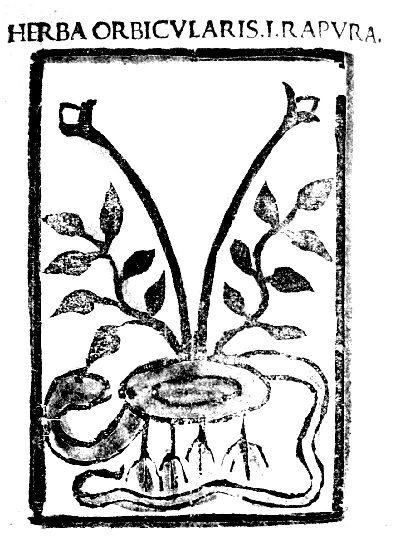
‘Orbicularis’ [Herbarium Apuleii Platonici, ? 1484]. The tint represents colouring, which was probably contemporary.
These illustrations, some of which are reproduced in Plates IV, V and XVI, and Text-figs. 1 and 2, will be discussed in greater detail in Chapter VII. One of their peculiarities is that, if a herb has the power of healing the bite or sting of any animal, that animal is drawn with the plant on the same block.
Soon after the appearance in Italy of the earliest printed editions of the Herbarium of Apuleius Platonicus, three works of great importance were published at Mainz in Germany. These were the Latin ‘Herbarius’ (1484), the German ‘Herbarius’ (1485), and derived from the latter, the14 ‘Hortus Sanitatis’ (1491). The Latin and the German Herbarius, together with the Herbarium of Apuleius Platonicus, may be regarded as the doyens amongst printed herbals. All three seem to have been largely based upon pre-existing manuscripts, representing a tradition of great antiquity.
The various forms of the Latin and German Herbarius, and of the Hortus Sanitatis are described under many titles, and the unravelling of the various editions is a matter of great difficulty. In the fifteenth century, before copyright existed, as soon as a popular work was published, pirated editions and translations sprang into existence. In the case of the German Herbarius, a new edition was printed at Augsburg only a few months after the appearance of the original at Mainz. Some such editions were dated, and15 some undated, and the sources from which they were derived were seldom acknowledged.
The passage of the earliest printed books through the press was naturally extremely slow, as compared with the rapid production of the present day. The result was that the printer had leisure to make occasional alterations, so that different copies belonging actually to the same edition sometimes show slight variations. The bibliographer has thus to deal with an additional element of confusion.
As far as the works now under consideration are concerned, however, much of the obscurity has been removed by the late Dr Payne, to whom we owe a very lucid memoir on the various editions of the Latin and German Herbarius and the Hortus Sanitatis, based in part upon the researches of Dr Ludwig Choulant. Free use has been made of his account in the present chapter.
3. The Latin Herbarius.
The work to which we may refer for convenience as the Latin Herbarius is also known under many other titles—‘Herbarius in Latino,’ ‘Aggregator de Simplicibus,’ ‘Herbarius Moguntinus,’ ‘Herbarius Patavinus,’ etc. It was originally printed at Mainz by Peter Schöffer in 1484, in the form of a small quarto. It is interesting to recall that the earliest specimen of printing from movable type known to exist was produced in the same town thirty years before.
Other early editions and translations of the Herbarius appeared in Bavaria, the Low Countries, Italy, and probably also in France. The work, like most of the early herbals, was anonymous, and was a compilation from mediæval writers, and from certain classical and Arabian authors. It seems to have no connection with the Herbarium of Apuleius, which is nowhere cited. The majority of the authorities quoted wrote before 1300 A.D. and no author is mentioned who might not have been17 known to a writer about the middle of the fourteenth century, that is to say, at least a hundred years before the Herbarius was published. It is quite possible that the work was not written at the time it was printed, but may have had a previous career in manuscript.
The wood-blocks of the first German edition are bold and decorative, but as a rule show little attempt at realism (Text-figs. 3, 4, 5 and 73). A different and better set of figures were used in Italy to illustrate the text (Text-figs. 6, 57, 65, 74, 75, 76). The authorship of this version of the Herbarius is sometimes erroneously attributed to Arnold de Nova Villa, a physician of the thirteenth century, a18 mistake which arose through the conspicuous citation of his name in the preface to the Venetian editions.
The descriptions and figures of the herbs are arranged alphabetically. All the plants discussed were natives of Germany or in cultivation there, and the object of the work seems to have been to help the reader to the use of cheap and easily obtained remedies, in cases of illness or accident.
4. The German Herbarius and related Works.
Of even greater importance than the Latin Herbarius is the German Herbarius or ‘Herbarius zu Teutsch,’ sometimes also called the German Ortus Sanitatis, or the Smaller Ortus. This folio, which was the foundation of the later works called Hortus (or Ortus) Sanitatis, appeared at Mainz, also from the printing press of Peter Schöffer in 1485, the year following the publication of the Latin Herbarius. It has been mistakenly regarded by some authors as a mere translation of the latter. However, the two books are neither the same in the text nor in the illustrations. The German Herbarius appears to be an independent work except as regards the third part of the book—the index of drugs according to their uses—which may owe something to the Latin Herbarius.
It seems from the preface that the originator of the book was a rich man, who had travelled in the east, and that the medical portion was compiled under his direction by a physician. The latter was probably Dr Johann von Cube, who was town physician of Frankfort at the end of the fifteenth century.
The preface to the Herbarius zu Teutsch begins with the words, “Offt und vil habe ich by mir selbst betracht die wundersam werck des schepfers der natuer.” Similar words are found in all the different German editions, and in the later Hortus Sanitatis they are translated into Latin. The preface reveals so clearly and so delightfully the spirit in which the work was undertaken that it seems worth while to translate it almost in extenso.
It is impossible, however, to grasp the medical ideas characteristic of the earlier herbals, such as those presented19 in the preface which follows, unless one understands the special terminology, in which the “four elements” and the “four principles” or “natures” play a great part. The ideas expressed by these terms had begun to dominate medical and physiological notions five or six hundred years before the birth of Christ, and they held their own for a period of more than two thousand years. As an instance of their constant occurrence in literature we may recall Sir Toby’s remark in ‘Twelfth Night,’ “Do not our lives consist of the four elements?” In Aristotle’s time these conceptions must have been already quite familiar to his pupils. Like, his predecessors he distinguished four elements, Fire, Water, Earth and Air, and to these he added a fifth—the Ether. In the four elements, the four principles are combined in pairs—fire being characterised by heat and dryness, air by heat and moisture, water by cold and moisture, and earth by cold and dryness. According to Aristotle, heat and cold are active, while dryness and moisture are passive in their nature. By the “temperament” of a man is understood the balance or proportion maintained between these conflicting tendencies. The particular “virtues” of each plant, in other words the power of restoring lost health or “temperament,” are determined by the “principles” which it contains, and the proportions in which these occur. With this introduction we may pass on to the preface of the Herbarius zu Teutsch5:
“Many a time and oft have I contemplated inwardly the wondrous works of the Creator of the universe: how in the beginning He formed the heavens and adorned them with goodly, shining stars, to which He gave power and might to influence everything under heaven. Also how He afterwards formed the four elements: fire, hot and dry—air, hot and moist—water, cold and moist—earth, dry and cold—and gave to each a nature of its own; and how after this the same Great Master of Nature made and formed herbs of many sorts and animals of all kinds, and last of all Man, the noblest of all created things. Thereupon I thought on the wondrous order which the Creator gave these same creatures of His, so that everything which has its being under heaven receives it from the stars, and 20keeps it by their help. I considered further how that in everything which arises, grows, lives or soars in the four elements named, be it metal, stone, herb or animal, the four natures of the elements, heat, cold, moistness and dryness are mingled. It is also to be noted that the four natures in question are also mixed and blended in the human body in a measure and temperament suitable to the life and nature of man. While man keeps within this measure, proportion or temperament, he is strong and healthy, but as soon as he steps or falls beyond the temperament or measure of the four natures, which happens when heat takes the upper hand and strives to stifle cold, or, on the contrary, when cold begins to suppress heat, or man becomes full of cold moisture, or again is deprived of the due measure of moisture, he falls of necessity into sickness, and draws nigh unto death. There are many causes of disturbances, such as I have mentioned, in the measure of the four elements which is essential to man’s health and life. In some cases it is the poisonous and hidden influence of the heavens acting against man’s nature, for from this arise impurity and poisoning of the air; in other cases the food and drink are unsuitable, or suitable but not taken in the right quantities, or at the right time. Of a truth I would as soon count thee the leaves on the trees, or the grains of sand in the sea, as the things which are the causes of a relapse from the temperament of the four natures, and a beginning of man’s sickness. It is for this reason that so many thousands and thousands of perils and dangers beset man. He is not fully sure of his health or his life for one moment. While considering these matters, I also remembered how the Creator of Nature, Who has placed us amid such dangers, has mercifully provided us with a remedy, that is with all kinds of herbs, animals and other created things to which He has given power and might to restore, produce, give and temper the four natures mentioned above. One herb is heating, another is cooling, each after the degree of its nature and complexion. In the same manner many other created things on the earth and in the water preserve man’s life, through the Creator of Nature. By virtue of these herbs and created things the sick man may recover the temperament of the four elements and the21 health of his body. Since, then, man can have no greater nor nobler treasure on earth than bodily health, I came to the conclusion that I could not perform any more honourable, useful or holy work or labour than to compile a book in which should be contained the virtue and nature of many herbs and other created things, together with their true colours and form, for the help of all the world and the common good. Thereupon I caused this praiseworthy work to be begun by a Master learned in physic, who, at my request, gathered into a book the virtue and nature of many herbs out of the acknowledged masters of physic, Galen, Avicenna, Serapio, Dioscorides, Pandectarius, Platearius and others. But when, in the process of the work, I turned to the drawing and depicting of the herbs, I marked that there are many precious herbs which do not grow here in these German lands, so that I could not draw them with their true colours and form, except from hearsay. Therefore I left unfinished the work which I had begun, and laid aside my pen, until such time as I had received grace and dispensation to visit the Holy Sepulchre, and also Mount Sinai, where the body of the Blessed Virgin, Saint Catherine, rests in peace. Then, in order that the noble work I had begun and left incomplete should not come to nought, and also that my journey should benefit not my soul alone, but the whole world, I took with me a painter ready of wit, and cunning and subtle of hand. And so we journeyed from Germany through Italy, Istria, and then by way of Slavonia or the Windisch land, Croatia, Albania, Dalmatia, Greece, Corfu, Morea, Candia, Rhodes and Cyprus to the Promised Land and the Holy City, Jerusalem, and thence through Arabia Minor to Mount Sinai, from Mount Sinai towards the Red Sea in the direction of Cairo, Babylonia, and also Alexandria in Egypt, whence I returned to Candia. In wandering through these kingdoms and lands, I diligently sought after the herbs there, and had them depicted and drawn, with their true colour and form. And after I had, by God’s grace, returned to Germany and home, the great love which I bore this work impelled me to finish it, and now, with the help of God, it is accomplished. And this book is called in Latin, Ortus Sanitatis, and in German, gart d’gesuntheyt6. In this garden are to be found the 22power and virtues of 435 plants and other created things, which serve for the health of man, and are commonly used in apothecaries’ shops for medicine. Of these, about 350 appear here as they are, with their true colours and form. And, so that it might be useful to all the world, learned and unlearned, I had it compiled in the German tongue.
******
“Now fare forth into all lands, thou noble and beautiful Garden, thou delight of the healthy, thou comfort and life of the sick. There is no man living who can fully declare thy use and thy fruit. I thank Thee, O Creator of heaven and earth, Who hast given power to the plants, and other created things contained in this book, that Thou hast granted me the grace to reveal this treasure, which until now has lain buried and hid from the sight of common men. To Thee be glory and honour, now and for ever. Amen.”
Passing from the preface to the botanical part of the German Herbarius, we find that it is divided into chapters, each of which deals with a herb, except in a comparatively small number of cases in which an animal, or a substance useful to man such as butter or lime, forms the subject. The chapters are arranged in alphabetical order.
The Herbarius zu Teutsch represents a notable advance upon the Latin Herbarius in the matter of the figures. Its publication, according to Dr Payne, “forms an important land-mark in the history of botanical illustration, and marks perhaps the greatest single step ever made in that art.” This estimate seems to the present writer to be somewhat exaggerated, but it must at least be conceded that the figures in question are, on the whole, drawn with greater freedom and realism than those of the Latin Herbarius, and are often remarkably beautiful (Text-figs. 7, 77, 78). The most attractive is perhaps that of the Dodder climbing on a plant with flowers and pods (Text-fig. 77), which is drawn in a masterly fashion. These wood-cuts form the basis of nearly all botanical illustrations for the next half-century, being copied and recopied from book to book. No work which excelled, or even equalled them was produced until a new period of botanical illustration began with the Herbal of Brunfels, published in 1530.
The German Herbarius was much copied and translated into other languages, the original set of figures being, as a rule, reproduced on a smaller scale. According to Dr Payne, the earliest French edition called ‘Arbolayre’ (derived from the Latin, herbolarium) is now an exceedingly rare book. It is said to differ little from the original except in the fact that the French translator declined to believe the myth that the Mandrake root has human form.
Another early French herbal, very similar to the Arbolayre, was published under the name of ‘Le Grant Herbier.’ The origin of the text of this book has been the subject of some discussion. Choulant regarded it as derived from the Ortus Sanitatis, but an Italian authority, Signor Giulio Camus, has discovered two fifteenth-century manuscripts in the Biblioteca Estense at Modena, which have thrown a different light on the subject. One of these is the work commonly called ‘Circa instans,’ while the other is a version of the Grant Herbier; on comparing the two, Signor Camus concluded that the French manuscript was obviously derived from Circa instans. A version of the latter, differing somewhat from the Modena manuscript, was printed at Ferrara in 1488, and other editions appeared later.
The figures which illustrate the Grant Herbier seem to have been derived from those of the Ortus Sanitatis rather than those of the Herbarius. The work is of special interest to British botanists, since it was translated into English and published, in 1526, as the ‘Grete Herball,’ a book which will be discussed at length in the following chapter.
Another work, which appeared with reduced copies of the familiar illustrations from the German Herbarius, was the ‘Liber de arte distillandi de Simplicibus’ of Hieronymus Braunschweig (1500). In this book, the method of distilling herbs, in order to make use of their virtues, was described in considerable detail, with drawings of the apparatus employed.
5. The Hortus Sanitatis.
The third of the fundamental botanical works, produced at Mainz towards the close of the fifteenth century, was the ‘Hortus,’ or as it is more commonly called ‘Ortus Sanitatis,’ printed by Jacob Meydenbach in 1491. It is in part a modified Latin translation of the German Herbarius, but it is not merely this, for it contains treatises on animals, birds, fishes and stones, which are almost unrepresented in the Herbarius. Nearly one-third of the figures of herbs are new. The rest are copied on a reduced scale from the German Herbarius, and the drawing, which is by no means improved, often shows that the copyist did not fully understand the nature of the object he was attempting to portray. As an example of a wood-cut, which has lost much of its character in copying, we may take the Dodder (cf. Text-figs. 80 and 77).
The Ortus Sanitatis is very rich in pictures. The first edition opens with a full-page wood-cut, modified from that at the beginning of the German Herbarius, and representing a group of figures, who appear to be engaged in discussing some medical or botanical problem. Before the treatise on26 Animals, there is another large engraving of three figures with a number of beasts at their feet, and before that on Birds, there is a lively picture with an architectural background, showing a scene which swarms with innumerable birds of all kinds, whose peculiarities are apparently being discussed by two savants in the foreground. The treatise on Fishes begins with a landscape with water, enlivened by shipping. There are two figures in the foreground, and in the water, fishes, crabs and mythical monsters such as mermen, are seen disporting themselves. Before the treatise on Stones, there is a very spirited scene representing a 27-28number of figures in a jeweller’s shop, and two large wood-cuts of doctors and their patients illustrate the medical portion with which the book concludes.
The treatise on Plants is considerably modified from the German Herbarius, and the virtues of the herbs described are dealt with at greater length. The Herbarium of Apuleius Platonicus is more than once quoted, though not by name. A number of new illustrations are added, some of which are highly imaginative. The Tree of Life (Text-fig. 12) and the Tree of Knowledge are dealt with amongst other botanical objects, a woman-headed serpent being introduced in the first case, and Adam and Eve in the second. There is a beautiful description of the virtues of29 the Tree of Life, in which we read that he who should eat of the fruit “should be clothed with blessed immortality, and should not be fatigued with infirmity, or anxiety, or lassitude, or weariness of trouble.” The engraving which is named Narcissus (Text-fig. 13) has diminutive figures emerging from the flowers, like a transformation scene at a pantomime! It is probably, however, intended to represent the conversion of the beautiful youth, Narcissus, into a flower. Apart from these mythological subjects, there are a number of very curious engravings. A tree called “Bausor,” for instance, which was believed to exhale a narcotic poison, like the fabulous Upas tree, has two men lying beneath its shade, apparently in the sleep of death (Text-fig. 14).
Among the herbs, substances such as starch, vinegar, cheese, soap, etc., are included, and as these do not lend themselves to direct representation, they become the excuse for a delightful set of genre pictures. “Wine” is illustrated by a man gazing at a glass; “Bread,” by a housewife with loaves on the table before her (Text-fig. 15); “Water,” by a fountain; “Honey,” by a boy who seems to be extracting it from the comb; and “Milk,” by a woman milking a cow. The picture which appears under the heading of Amber shows great ingenuity (Text-fig. 16). The writer points out that this substance, according to some authors, is31 the fruit or gum of a tree growing by the sea, while according to others it is produced by a fish or by sea foam. In order to represent all these possibilities, the figure shows the sea, indicated in a conventional fashion, with a tree growing out of it, and a fish swimming in it. The writer of the Ortus Sanitatis, on the other hand, holds the opinion that Amber is generated under the sea, after the manner of the Fungi which arise on land.
The treatises on animals and fishes are full of pictures of mythical creatures, such as a unicorn being caressed by a lady as though it were a little dog (Text-fig. 17), recalling the “Lady and Unicorn” tapestry in the Musée Cluny—a fight between a man and hydras—the phœnix in the flames—and32 a harpy with its claws in a man’s body. Other monsters which are figured include a dragon, the Basilisk, Pegasus, and a bird with a long neck which is tied in an ornamental knot.
Later Latin editions of the Ortus Sanitatis were printed in Germany and Italy, and translations were also popular. The part of the book dealing with animals and stones was produced in German under the name of ‘Gart der Gesuntheit; zu Latin Ortus Sanitatis,’ so as to form a supplement to the German Herbarius, which dealt, as we have seen, almost exclusively with herbs. No really complete translation of the Hortus was ever published, except33 that printed by Antoine Vérard in Paris about the year 1500, under the title, ‘Ortus sanitatis translate de latin en francois.’ Henry VII was one of Vérard’s patrons, and in the account books of John Heron, Treasurer of the Chamber, which are preserved at the Record Office, there is an entry (1501-2) which runs, “Item to Anthony Vérard for two bokes called the gardyn of helth ... £6.” This refers to a copy, in two parts, of Vérard’s translation of the Ortus Sanitatis, which is still preserved in the British Museum.
The complete Ortus Sanitatis made its appearance for the last time as ‘Le Jardin de Santé,’ printed by Philippe le Noir about 1539, and sold in Paris, “a lenseigne de la Rose blanche couronnee.” Text-fig. 18, taken from this book, shows how the artist of the period represented a “Garden of Health.”
The title-pages of the early herbals were often decorated with such pictures. A more ambitious example is reproduced in Text-fig. 113. In this case the apothecary’s store-room is also depicted, and a housewife is portrayed, laying fragrant herbs among linen. The small garden scene on the title-page of the ‘Grete Herball’ (1526) is of special interest, since it includes representations of the male and female Mandrake (Text-fig. 112).
Plate V
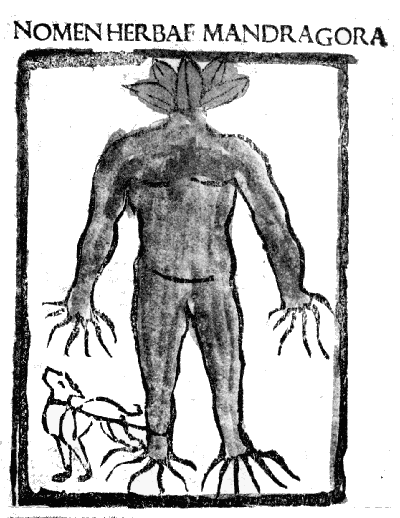
‘Mandragora’ = Mandrake [Herbarium Apuleii Platonici, ? 1484].
The tint represents colouring, which was probably contemporary.
CHAPTER III
THE EARLY HISTORY OF THE HERBAL IN ENGLAND
1. The Herbarium of Apuleius Platonicus.
 oncerning the Herbarium of Apuleius Platonicus, a few remarks have been already made. This herbal was perhaps the first through which any kind of systematic knowledge of medicinal plants was brought into Britain. For this reason it may be mentioned here, although manuscript herbals do not, strictly, come within our province. In the Bodleian Library there is an Anglo-Saxon translation of the work, which is said to have been made for King Alfred. Another Anglo-Saxon manuscript of later date, probably transcribed between A.D. 1000 and the Norman Conquest, has been rendered into modern English by Dr Cockayne. The classical and Anglo-Saxon plant-names are given in the herbal, and, although there is scarcely any attempt at description, the localities where the plants may be found are sometimes mentioned.
oncerning the Herbarium of Apuleius Platonicus, a few remarks have been already made. This herbal was perhaps the first through which any kind of systematic knowledge of medicinal plants was brought into Britain. For this reason it may be mentioned here, although manuscript herbals do not, strictly, come within our province. In the Bodleian Library there is an Anglo-Saxon translation of the work, which is said to have been made for King Alfred. Another Anglo-Saxon manuscript of later date, probably transcribed between A.D. 1000 and the Norman Conquest, has been rendered into modern English by Dr Cockayne. The classical and Anglo-Saxon plant-names are given in the herbal, and, although there is scarcely any attempt at description, the localities where the plants may be found are sometimes mentioned.
The greater part of the manuscript is concerned with the virtues of herbs. The plants were regarded in this, as in most early works, merely as “simples,” that is, the simple constituents of compound medicines. Hieronymus Bock in 1551 described his herbal as being an account of “die Einfache erd Gewächs, Simplicia genant7.” The term “simple,” now almost obsolete, was a household word 36in earlier times, when most remedies were manufactured at home in the stillroom. The expression of Jaques in ‘As You Like It’—“a melancholy of mine own, compounded of many simples, extracted from many objects”—would not have seemed in the least far-fetched to an audience of that day. It is interesting that, although the word “simple,” used in this sense, has vanished from our common speech, its antithesis “compound” has held its place in the language of pharmacy.
The southern source of the Herbal of Apuleius is suggested by the fact that the origin of the healing art is attributed to Æsculapius and Chiron. We are told, also, that the Wormwoods were discovered by Diana, who “delivered their powers and leechdom to Chiron, the centaur, who first from these worts set forth a leechdom.” The Lily-of-the-Valley, on the other hand, is said to have been found by Apollo and given by him “to Æsculapius, the leech.”
Many of the accounts of the virtues of the plants are of the nature of spells or charms rather than of medical recipes. For instance it is recommended that “if any propose a journey, then let him take to him in hand this wort artemisia, ... then he will not feel much toil in his journey.” As is usually the case in the older herbals, the proper mode of uprooting the Mandrake is described with much gusto. “This wort ... is mickle and illustrious of aspect, and it is beneficial. Thou shalt in this manner take it, when thou comest to it, then thou understandest it by this, that it shineth at night altogether like a lamp. When first thou seest its head, then inscribe thou it instantly with iron, lest it fly from thee; its virtue is so mickle and so famous, that it will immediately flee from an unclean man, when he cometh to it; hence as we before said, do thou inscribe it with iron, and so shalt thou delve about it, as that thou touch it not with the iron, but thou shalt earnestly with an ivory staff delve the earth. And when thou seest its hands and its feet, then tie thou it up. Then take the other end and tie it to a dog’s neck, so that the hound be hungry; next cast meat before him, so that he may not reach it, except he jerk up the wort with him. Of this wort it is said, that it hath so mickle might, that what thing soever37 tuggeth it up, that it shall soon in the same manner be deceived. Therefore, as soon as thou see that it be jerked up, and have possession of it, take it immediately in hand, and twist it, and wring the ooze out of its leaves into a glass ampulla.”
![Text-fig. 19. Wood-cut of Plants [Bartholomæus Anglicus, Liber de proprietatibus rerum, Wynkyn de Worde, ? 1495]. Reduced.](images/i_068.png)
Text-fig. 19. Wood-cut of Plants [Bartholomæus Anglicus, Liber de proprietatibus rerum, Wynkyn de Worde, ? 1495]. Reduced.
The writer of the herbal evidently fully accepted the mythical notion that the Mandrake was furnished with human limbs. Plate V shows how this plant was depicted in an early printed edition of the Herbarium of Apuleius, but much more spirited and sensational treatments of the same subject are to be found in some of the manuscripts38 dealing with herbs. Sixteenth-century representations are shown in Text-figs. 107 and 112.
The earliest English printed book containing information of a definitely botanical character is probably the translation of the ‘Liber de proprietatibus rerum’ of Bartholomæus Anglicus, which was printed by Wynkyn de Worde before the end of the fifteenth century. This has been briefly mentioned in the last chapter (pp. 10 and 11) and a wood-cut from it is shown in Text-fig. 19.
2. Banckes’ Herbal.
The first book printed in England, which can really be called a herbal, is an anonymous quarto volume, without illustrations, published in 1525. The title-page runs, “Here begynneth a newe mater, the whiche sheweth and treateth of ye vertues and proprytes of herbes, the whiche is called an Herball.” On the last page we find the words “Imprynted by me Rycharde Banckes, dwellynge in London, a lytel fro ye Stockes in ye Pultry.” I have not been able to satisfy myself that this work is directly derived from any pre-existing book, and it seems possible that it may really have some claim to originality. Dr Payne suggests that it is probably an abridgement of some mediæval English manuscript on herbs. It is certainly quite a different work from the much more famous Grete Herball, printed in the succeeding year, and, although there are no figures, it is in some ways a better book. Distinctly less space, in proportion, is devoted to the virtues of the plants, and, on the whole, more botanical information is given. For instance, under the heading “Capillus veneris,” we find the following description: “This herbe is called Mayden heere or waterworte. This herbe hathe leves lyke to Ferne, but the leves be smaller, and it groweth on walles and stones, and in ye myddes of ye lefe is as it were blacke heere.” The Grete Herball, on the other hand, vouchsafes only the meagre information, “Capillus veneris is an herbe so named”!
In cases where the virtues of the herbs are not strictly medicinal, they are described in Banckes’ herbal with more than a touch of poetry. Rosemary has perhaps the39 most charming list of attributes, some of which are worth quoting. The reader is directed to “take the flowres and make powder therof and bynde it to the ryght arme in a lynen clothe, and it shall make the lyght and mery.... Also take the flowres and put them in a chest amonge youre clothes or amonge bokes and moughtes shall not hurte them.... Also boyle the leves in whyte wyne and wasshe thy face therwith ... thou shall have a fayre face. Also put the leves under thy beddes heed, and thou shalbe delyvered of all evyll dremes.... Also take the leves and put them into a vessel of wyne ... yf thou sell that wyne, thou shall have good lucke and spede in the sale.... Also make the a box of the wood and smell to it and it shall preserne [preserve] thy youthe. Also put therof in thy doores or in thy howse and thou shalbe without daunger of Adders and other venymous serpentes. Also make the a barell therof and drynke thou of the drynke that standeth therin and thou nedes to fere no poyson that shall hurte ye, and yf thou set it in thy garden kepe it honestly for it is moche profytable.”
The popularity of Banckes’ Herbal is attested by the fact that a large number of editions appeared from different presses, although their identity has been obscured by the various names under which they were published. To consider these editions in detail is a task for the bibliographer rather than the botanist, and it will not be attempted here. We may, however, mention a few typical examples.
In 1550, a book was printed by “Jhon kynge” with the title ‘A litle Herball of the properties of Herbes newly amended and corrected, wyth certayn Additions at the ende of the boke, declaring what Herbes hath influence of certain Sterres and constellations, wherby maye be chosen the best and most lucky tymes and dayes of their ministracion, according to the Moone beyng in the signes of heaven, the which is daily appointed in the Almanacke, made and gathered in the yeare of our Lorde God. MDL the XII daye of February, by Anthony Askham, Physycyon.’ This work, which is generally called Askham’s Herbal, is directly derived from Banckes’ Herbal, with the addition of some astrological lore.
The book known as Cary’s or Copland’s Herbal, which40 was probably first published about the same time as Askham’s Herbal, is simply a later edition of the herbal of Rycharde Banckes, and another closely similar edition with an almost identical title was published by Kynge.
Another version of the same work, undated, and printed by Robert Wyer, appeared under an even more deceptive title—‘A newe Herball of Macer, Translated out of Laten in to Englysshe.’ There was, as a matter of fact, a certain Æmilius Macer, a contemporary of Virgil and Ovid, who wrote about plants in Latin verse, and there is also a herbal which was first printed in the fifteenth century, and which is known by the name of ‘Macer Floridus de viribus herbarum.’ Macer Floridus or Æmilius Macer is supposed to have been the pseudonym of a physician whose real name was Odo. ‘De viribus herbarum’ deals with seventy-seven plants in alphabetical order, and describes their virtues in mediæval Latin verse, which is believed to date back to the tenth century. It is illustrated with wood-cuts which are apparently copied from those of the Herbarius zu Teutsch.
There seems to be no justification whatever for the use of Macer’s name on the title-page of ‘A newe Herball of Macer.’ Except for some slight verbal differences, it is identical with Banckes’ herbal of 1525. Another closely similar edition, also undated, was published under the name of ‘Macers Herbal. Practysd by Doctor Lynacro.’ Macer’s name was probably merely borrowed in each case, in order to give the books a well-sounding title, and thus to increase the chances of sale.
3. The Grete Herball.
Among the earlier English herbals, the greater reputation belongs, not to Banckes’ Herbal in any of its forms, but to the ‘Grete Herball’ printed by Peter Treveris in 1526, and again in 1529. This was admittedly a translation from the French, namely from the work known as ‘Le Grant Herbier,’ whose origin we have discussed on p. 24. In the preface and supplement, however, it also shows some indebtedness to the Ortus Sanitatis. The figures in the Grete Herball are degraded copies of the series which41 first appeared in the Herbarius zu Teutsch (see Text-figs. 20 and 21).
The introduction to the Grete Herball, though it is less naïve and charming than the corresponding part of the German Herbarius, may yet be quoted, in part, as giving a very lucid idea of the utilitarian point of view of the herbalist of the period, and also as bringing home to the reader the immense influence of the theory of the four elements:
“Consyderynge the grete goodnesse of almyghty god creatour of heven and erthe, and al thynge therin comprehended to whom be eternall laude and prays, etc. Consyderynge the cours and nature of the foure elementes and qualytees where to ye nature of man is inclyned, out of the whiche elementes issueth dyvers qualytees infyrmytees and dyseases in the corporate body of man, but god of his goodnesse that is creatour of all thynges hath ordeyned for mankynde (whiche he hath created to his owne lykenesse) for the grete and tender love, which he hath unto hym to whom all thinges erthely he hath ordeyned to be obeysant, for the sustentacyon and helthe of his lovynge creature mankynde whiche is onely made egally of the foure elementes and qualitees of the same, and whan any of these foure habounde or hath more domynacyon, the one than the other it constrayneth ye body of man to grete infyrmytees or dyseases, for the whiche ye eternall god hath gyven of his haboundante grace, vertues in all maner of herbes to cure and heale all maner of sekenesses or infyrmytes to hym befallyng thrugh the influent course of the foure elementes beforesayd, and of the corrupcyons and ye venymous ayres contrarye ye helthe of man. Also of onholsam meates or drynkes, or holsam meates or drynkes taken ontemperatly whiche be called surfetes that brengeth a man sone to grete dyseases or sekenesse, whiche dyseases ben of nombre and ompossyble to be rehersed, and fortune as well in vilages where as nother surgeons nor phisicians be dwellyng nygh by many a myle, as it dooth in good townes where they be redy at hande. Wherfore brotherly love compelleth me to wryte thrugh ye gyftes of the holy gost shewynge and enformynge how man may be holpen with grene herbes of the gardyn and wedys of ye feldys as well as by costly receptes of the potycarys prepayred.”
The conclusion of the whole matter, which is set forth immediately before the index, is in these words:
“O ye worthy reders or practicyens to whome this noble volume is present I beseche yow take intellygence and beholde ye workes and operacyons of almyghty god which hath endewed his symple creature mankynde with the graces of ye holy goost to have parfyte knowlege and understandynge of the vertue of all maner of herbes and trees in this booke comprehendyd.”
From a twentieth-century point of view, the Grete Herball contains much that is curious, especially in relation to medical matters. Bathing was evidently regarded as a strange fad. We learn, on the authority of Galen, that “many folke that hath bathed them in colde wa[ter] have dyed or they came home.” Water drinking seems to have been thought almost equally pernicious, for we are told, “mayster Isaac sayth that it is unpossyble for them that drynketh overmoche water in theyr youth to come to ye aege that god ordeyned them.” A period when men were43 more prone than they are to-day to settle their differences by the use of their own strong right arms is reflected in the various remedies proposed for such afflictions as “blackenesse or brusinge comynge of strypes, specyally yf they be in the face.”
Turning to less concrete ailments, it is rather striking to find what a large number of prescriptions against melancholy are considered necessary. For instance, “To make folke mery at ye table,” one is recommended to “take foure leves and foure rotes of vervayn in wyne, than spryncle the wyne all about the hous where the eatynge is and they shall be all mery.” The smoke of Aristolochia “maketh the pacyent mery mervaylously,” and also “dryveth all devyllsshnesse and all trouble out of ye house.” Bugloss and Mugwort are also recommended to produce merriment, and it is suggested that the lesser Mugwort should be laid under the door of the house, for, if this is done, “man nor womann can not anoy in that hous8.” The number of specifics proposed as a cure for baldness is somewhat surprising, when one remembers that this condition is often attributed to the nervous stress and strain of modern life! Hair-dyes and stains for the nails also receive their share of attention.
Very remarkable powers were ascribed to products of the ocean, such as coral and pearls. The former is described as being “a maner of stony substaunce that is founde in partyes of the see, and specyally in holowe, and cavy hylles that ben in ye see, and groweth as a maner of a glewy humour, and cleveth to the stones.” The writer mentions that “some say that the reed corall kepeth the hous that it is in fro lyghtnynge, thondre, and tempest.” Pearls were regarded as of great value in medicine, and, for weakness of the heart, the patient is recommended to “Take the powdre of perles with sugre of roses,” which suggests a remedy worthy of a poet! Many travellers’ tales are incorporated in the herbal; we find, for instance, a most thrilling description of the lodestone. “Lapis magnetis is the adamant stone that draweth yren. It ... is founde in the brymmes of the occyan see. And there be hylles of it, and 44these hylles drawe ye shyppes that have nayles of yren to them, and breke the shyppes up drawynge of the nayles out.” This description is illustrated by a picture of a rocky pinnacle and a ship going to pieces; one man is already in the water, and two others are on the point of losing their lives.
Many of the remedies for different ailments strike the modern reader as being violent in a terrifying degree, and adapted to a more robust age than the present; they incline one to echo the words, “There were giants in the earth in those days.” But apparently the sixteenth century held an exactly corresponding view of its predecessors, for under the heading of “whyte elebore” we read, “In olde tyme it was commely used in medycyns as we use squamony. For the body of man was stronger than it is now, and myght better endure the vyolence of elebore, for man is weyker at this time of nature.”
It is somewhat remarkable that both Christianity and45 Greek mythology find a place in the Grete Herball. The discovery of Artemisia and its virtues is attributed to Diana and the Centaurs, but in the event of being bitten by a mad dog, the sufferer is recommended to appeal to the Virgin Mary before employing any remedy. “As sone as ye be byten go to the chyrche, and make thy offrynge to our lady, and pray here to helpe and heale thee. Than rubbe ye sore with a newe clothe,” etc.
Quite a number of medicines enumerated in the Grete Herball still hold their own in modern practice. Liquorice is recommended for coughs; laudanum, henbane, opium and lettuces as narcotics; olive oil and slaked lime for scalds; cuttle-fish bone for whitening the teeth, and borax and rose water for the complexion.
This book throws an interesting light on the early names of British plants. The Primrose is called “Prymerolles” or “saynt peterworte.” The “devylles bytte” is said to be “so called by cause the rote is blacke and semeth that it is iagged with bytynge, and some say that the devyll had envy at the vertue therof and bete the rote so for to have destroyed it.” Duckweed is called “Lentylles of the water” or “frogges fote,” while Cuckoo-pint is known by the picturesque name of “prestes hode,” and Wood-sorrel is called “Alleluya” or “cukowes meate.”
One of the most noticeable features of the herbal is the exposure of methods of “faking” drugs, for the protection of the public, “to eschew ye frawde of them that selleth it.” This is a great step in advance from the days of the old Greek herbalists, when secrecy was part of the stock-in-trade of a druggist, and, as we have pointed out in a previous chapter, the credulous public was warned off by threats of the miraculous and fearful ills, which would follow any unskilled meddling with the subject.
Another work, which was illustrated with the same figures as those of the Grete Herball, was ‘The vertuose boke of Distillacyon of the waters of all maner of Herbes,’ which appeared in 1527. This was a translation by Laurence Andrew from the ‘Liber de arte distillandi’ of Hieronymus Braunschweig, to which we have already referred. It was almost entirely occupied with an account46 of methods of distillation, but occasionally there is a picturesque touch of description. For example, in speaking of the Mistletoe, the author says, “This herbe hath a longe slender lefe nother full grene, nor ful yelowe, and bereth a small whyte berye.” The book was printed “in the flete strete by me Laurens Andrewe, in the sygne of the golden Crosse.”
CHAPTER IV
THE BOTANICAL RENAISSANCE OF THE SIXTEENTH AND SEVENTEENTH CENTURIES
1. The Herbal in Germany.
 N his History of Botany, Kurt Sprengel first used the honoured title, “The German Fathers of Botany,” to describe a group of herbalists—Brunfels, Bock, Fuchs and Cordus—whose work belongs principally to the first half of the sixteenth century.
N his History of Botany, Kurt Sprengel first used the honoured title, “The German Fathers of Botany,” to describe a group of herbalists—Brunfels, Bock, Fuchs and Cordus—whose work belongs principally to the first half of the sixteenth century.
The earliest of these was Otto Brunfels [Otho Brunfelsius], who is said to have been born in 1464. His surname is derived from the fact that his father, who was a cooper, came from Schloss Brunfels, near Mainz. When Otto grew up, he became a Carthusian monk. We do not know how long his monastic career lasted, but eventually his health appears to have broken down, and, at the same time, his faith in the Roman Catholic Church was undermined by the acquaintance which he began to make with protestant doctrines. He fled from the monastery, and took up his abode in Strasburg, where he was for nine years headmaster of the grammar school. He wrote various theological works, but ultimately turned his attention to medicine, and, before his death in 1534, he had become town physician at Bern. As evidence of his medical studies we have his fine herbal, which is still full of interest, whereas his other works, which he probably 48-49regarded as much more serious contributions, have fallen into oblivion.
![Text-fig. 22. “Walwurtz männlin” = Symphytum, Comfrey [Brunfels, Herbarum vivæ eicones, Vol. I. 1530]. Reduced.](images/i_079.png)
Text-fig. 22. “Walwurtz männlin” = Symphytum, Comfrey [Brunfels, Herbarum vivæ eicones, Vol. I. 1530]. Reduced.
![Text-fig. 23. “Helleborus Niger” = Helleborus viridis L., Green Hellebore [Brunfels, Herbarum vivæ eicones, Vol. I. 1530]. Reduced.](images/i_080.png)
Text-fig. 23. “Helleborus Niger” = Helleborus viridis L., Green Hellebore [Brunfels, Herbarum vivæ eicones, Vol. I. 1530]. Reduced.
A new era in the history of the herbal may be said to50 date from the year 1530, when the first part of Brunfels’ work, the ‘Herbarum vivæ eicones,’ was published by Schott of Strasburg. In this book, with its beautiful and naturalistic illustrations, there is, as the title indicates, a real return to nature; the plants are represented as they are, and not in the conventionalised aspect which had become traditional in the earlier herbals, through successive copying by one artist from another, without reference to the plants themselves. The blocks for the ‘Herbarum vivæ eicones’ were executed by Hans Weiditz, who was probably also the draughtsman. Examples are shown in Text-figs. 22, 23, 24, 25, 82, 83 and 84.
The illustrations of Brunfels’ herbal are incomparably better than the text, which is very poor, and largely borrowed from previous writers. Brunfels’ knowledge of botany was chiefly derived from the study of certain Italian authors, Manardus and others, who spent their time in trying to identify the plants they saw growing around them with those described by Dioscorides. This was by no means unreasonable in their case, since it was the plants of the Mediterranean region that Dioscorides had enumerated. When, however, Brunfels attempted to employ the same methods in his examination of the flora of the Strasburg district, and the left bank of the Rhine, many difficulties and discrepancies arose. He had no understanding of the geographical distribution of plants, and did not realise that different regions have dissimilar floras. It is curious that this should have been so, when we remember that Theophrastus, more than eighteen hundred years earlier, had clearly pointed out that the provinces of Asia have each their own characteristic plants, and that some, which occur in one region, are absent from another.
Hieronymus Bock, who in his Latin writings called himself Tragus (Text-fig. 26), was a contemporary of Brunfels, though his botanical work was somewhat later in date. He was born in 1498, and destined by his parents for the cloister. But he proved to have no vocation for the monastic life, and, having passed through a university course, he obtained, by favour of the Count Palatine Ludwig, the post of school teacher at Zweibrücken, and overseer of the Count’s garden. After his patron’s death 51-53he removed to Hornbach, where he preached the gospel, and also had an extensive medical practice, devoting his spare time to botany. But he got into some trouble, apparently owing to his protestantism, and was obliged to leave Hornbach. He was in serious straits until Count Philip of Nassau, whom he had previously cured of a severe54 illness, gave him shelter and support in his own castle. He was eventually able to return to Hornbach, where he filled the office of preacher until his death in 1554.
![Text-fig. 24. “Synnaw” = Alchemilla, Ladies’ Mantle [Brunfels, Herbarum vivæ eicones, Vol. II. 1531]. Reduced.](images/i_082.png)
Text-fig. 24. “Synnaw” = Alchemilla, Ladies’ Mantle [Brunfels, Herbarum vivæ eicones, Vol. II. 1531]. Reduced.
![Text-fig. 25. “Caryophyllata” = Geum, Avens [Brunfels, Herbarum vivæ eicones, Vol. III. 1540]. Reduced.](images/i_083.png)
Text-fig. 25. “Caryophyllata” = Geum, Avens [Brunfels, Herbarum vivæ eicones, Vol. III. 1540]. Reduced.
Bock’s great work is the ‘New Kreutterbuch,’ a herbal which first appeared in 1539, printed at Strasburg by Wendel Rihel. In subsequent editions the title was abbreviated to ‘Kreuter Bůch.’ The first edition was without illustrations, but a second, containing many wood-cuts, followed in 1546. The majority of the figures are said to have been copied on a reduced scale from those in Fuchs’ magnificent herbal, which appeared in 1542, between the first and second editions of Bock’s work. Fuchs’ figures must have been used with great discretion, for the plagiarism is often not obvious (see Text-figs. 27, 90, 91). A considerable number of the figures are new, being drawn and engraved by David Kandel, whose initials appear on the portrait of Bock, reproduced in Text-fig. 26. The wood-cuts of trees in the third part of the book are particularly noticeable (see Text-figs. 28 and 92) and are often made more interesting by the introduction of figures of men and animals.
Bock’s chief claim to remembrance, however, does not lie in his figures, but in his descriptions, which were a great advance on those previously published. He was careful also to note the mode of occurrence and localities of the plants mentioned, and in this feature his work showed some approach to a flora in the modern sense of the word. Bock seems to have been a keen collector, although hampered by ill-health, and a great point in his favour is that he described only those plants which had come under his own personal observation. The Royal Fern (Osmunda) was traditionally supposed to bear seed upon St. John’s Eve, though ferns were generally believed at that time to have no organs of fructification. To test this statement, Bock four times spent the night in the forest. He found “small black seed like poppy seed,” in spite of the fact that he “used no charm, incantation or magic character,” but went upon his search without superstition.
Bock’s freedom from the credulity which permeated the work of so many of the early botanists is one of his most 56-57remarkable characteristics. His chapters on Verbena and Artemisia reflect clearly the independence of his thought. He points out that the former plant is collected rather for purposes of magic than for medicine, and he can hardly58 contain his scorn at the “monkey tricks and ceremonies” connected with the use of the latter.
Leonhard Fuchs [or Fuchsius], the third of the Fathers of German Botany (see Frontispiece), belonged to the same generation as Hieronymus Bock, though he was a little younger and produced his chief work three years later. He was born in 1501 at Membdingen in Bavaria, and at an early age he became a student of the University of Erfurt, where he is said to have taken a bachelor’s degree in his thirteenth year! After a period of school teaching, he resumed his studies, this time at the University of Ingolstadt, where he devoted himself chiefly to classics, and became a Master of Arts. After this he turned his attention to medicine, and took a doctor’s degree. At Ingolstadt he came under the influence of Luther’s writings, which won him over to the reformed faith.
Fuchs began to practise as a physician at Munich, but in 1526 he returned to Ingolstadt as Professor of Medicine. He seems to have been of a restless temperament, which was probably accentuated by the persecution to which his protestant opinions exposed him. His career for more than forty years consisted of periods of active practice, alternating with periods of university teaching. In 1535 he was appointed to a professorship at Tübingen, and, while he held this post, he declined a call to the University of Pisa, and also an invitation to become physician to the King of Denmark. It is clear that, both as a physician and a teacher, he was in great demand. He acquired a widespread reputation by his successful treatment of a terrible epidemic disease, which swept over Germany in 1529. A little book of medical instructions and prayers against the plague, which was published in London in the latter half of the sixteenth century, shows that his fame had extended to England. It is entitled, ‘A worthy practise of the moste learned Phisition Maister Leonerd Fuchsius, Doctor in Phisicke, most necessary in this needfull tyme of our visitation, for the comforte of all good and faythfull people, both olde and yonge, both for the sicke and for them that woulde avoyde the daunger of contagion.’
In spite of his professional activity, Fuchs found time to produce a botanical masterpiece, which appeared in 59-601542 from the press of Isingrin of Basle, under the title ‘De historia stirpium.’ This was a Latin herbal dealing with about four hundred native German, and one hundred foreign plants, and was followed in the succeeding year by a German edition, called the ‘New Kreüterbůch.’ Of all the botanists of the Renaissance, Fuchs is perhaps the one who deserves most to be held in honour. He is notably superior to his two predecessors in matters calling for scholarship, such as the critical study of the plant nomenclature of classical authors. His herbal rivals, or even surpasses, that of Brunfels in its illustrations, and that of Bock in its German text. The letter-press of the Latin edition is, on the whole, inferior to the German, the brief descriptions being often taken word for word from previous writers.
The Latin edition opens, however, with a long and most interesting preface, in singularly pure and fine Latin. Fuchs is keenly indignant at the ignorance of herbs displayed even by medical men. His outburst on this subject may be literally translated as follows:—“But, by Immortal God, is it to be wondered at that kings and princes do not at all regard the pursuit of the investigation of plants, when even the physicians of our time so shrink from it that it is scarcely possible to find one among a hundred who has an accurate knowledge of even so many as a few plants?”
That Fuchs’ work was indeed a labour of love is a conviction that must force itself upon everyone who studies his herbal, and it is further borne out by his own words in the preface—words which bear the stamp of a lively enthusiasm: “But there is no reason why I should dilate at greater length upon the pleasantness and delight of acquiring knowledge of plants, since there is no one who does not know that there is nothing in this life pleasanter and more delightful than to wander over woods, mountains, plains, garlanded and adorned with flowerlets and plants of various sorts, and most elegant to boot, and to gaze intently upon them. But it increases that pleasure and delight not a little, if there be added an acquaintance with the virtues and powers of these same plants.”
![Text-fig. 31. “Polygonatum latifolium” = Solomon’s Seal [Fuchs, De historia stirpium, 1542]. Reduced.](images/i_092.png)
Text-fig. 31. “Polygonatum latifolium” = Solomon’s Seal [Fuchs, De historia stirpium, 1542]. Reduced.
The wood-cuts which illustrate Fuchs’ herbal are of 61-62extraordinary beauty (Text-figs. 30, 31, 32, 58, 70, 86, 87, 88). Some of them gain a special interest as being the first European figures of certain American plants, e.g. Indian Corn (Zea mais L.) and the Great Pumpkin (Cucurbita maxima Duch.) (Text-fig. 32). These wood-cuts became familiar in England in the second half of the sixteenth century, being used on a reduced scale (borrowed from the octavo edition) in both William Turner’s herbal and Lyte’s Dodoens, two books which we shall consider a little later. In Fuchs’ great work we are fortunate in possessing, in addition to the botanical drawings, a full-length portrait of the author himself, holding a spray of Veronica, on the verso of the title-page (see Frontispiece), and, at the end of the work, named portraits, which are generally supposed to represent the artist who drew the plants from nature, the draughtsman whose business it was to copy the outline on to the wood, and the engraver who actually cut the block (Text-fig. 89). It has also been suggested that the first of these is perhaps engaged in colouring a printed sheet. These portraits are powerfully drawn, and remarkably convincing. It is pleasant to think that we know not merely the names, but the very features of the men who collaborated to give us what is perhaps the most beautiful herbal ever produced.
The influence of Fuchs’ illustrations is more strongly felt in later work than that of his text. The majority of the wood engravings in Bock’s ‘Kreuter Bůch’ (1546), Dodoens’ ‘Crǔÿdeboeck’ (1554), Turner’s ‘New Herball’ (1551-1568), Lyte’s ‘Niewe Herball’ (1578) and Jean Bauhin’s ‘Historia plantarum universalis’ (1651), are copied from Fuchs, or even printed from his actual wood-blocks, while a number of his figures reappear in the herbals of Egenolph, d’Aléchamps, Tabernæmontanus, etc., and the commentaries of Ruellius and Amatus Lusitanus on Dioscorides.
![Text-fig. 32. “Cucumis turcicus” = Cucurbita maxima Duch., Giant Pumpkin [Fuchs, De historia stirpium, 1542]. Reduced.](images/i_094.jpg)
Text-fig. 32. “Cucumis turcicus” = Cucurbita maxima Duch., Giant Pumpkin [Fuchs, De historia stirpium, 1542]. Reduced.
Fuchs arranged his work alphabetically, making no attempt at a natural grouping of the plants, and his herbal is therefore without importance in the history of plant classification. His influence on methods of plant description was, however, considerable, as is shown by the fact that Dodoens, in his ‘Crǔÿdeboeck,’ took Fuchs’ herbal 63-64as a model for the order of description of each plant. Fuchs’ text, as well as his figures, may thus be said to have had an effect, even if an indirect one, on British botany, since the herbals of Lyte and of Gerard are based on the work of Dodoens, in which, as we have just shown, the influence of Fuchs is clearly felt.
The publisher Christian Egenolph of Frankfort, though not himself a botanical writer, must be mentioned at this stage, because he brought out, in 1533, a set of plant illustrations which became particularly well known (e.g. Text-figs. 33 and 85). They do not reflect any great credit on Egenolph, since they were mostly pirated from Brunfels. They were not even used to illustrate a new herbal, but merely a new edition of the old German Herbarius, enlarged and improved by Dr Eucharias Rhodion, and issued under the name of ‘Kreutterbůch von allem Erdtgewåchs].’
Egenolph was evidently a keen man of business, for he made his figures do duty over and over again. He used them not only as illustrations to the herbal, but as a separate publication, without any letter-press, and also in conjunction with an entirely unrelated text, such, for example, as a Latin version of Dioscorides. Many later editions of the Kreutterbůch appeared, and to these a number of figures were added, chiefly copies, on a reduced scale, from those of Bock, who had himself made considerable use of the drawings in the octavo edition of Fuchs’ herbal. The editions produced under the auspices of Adam Lonicer, the publisher’s son-in-law, are particularly well known. No other botanical works of the period had a success comparable to that of this long series of books, of which Rhodion’s ‘Kreutterbůch’ was the prototype. This success was, however, achieved in the teeth of much adverse contemporary criticism. Fuchs, in the preface of his ‘Historia stirpium’ (1542), referred with unsparing touch to Egenolph’s botanical mistakes. His trenchant indictment may be rendered into English as follows—“Among all the herbals which exist to-day, there are none which have more of the crassest errors than those which Egenolph, the printer, has already published again and again.” This statement Fuchs supports by means of actual examples.
It must nevertheless be admitted that, even if their quality was poor, the herbals published by Egenolph and his successors did good service in disseminating some knowledge of the plant world among a very wide public. There is, in the British Museum, a beautiful copy of the 1536 edition, with a binding stamped in gold and bearing the arms of Mary, Duchess of Suffolk, daughter of Henry VII. The duchess may perhaps have inherited a taste for herbals from her father, for the British Museum also possesses a copy of Vérard’s translation of the ‘Ortus Sanitatis,’ which is known to have been purchased by him.
Among the German Fathers of Botany, Sprengel includes a comparatively little known name, that of Valerius Cordus (1515-1544), a man whose actual achievement was small, but who, if he had not died so young, would probably have become one of the most famous of the earlier herbalists. His father, Euricius Cordus, was a physician, botanist, and man of letters, so Valerius was brought up in a fortunate environment. At sixteen he graduated at the University of Marburg, and, after studying in various towns,66 he passed from the position of pupil to that of teacher, and expounded Dioscorides at the University of Wittenberg. He travelled widely in search of plants, and visited many of the savants of the period. He is known to have made a stay at Tübingen, and it is highly probable that he became personally acquainted with Leonhard Fuchs.
Cordus had always longed to see, under their native skies, the plants about which the ancients had written, and, in fulfilment of this dream, he undertook a long excursion into Italy. He visited many of the towns, amongst others Padua, Bologna, Florence and Siena, travelling partly on foot and partly on horseback, and generally accompanied by his friend Hieronymus Schreiber. The journey was a very trying one to men accustomed to a more northerly climate. Wild and difficult country had to be traversed in the height of summer, and the exposure and fatigue led to a tragic conclusion. Cordus was injured by a kick from a horse, which brought on a fever, and his companions had great difficulty in getting him as far as Rome. He rallied, however, and his friends were deceived into the belief that he was on the road to recovery. They even thought it safe to leave him, while they made an excursion to Naples, but he did not survive until their return. His fate, like that of Keats, was to see Rome and die.
None of the botanical works of Valerius Cordus were published during his life-time, but his commentaries on Dioscorides and his ‘Historia stirpium’ were edited by Gesner after his death. The great merit of the ‘Historia’ lies in the vividness of the descriptions. The author seems to have examined the plants for their own sake—not merely in the interest of the arts of healing.
Cordus did noteworthy service to medicine, however, for when he passed through Nuremberg on his travels he was able to lay before the physicians of that town a collection of medical recipes, chiefly selected from earlier writings. This work, which had for some time been in use in Saxony in manuscript form, was considered so valuable that, after it had been examined and tested under the auspices of the town council, it was published officially as the Nuremberg ‘Dispensatorium,’ probably in 15469. This 67is said to be the first work of the nature of a pharmacopœia ever published under government authority.
A passing reference may be made at this point to Jacob Theodor of Bergzabern (1520-1590), a herbalist whose work was perhaps of no very great importance, but who is closely connected with the German Fathers of Botany, having been the pupil both of Otto Brunfels and of Hieronymus Bock. In his books he called himself Tabernæmontanus.
Like the majority of the herbalists, Theodor was a medical man, and his study of botany was a hobby which extended over many years. He projected a herbal, but was unable for a long time to carry the idea into effect, being deterred by the cost of the illustrations. This difficulty was eventually overcome, chiefly through the generosity of Count Palatine Frederick III, and of the Frankfort publisher, Nicolaus Bassæus. The herbal first appeared in 1588, under the title ‘Neuw Kreuterbuch,’ and in 1590 the illustrations were published without any text as the ‘Eicones plantarum.’ The herbal is a large and very finely illustrated work. The figures, however, are for the most part not original, but are reproduced from Bock, Fuchs, Dodoens, Mattioli, de l’Écluse and de l’Obel. This collection of wood-blocks became familiar in England a few years later, when they were acquired by the printer John Norton, and used to illustrate Gerard’s ‘Herball’ which appeared in 1597.
There is still another German herbalist of the sixteenth century whose work must not be overlooked. This is Joachim Camerarius10 the younger (Plate VI). His father was a celebrated philologist, and a friend of Melanchthon. The son, who was born in 1534, was attracted to botany in his early youth. He studied at Wittenberg and other universities, and travelled in Hungary and Italy. He spent some time in the latter country, and took a doctor’s degree in medicine at Bologna. At Pisa, he became acquainted with Andrea Cesalpino. Finally he returned to Germany, and settled down at Nuremberg. Here he cultivated a garden which was kept supplied with rare plants by his friends, and the Nuremberg merchants.
Plate VI
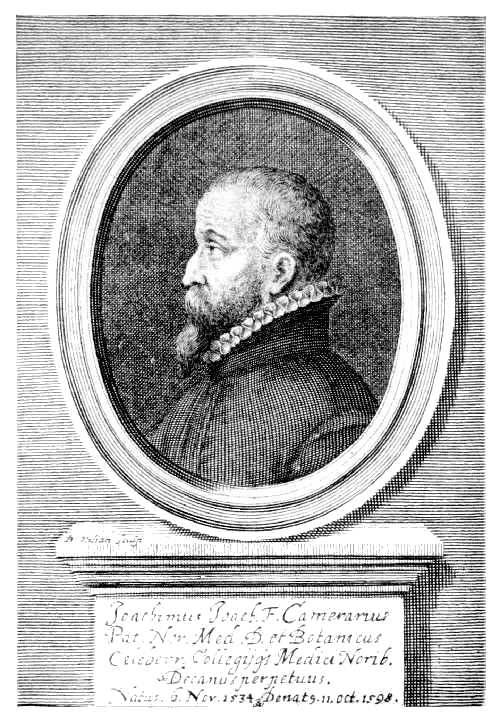
JOACHIM CAMERARIUS, the younger (1534-1598).
[Engraving by Bartholomæus Kilian, probably between 1650 and 1700. Department of Prints and Drawings, British Museum.]
Camerarius brought out an edition of Mattioli (‘De plantis Epitome’), but his chief work was the ‘Hortus medicus et philosophicus,’ which appeared in 1588. The illustrations to this book consist partly of drawings by Gesner, which the author had bought a few years previously, and partly of original figures. It is impossible to discriminate with any exactness between the work of the two men. These wood-cuts, of which Text-figs. 34, 35, 71 and 100 are 69examples, will be discussed more fully in Chapter VII. From the botanical point of view, they represent a considerable advance, since the details of floral structure are often shown on an enlarged scale. Camerarius was a good observer, and his travels furnished him with much information regarding the localities for the plants which he described.
![Text-fig. 35. “Palma” = Seedlings of Phœnix dactylifera L., Date Palm [Camerarius, Hortus medicus, 1588].](images/i_102.png)
Text-fig. 35. “Palma” = Seedlings of Phœnix dactylifera L., Date Palm [Camerarius, Hortus medicus, 1588].
2. The Herbal in the Low Countries.
In the sixteenth century, the Herbal flourished exceedingly in the Low Countries. This was due in part to the zeal and activity of the botanists of the Netherlands, but perhaps even more to the munificence, and love of learning for its own sake, which distinguished that prince of publishers, Christophe Plantin of Antwerp. In these qualities he forms a notable contrast to Egenolph of Frankfort, to whose shortcomings we have already drawn attention.
Plantin’s life extended from about 1514 to 1589, and thus included the central years of that wonderful century. He was a native of Touraine, and studied the art of printing at Caen and other French towns. Towards 1550, he and his wife, Jeanne Rivière, settled in Antwerp, where he worked at book-binding, and his wife sold linen in a little shop. Later, he returned to the profession of printing, and his business in this direction gradually developed, and was eventually transferred to the famous Maison Plantin. Christophe’s reputation grew to such an extent that great efforts were made, in various quarters, to tempt him from Antwerp. The Duke of Savoy and Piedmont, for instance, did all he could to persuade him to come to Turin, promising him extensive printing works and all necessary funds—but he remained faithful to the city of his adoption. Perhaps the most potent factor in his success was his keen judgment of men, which enabled him so to choose his subordinates that he gathered around him an unrivalled staff.
One of Plantin’s daughters married Jean Moretus, her father’s chief assistant and successor, and from him the business descended through eight generations of printers to Édouard Jean Hyacinthe Moretus, the last of his race, from whom, in 1876, the citizens of Antwerp purchased the Maison Plantin and its contents. The house had remained practically unchanged since the days when Christophe Plantin lived and worked there, and it is now preserved as the Musée Plantin-Moretus. It is built round a rectangular courtyard, and its beauty, both in proportion and in detail, is such, that one feels at once that Plantin achieved the ambition71 he expressed in his charming sonnet—‘Le Bonheur de ce Monde’—“Avoir une maison commode, propre et belle.”
The pictures, furniture and hangings, and not only the very presses, fonts, and furnaces for casting the type, but even the old account books and corrected proof-sheets are still to be seen, all in their appropriate places. The72 wage-books are preserved, showing the weekly earnings of compositors, engravers and book-binders, throughout a period of three centuries. In short, the Maison Plantin beggars description, and a visit there is an infallible recipe for transporting the imagination back to the time of the Renaissance, when printing was in its first youth, and was treated with the reverence due to one of the fine arts.
The first Belgian botanist of world-wide renown was Rembert Dodoens [or Dodonæus] (Text-fig. 36). He was a contemporary of Plantin, having been born at Malines in 151711. He studied at Louvain, and visited the universities and medical schools of France, Italy and Germany, eventually qualifying as a doctor. He was successful in his profession, being physician to the Emperors Maximilian II and Rudolph II, and finally becoming Professor of Medicine at Leyden, where he died in 1585. His interest in the medical aspect of botany led him to write a herbal, and, in order to illustrate it, he obtained the use of the wood-blocks which had been employed in the octavo edition of Fuchs’ work. To these a number of new engravings were added. The book was published in Dutch in the year 1554 by Vanderloe, under the title ‘Crǔÿdeboeck.’ The text is not a translation of Fuchs, as is sometimes supposed, although Dodoens took Fuchs as his model for the order of description of each plant. The method of arrangement is his own, and he indicates localities and times of flowering in the Low Countries, information which clearly could not have been derived from the earlier writer. Almost simultaneously with the first Dutch edition, a French issue appeared under the title of ‘Histoire des Plantes.’ The translation was carried out by Charles de l’Écluse, with whose own work we shall shortly deal. Dodoens supervised the production of the book, and took the opportunity to make some additions. It became known in England through Lyte’s translation, which will be discussed in a later section of this chapter.
The last Dutch edition of the herbal, for which the author himself was responsible, was printed by Vanderloe in 1563. The publisher then parted with Fuchs’ blocks, 73which were probably acquired by the printer of Lyte’s Dodoens in England. This circumstance put great difficulties in the way of Dodoens’ wish to reproduce his herbal in Latin. However it proved a blessing in disguise, for he had the good fortune to meet, in Christophe Plantin, “un74 homme qui ne reculait devant aucune dépense, pour donner aux ouvrages qui sortaient de ses presses toute la perfection et le mérite dont ils étaient susceptibles.” Plantin undertook to produce a much modified Latin translation of the herbal, and to have new blocks engraved for it, whilst Dodoens, on his side, engaged to supply the artists with fresh plants, and to superintend their labours. The work proceeded slowly, and was published in parts. It was finally completed in 1583, and was produced in one volume, under the name of ‘Stirpium historiæ pemptades sex sive libri triginta.’ In this work, by far the larger number of the figures are original (see Text-figs. 37, 38, 96 and 97); some, however, were borrowed from de l’Écluse and de l’Obel. This arose from the fact that Plantin was also the publisher for both these writers, and as he bore the expense of their blocks, he had an agreement with the three authors that their illustrations should be treated as common property. A few of Dodoens’ figures were based upon those in the famous manuscript of Dioscorides, now at Vienna (see pp. 8, 85, 154).
In the ‘Pemptades,’ the botanist in Dodoens was more to the fore, and the physician less in evidence than in his earlier work. It is particularly difficult to appraise with any exactness the services which Dodoens rendered to botany. Between him and his two younger countrymen, de l’Écluse and de l’Obel, there was so intimate a friendship that they freely imparted their observations to one another, and permitted the use of them, and also of their figures, in one another’s books. To attempt to ascertain exactly what degree of merit should be attributed to each of the three, would be a task equally difficult and thankless.
Charles de l’Écluse [or Clusius12] (Plate VII) was born at Arras in the French Netherlands in 1526; like Dodoens, he passed the closing years of his life at Leyden. He studied at Louvain, and other universities, including Montpelier, where he came under the influence of the botanist, Guillaume Rondelet, who also numbered d’Aléchamps, de l’Obel, Pierre Pena and Jean Bauhin among his pupils. De l’Écluse was an enthusiastic adherent of the reformed 75faith, to which he was converted by the influence of Melanchthon, and he suffered religious persecution, which brought even actual martyrdom to some of his relatives. Though he did not himself lose his life, he was deprived of his property, and, between poverty and ill-health, his career seems to have been a melancholy one. He passed a nomad existence, attached at one time as tutor to some great family, while,76 at others, he was occupied in writing or translating for Rondelet, Dodoens or Plantin, or undertaking precarious employment at the court of Vienna. The University of Leyden finally appointed him to a professorship. It is interesting to note that he paid more than one visit to England, and that he was intimate with Sir Francis Drake, who gave him plants from the New World.
De l’Écluse had a reputation for versatility scarcely exceeded by that of his contemporary, the “Admirable” Crichton. He is said to have had a wide knowledge of Latin, Greek, French, German, Flemish, Spanish, law, philosophy, history, geography, zoology, mineralogy and numismatics, besides his chosen subject of botany. Since his botanical début was made as the translator of Dodoens, we may with reason look upon him as a disciple of the latter.
The first original work de l’Écluse produced was an account of the plants which he had observed while on an adventurous expedition to Spain and Portugal with two pupils. This was so successful botanically that he brought back two hundred new species. The description of his finds was published by Plantin in 1576, under the title of ‘Rariorum aliquot stirpium per Hispanias observatarum Historia.’ Wood-blocks were engraved purposely for this book (see Text-figs. 39, 59 and 98), but, for the confusion of the bibliographer, some of them were also used to illustrate Dodoens’ work in the interval while the Spanish flora of de l’Écluse awaited publication. In 1583 appeared our author’s second work, which did the same service for the botany of Austria and Hungary as the previous volume had done for the botany of Spain. These two works, together with some additional matter, were republished in 1601 as the ‘Rariorum plantarum historia.’ In this book, the species belonging to the same genus are often brought together, but, beyond this, there is little attempt at systematic arrangement.
![Text-fig. 39. “Lacryma Iob” = Coix lachryma-Jobi L., Job’s Tears [de l’Écluse, Rariorum ... per Hispanias, 1576].](images/i_112.png)
Text-fig. 39. “Lacryma Iob” = Coix lachryma-Jobi L., Job’s Tears [de l’Écluse, Rariorum ... per Hispanias, 1576].
De l’Écluse was weak in the synthetic faculty, his strength lying rather in his powers of observation. Cuvier reckons that he added more than six hundred to the number of known plants. It is characteristic of his versatile mind, that his botanical interests were not confined, like those of most of the early workers, to flowering plants. A77 manuscript is preserved in the Leyden Library13 containing more than eighty beautiful water-colour drawings of fungi, executed under the direction of de l’Écluse, by artists employed by his great friend and patron, Baron Boldizsár 78de Batthyány. This gentleman is said to have been so enthusiastic a botanist, that he set a Turkish prisoner at liberty, on the condition that he should obtain plants for him from Turkey.
De l’Écluse seems to have been a man of wide friendships, and his botanical correspondence was very large. He did much for horticulture, and is called by his friend, Marie de Brimen, Princesse de Chimay, “le père de tous les beaux Jardins de ce pays.” He deserves especial gratitude for one benefit of a very practical nature, namely the introduction of the Potato into Germany and Austria. It is worthy of note that de l’Écluse, unlike the majority of the herbalists, was not a physician, and although he laid considerable stress on the properties of plants, he was not preoccupied with the medical side of the subject. He studied plants for their own sake, and abandoned the futile effort to identify them with those mentioned by the ancients.
The third of the trio of botanists whom we are now considering is Mathias de l’Obel [de Lobel or Lobelius], who was born in Flanders in 1538, and died in England, at Highgate, in 1616 (Plate VIII). He studied at Montpelier, under Guillaume Rondelet, who, finally, bequeathed to him his botanical manuscripts. Here also he became acquainted with a young Provençal, Pierre Pena, with whom he afterwards collaborated in botanical work. De l’Obel took up medicine as his profession, and eventually became physician to William the Silent, a post which he held until the assassination of the Stadtholder. Later on, he and Pena came to England, probably to seek a peaceful life under the prosperous sway of Queen Elizabeth, which was so favourable to the arts and sciences. Their principal work was dedicated to her, in terms of hyperbolic praise. De l’Obel seems to have been well received in this country, for he was invited to superintend the medicinal garden at Hackney, belonging to Lord Zouche, and he eventually obtained the title of Botanist to James I.
Plate VIII
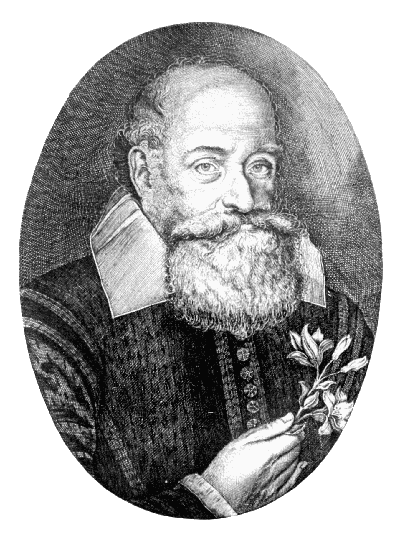
MATHIAS DE L’OBEL (1538-1616).
[Engraving by François Dellarame, 1615. Department of Prints and Drawings, British Museum.]
De l’Obel’s chief botanical work was the ‘Stirpium adversaria nova14,’ published in 1570, with Pena as joint author. Pena does not appear to have been a botanist 79of much importance, and he eventually quite forsook the subject in favour of medicine. It has been suggested, however, that de l’Obel was inclined to minimise the value of his colleague’s work. The system of classification, upon which de l’Obel’s reputation really rests, is set forth in this book. The main feature of his scheme is that he distinguishes different groups by the peculiarities of their leaves. He is thus led to make a rough separation between the classes which we now call Dicotyledons and Monocotyledons. The details of his system will be considered in a later chapter.
In 1576 the work was enlarged, and republished as the ‘Plantarum seu Stirpium Historia’; it was also translated into Flemish, and appeared under the title of ‘Kruydtbœck’ in 1581, dedicated to William of Orange, and the Burgomasters and other functionaries of Antwerp. The blocks (see Text-fig. 67) used to illustrate this work were taken from previous books, especially those of de l’Écluse. Immediately after the publication of the Kruydtbœck, Plantin brought out an album of the engravings it had contained, which, although they had been also used to illustrate the herbals of Dodoens and de l’Écluse, were now grouped according to de l’Obel’s arrangement, which was recognised as the best.
3. The Herbal in Italy.
The Italian botanists of the Renaissance devoted themselves chiefly to interpreting the works of the classical writers on Natural History, and to the identification of the plants to which they referred. This came about quite naturally, from the fact that the Mediterranean flora, which they saw around them, was actually that with which the writers in question had been, in their day, familiar. The botanists of southern Europe were not compelled, as were those whose homes lay north of the Alps, to distort facts before they could make the plants of their native country fit into the procrustean bed of classical descriptions.
One of the chief of the commentators and herbalists of this period was Pierandrea Mattioli [or Matthiolus] (Text-fig. 40), who was born at Siena in 1501, and died of the80 plague in 1577. We realise something of the frightful extent of this scourge, when we remember that it claimed as victims no less than three of the small company of Renaissance botanists, Gesner, Mattioli and Zaluzian. Leonhard Fuchs was brought into fame by his successful treatment of one of these epidemics. It should also be recalled that, while Gaspard Bauhin, one of the best known of the later herbalists, was practising as a physician at Basle, no less than three of these terrible outbreaks occurred in the town.

Text-fig. 40. Pierandrea Mattioli, 1501-1577 [Engraving by Philippe Galle. Virorum Doctorum Effigies, Antwerp, 1572].
Mattioli was the son of a doctor, and his early life was passed in Venice, where his father was in practice. He was81 destined for the law, but his inherited tastes led him away from jurisprudence to medicine. He practised in several different towns, and became physician, successively, to the Archduke Ferdinand, and to the Emperor Maximilian II.
Mattioli’s ‘Commentarii in sex libros Pedacii Dioscoridis,’ his chef-d’œuvre, the gradual production and improvement of which occupied his leisure hours throughout his life, was first published in 1544. It was translated into82 many languages and appeared in countless editions. The success of the work was phenomenal, and it is said that 32,000 copies of the earlier editions were sold. The title does not do the book justice, for it contains, besides an exposition of Dioscorides, a Natural History dealing with all the plants known to Mattioli. The early editions had small illustrations only (Text-figs. 41, 42, 93 and 94), but, later on, editions with large and very beautiful figures were83 published, such as that which appeared at Venice in 1565 (Text-figs. 43, 44, 95).
Mattioli’s descriptions of the plants with which he deals are not so good as those of some of his contemporaries. He found and recorded a certain number of new plants, especially from the Tyrol, but most of the species, which he described for the first time, were not his own discoveries,84 but were communicated to him by others. Luca Ghini, for instance, had projected a similar work, but handed over all his material to Mattioli, who also placed on record the discoveries made by the physician, Wilhelm Quakelbeen, who had accompanied the celebrated diplomatist, Auger-Gislain Busbecq, on a mission to Turkey.
Busbecq brought from Constantinople a wonderful collection of Greek manuscripts, including Juliana Anicia’s copy of the Materia Medica of Dioscorides, now in the Vienna Library (see pp. 8 and 154). He discovered this great manuscript in the hands of a Jew, who required a hundred ducats for it. This price was almost prohibitive, but Busbecq was an enthusiast, and he successfully urged the Emperor, whose representative he was, “to redeem so illustrious an author from that servitude15.” His purpose in buying the manuscript seems to have been largely in order to communicate it to Mattioli, who would thus be able to make use of it in preparing his Commentaries on Dioscorides.
The personal character of Mattioli does not appear to have been a pleasant one. He engaged in numerous controversies with his fellow botanists, and hurled the most abusive language at those who ventured to criticise him.
Another Italian herbalist, Castor Durante, slightly later in date than Mattioli, should perhaps be mentioned here, not because of the intrinsic value of his work, but because of its widespread popularity. At least two of his books appeared in many editions and translations.
Durante was a physician who issued a series of botanical compilations, bedizened with Latin verse. The best known of his works is the ‘Herbario Nuovo,’ published at Rome in 1585 (Text-figs. 45 and 103). A second book, the original version of which is seldom met with, has survived in the form of a German translation, by Peter Uffenbach. The German version was named ‘Hortulus Sanitatis.’ As an illustration of Durante’s charmingly unscientific manner, we may take the legend of the “Arbor tristis” which occurs in both these works. The figure which accompanies it (Text-fig. 45) shows, beneath the moon and stars, a drawing of a tree whose trunk has a human form. The description, as it occurs in the ‘Hortulus Sanitatis,’ may be translated as follows:
“Of this tree the Indians say, there was once a very 86beautiful maiden, daughter of a mighty lord called Parisataccho. This maiden loved the Sun, but the Sun forsook her because he loved another. So, being scorned by the Sun, she slew herself, and when her body had been burned, according to the custom of that land, this tree sprang from her ashes. And this is the reason why the flowers of this tree shrink so intensely from the Sun, and never open in his presence. And thus it is a special delight to see this tree in the night time, adorned on all sides with its lovely flowers, since they give forth a delicious perfume, the like of which is not to be met with in any other plant, but no sooner does one touch the plant with one’s hand than its sweet scent vanishes away. And however beautiful the tree has appeared, and however sweetly it has bloomed at night, directly the Sun rises in the morning it not only fades but all its branches look as though they were withered and dead.”
![Text-fig. 45. “Arbor Malenconico” or “Arbor tristis” = Tree of Sorrow [Durante, Herbario Nuovo, 1585].](images/i_123.png)
Text-fig. 45. “Arbor Malenconico” or “Arbor tristis” = Tree of Sorrow [Durante, Herbario Nuovo, 1585].
Much more famous than Durante was Fabio Colonna, or, as he is more generally called, Fabius Columna (Plate IX), who was born at Naples in 1567. His father was a well-known littérateur. Fabio Colonna’s profession was 87-88that of law, but he was also well acquainted with languages, music, mathematics and optics. He tells us in the preface to his principal work that his interest in plants was aroused by his difficulty in obtaining a remedy for epilepsy, a disease from which he suffered. Having tried all sorts of prescriptions without result, he examined the literature on the subject, and discovered that most of the writers of his time merely served up the results obtained by the ancients, often in a very incorrect form. So he went to the fountain head, Dioscorides, and after much research identified Valerian as being the herb which that writer had recommended against epilepsy, and succeeded in curing himself by its use.
This experience convinced Colonna that the knowledge of the identity of the plants described by the ancients was in a most unsatisfactory condition, and he set himself to produce a work which should remedy this state of things. This book was published in 1592, under the name of ‘Phytobasanos,’ which embodies a quaint conceit after the fashion of the time. The title is a compound Greek word meaning “plant torture,” and was apparently employed by Colonna to explain that he had subjected the plants to ordeal by torture, in order to wrest from them the secret of their identity. But it must be confessed that Colonna himself is by no means free from error, as regards the names which he assigns to them.
The great feature of the ‘Phytobasanos,’ however, is the excellence of the descriptions and figures. The latter are famous as being the first etchings on copper used to illustrate a botanical work (Text-figs. 46 and 105). They were an advance on all previous plant drawings, except the work of Gesner and Camerarius, in giving, in many cases, detailed analyses of the flowers and fruit as well as habit drawings. We owe to Colonna also the technical use of the word “petal,” which he suggested as a descriptive term for the coloured floral leaves16.
By means of his wide scientific correspondence, Colonna kept in touch with many of the naturalists of his time, notably with de l’Écluse and Gaspard Bauhin.
A passing reference may be made here to a book which is rather of the nature of a local flora than a herbal, entitled 89-90‘Prosperi Alpini de plantis Ægypti,’ which was published at Venice in 1592. It contains a number of wood-cuts, which appear to be original. The one reproduced (Text-fig. 47) represents Salicornia, the Glasswort. The author was a doctor who went to Egypt with the Venetian consul, Giorgio Emo, and had opportunities of collecting plants there. He is said to have been the first European writer to mention the Coffee plant, which he saw growing at Cairo. Prospero Alpino eventually became Professor of Botany at Padua, and enriched the botanical garden of that town with Egyptian plants.
4. The Herbal in Switzerland.
Among the many scientific men, whose names are associated with Switzerland, one of the most renowned is Konrad Gesner (Plate X), who was born at Zurich in 1516, the son of a poor furrier. His taste for botany was due, in the first instance, to the influence of his uncle, a protestant preacher. Konrad went to France to study medicine, but in Paris, the richness of the libraries, and the delight of associating with learned men, tempted him away from his special subject into a course of omnivorous reading. After an interval of school teaching at Zurich, he betook himself to Basle, where he entered more methodically upon the study of medicine, at the same time attempting to support himself by working at a Latin dictionary. However, after a short period of student life, he found the expense too great, and was obliged to abandon it, and to take a post as teacher of classics in Lausanne. He had received assistance at different times from his native town, which again came to his help at this juncture, and generously allotted to him a “Reisestipendium,” for the continuance of his medical studies. He indeed owed much to Zurich, for, after taking his doctorate, he was appointed first to the professorship of Philosophy there, and then to that of Natural History, which he held until he died of the plague in his forty-ninth year.
![Text-fig. 48. “Lachryma Iob” = Coix lachryma-Jobi L., Job’s Tears [Simler, Vita Conradi Gesneri, 1566].](images/i_130.png)
Text-fig. 48. “Lachryma Iob” = Coix lachryma-Jobi L., Job’s Tears [Simler, Vita Conradi Gesneri, 1566].
Gesner’s most remarkable characteristic was his versatility and encyclopædic knowledge; he has been called the Pliny of his time. His work on bibliographical and91 linguistic subjects was of importance, and he also wrote on medicine, mineralogy, zoology and botany. The botanical works published during his life were not of great importance, but, at the time of his death, he had already prepared a large part of the material for a general history of plants, which was intended as a companion work to his famous ‘Historia Animalium.’ In order to illustrate it, he had collected 1500 drawings of plants, the majority original, though some were founded on previous wood-cuts, especially92 those of Fuchs. The undertaking was so far advanced that some of the figures had been drawn upon the wood, and certain blocks had even been engraved. The whole collection, and the manuscripts, he bequeathed for publication to his friend Caspar Wolf. Wolf seems to have made an honest effort to carry out Gesner’s wishes, and he succeeded in publishing a few of the wood-cuts, as an appendix to Simler’s ‘Vita Conradi Gesneri’ (e.g. Text-fig. 48). Unfortunately he was hampered by weak health, and the task, as a whole, proved beyond his powers. He sold everything to Joachim Camerarius the younger, with the proviso that the purchaser should make himself responsible for the publication. Camerarius failed to fulfil the spirit of this obligation. It is true that he brought a large number of Gesner’s figures before the public, but he did this only by the indirect method of using them, among his own drawings, to illustrate an edition of Mattioli, and a book of his own.
Finally, about a hundred and fifty years after the death of Camerarius, Gesner’s drawings and blocks came into the possession of the eighteenth-century botanist and bibliographer, Christoph Jacob Trew, who published them, thus giving Gesner his due so far as was possible at that late date. Such blocks as were in good condition were printed directly, and, from the drawings, a number of copper engravings were made, coloured like the originals. The drawings were of unequal merit, some of them being on a very small scale and lacking in clearness. In one point, however, Gesner shows a marked advance on the methods of his contemporaries—namely in giving detailed, analysed studies of flower and fruit structure, as well as a drawing showing the habit of the plant. It must not be forgotten that, even in Trew’s edition, it is impossible to discriminate with certainty between the work of Gesner and that of Camerarius.
Unfortunately, we have no knowledge of the text of Gesner’s manuscript, but his letters make it clear that his interest in botany was thoroughly scientific. If his work were extant, he would probably shine as a discoverer of new species, especially among alpines, for his figures indicate that he was acquainted with a number of plants which 93de l’Écluse, Gaspard Bauhin and others were the first to describe.
Among Gesner’s numerous scientific correspondents was Jean Bauhin, a brilliant young man, twenty-five years his junior. Their acquaintance began when Bauhin was only eighteen, but, in spite of his friend’s youth, Gesner consulted him in botanical difficulties, describing him as “eruditissimus et ornatissimus juvenis.”
Jean Bauhin was the son of a French doctor, a native of Amiens, who had been converted to protestantism by reading the Latin translation of the New Testament prepared by Erasmus. In consequence of his change of faith, he was subjected to religious persecution, which he avoided by retreating to Switzerland, where his sons Jean and Gaspard were born. The medical tradition seems to have been remarkably strong in the family. Both Jean and Gaspard became doctors—Gaspard, whose sons also entered the profession, being, in fact, the second of six generations of physicians. For two hundred years, an unbroken succession of members of the family were medical men.
After Jean Bauhin had studied for a time at the University of Basle, he went to Tübingen, where he learned botany from Leonhard Fuchs. From Tübingen he proceeded to Zurich, and accompanied Gesner on some journeys in the Alps. After further travel on his own account, and a period at the University of Montpelier, he reached Lyons, where he came in contact with d’Aléchamps, who engaged him to assist with the ‘Histoire des plantes.’ Bauhin began to occupy himself with this work, but his protestantism proved a stumbling-block to his life there, and he was obliged to quit France.
Jean Bauhin’s chief botanical work, the ‘Histoire universelle des plantes,’ was a most ambitious undertaking, which he did not live to see published. However, his son-in-law Cherler, a physician of Basle, who had helped him in preparing it, brought out a preliminary sketch of it in 1619, and, in 1650 and 1651, the magnum opus itself was published, under the name of ‘Historia plantarum universalis.’ This book is a compilation from all sources, and includes descriptions of 5000 plants. The figures, of94 which there are more than 3500, are small and badly executed. A large proportion of them are ultimately derived from those of Fuchs.
Jean Bauhin’s more famous brother, Gaspard [or Caspar] (Plate XI), was born in 1560, and was thus the younger by nineteen years. Gaspard studied at Basle, Padua, Montpelier, Paris and Tübingen. He also travelled in Italy, making observations upon the flora, and becoming acquainted with scientific men. Unfortunately he missed being a pupil of Leonhard Fuchs, since his sojourn at Tübingen took place some years after the death of the famous herbalist, who had been his brother’s teacher. The illness and death of his father in 1582 made it necessary for him to settle in Basle, where he became Professor of Botany and Anatomy, and eventually of Medicine.
Inspired by the example of his brother, he conceived the plan of collecting, in a single work, all that had been previously written upon plants, and, especially, of drawing up a concordance of all the names given by different authors to the same species. His extensive early travels served as a good preparation for this task, since he had not only observed and collected widely, but had established relations with the best botanists in Europe. He formed a herbarium of about 4000 plants, including specimens from correspondents in many countries, even Egypt and the East Indies. Besides study bearing directly on his great project, he accomplished a considerable amount of critical and editorial work, which also had its value in relation to his main plan. He produced new editions of Mattioli’s Commentaries, and of the herbal of Tabernæmontanus, and published a criticism of d’Aléchamps’ ‘Historia plantarum.’
There is a marked parallelism between the careers of the Bauhin brothers, for Gaspard’s great work underwent much the same vicissitudes as that of Jean. The main part of Gaspard’s chief work never saw the light at all, although his son brought out one instalment of it, many years after his father’s death. Gaspard was however more fortunate than Jean, in that he lived to see the publication of three important preliminary volumes, as the result of his researches, and it is on these that his reputation rests.
The ‘Prodromos theatri botanici’ of 1620 consisted of descriptions of 600 species, which the author regarded as new, although several had, as a matter of fact, been already described by de l’Écluse. Figures of about 140 species are given, two of which are here reproduced (Text-figs. 49 and 62). One of these, the Potato (Text-fig. 49), still retains the name of Solanum tuberosum which Bauhin gave to it. He had previously published a description96 of this plant in an earlier work, the ‘Phytopinax’ of 1596.
In 1623, Gaspard Bauhin brought out his most important botanical book, the ‘Pinax17 theatri botanici.’ By this date, owing to the number of different names bestowed upon the same plant by different authors, and the varying identifications of those described by the ancients, the subject of plant nomenclature had been reduced to a condition of woeful confusion. Bauhin’s ‘Pinax’ converted chaos into order, since it contained the first complete and methodical concordance of the names of plants, and was so authoritative as to earn for the author the title of “législateur en botanique.” The work, which dealt with about 6000 plants, was recognised as pre-eminent for many years. Morison criticised the scheme of arrangement on which it was based, but adopted its nomenclature, as also did Ray. Tournefort also retained, as far as possible, the names of the genera and species used in the ‘Pinax.’ As Sachs long ago pointed out, this work is “the first and for that time a completely exhaustive book of synonyms, and is still indispensable for the history of individual species—no small praise to be given to a work that is more than 250 years old.”
Gaspard Bauhin deserves great honour as the first who introduced some degree of order into the chaotic muddle of nomenclature and synonymy. The special merits of his work, more especially his power of concise and lucid description, and his faculty for systematic arrangement, may perhaps be attributed to his French blood, since such qualities are markedly characteristic of French scientific writing.
It is much to be regretted that the two brothers Bauhin should have carried on their work independently and separately, considering that they had in view practically identical objects—objects in which each only achieved a partial success. It seems as if a work of much greater value might have resulted if they had joined forces.
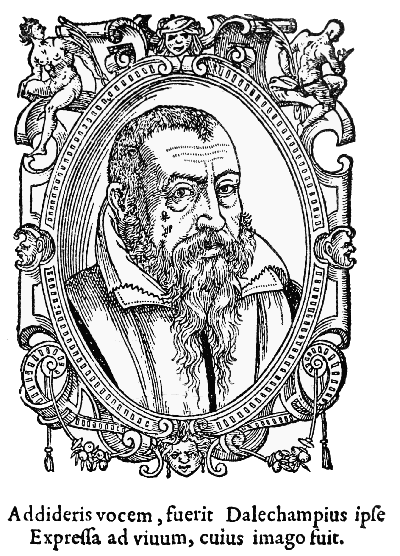
Text-fig. 50. Jacques d’Aléchamps, 1513-1588 [Enlarged from wood-cut, circa 1600, Department of Prints and Drawings, British Museum].
5. The Herbal in France.
France (excluding the French Netherlands) does not seem, at first sight, to have contributed a great deal towards the development of the Herbal in the sixteenth and seventeenth centuries, but it must be remembered that Jean and Gaspard Bauhin, and the publisher, Christophe Plantin, were French by extraction, though Switzerland and Holland were their countries by adoption. Most of the important herbals published in other languages were translated into French quite early in their history, sometimes in a modified form, so that France in the sixteenth century was probably by no means backward in botanical knowledge. One such adaptation was ‘L’Histoire des Plantes,’ by Geofroy Linocier, which was founded, in part, on the works of Fuchs and Mattioli.
A well-known name among the earlier French writers is that of Jean Ruel, or Joannes Ruellius, as he is commonly called (1474-1537). He was a physician, and a professor in the University of Paris, and chiefly devoted himself to the emending and explaining of Dioscorides. He also wrote a general botanical treatise, ‘De Natura Stirpium,’ which first appeared in Paris in 1536. This work, which is without illustrations, is intended mainly to elucidate the ancient writers.
The most famous of the French herbalists was Jacques d’Aléchamps (Text-fig. 50), whose magnum opus, which appeared in 1586, formed a compendium of much of the material which had been contributed by the different nations. He was born at Caen in 1513, and after studying medicine at Montpelier, entered upon the practice of it at Lyons, where he remained until his death in 1588.
D’Aléchamps’ great work is generally called the ‘Historia plantarum Lugdunensis.’ Curiously enough, the author’s name is not mentioned on the title-page. From the preface one would gather that Johannes Molinäus (or Desmoulins) was the chief author. However, judging by the way in which the book was quoted by contemporary writers, there appears to be little doubt that d’Aléchamps99 was really responsible for it, though assisted at different times by Jean Bauhin and Desmoulins.
The ‘Historia plantarum’ had numerous faults, but it was, at the time, the most complete universal flora that existed. It contained about 2700 figures (two of which are reproduced in Text-figs. 51 and 101), but, both in drawing and wood-cutting, they show marked inferiority to much of the earlier work.
6. The Herbal in England.
The greatest name among British herbalists of the Renaissance period is that of William Turner, physician and divine, the “Father of British Botany.” He was a north-countryman, a native of Morpeth in Northumberland, where he was born probably between 1510 and 1515. He received his education at what is now Pembroke College, Cambridge. Pembroke deserves to be especially held in honour by botanists, for a hundred years later, Nehemiah Grew, who was as pre-eminent among British botanists of the seventeenth century as Turner was among those of the sixteenth, also became a student at this college.
Like so many of the early botanists, William Turner was closely associated with the Reformation. He embraced the views of his friends and instructors at Cambridge, Nicholas Ridley and Hugh Latimer, and fought for the reformed faith throughout his life, both with pen and by word of mouth. His caustic wit was also used, with almost equal vehemence, to attack the abuses which crept into his own party. A ban was put upon his writings in the reign of Henry VIII, and for a time he suffered imprisonment, but, when Edward VI came to the throne, his fortunes improved, and, after a long and tedious period of waiting for preferment, he obtained the Deanery of Wells. Difficulty in ejecting the previous Dean caused much delay in obtaining possession of the house, and Turner lamented bitterly that, in the small and crowded temporary lodging, “i can not go to my booke for ye crying of childer & noyse yt is made in my chamber.”
A clergyman’s life must have been full of unwelcome vicissitudes in those days, if Turner’s career was at all typical. During Mary’s reign he was a fugitive, and the former Dean of Wells was reinstated. However, when Elizabeth ascended the throne, the position was reversed, and Turner came back to Wells, “the usurper,” as he calls his rival, being ejected. But his triumph was short-lived, for in 1564 he was suspended for nonconformity. His controversial methods were violent in the extreme, and he seems to have been a thorn in the flesh of his superiors.101 The Bishop of Bath and Wells wrote on one occasion that he was “much encombred wth mr Doctor Turner Deane of Welles, for his undiscrete behavior in the pulpitt: where he medleth wth all matters, and unsemelie speaketh of all estates, more than ys standinge withe discressyon.”
Christian doctrine was by no means the only subject that occupied Turner’s attention. He had taken a medical degree either at Ferrara or Bologna, and, in the reign of Edward VI, he was physician to the Duke of Somerset, the Protector. He had travelled much in Italy, Switzerland, Holland and Germany, at the periods when his religious opinions excluded him from England. One of the great advantages, which he reaped from his wanderings, was the opportunity of studying botany at Bologna under Luca Ghini, who was also the teacher of Cesalpino. Another savant, with whom he became acquainted on the Continent, was Konrad Gesner, whom he visited at Zurich, and with whom he maintained a warm friendship. He also corresponded with Leonhard Fuchs.
Turner’s earliest botanical work was the ‘Libellus de re herbaria novus’ (1538), which is the first book in which localities for many of our native British plants are placed on record. In 1548 this was followed by another little work, ‘The names of herbes in Greke, Latin, Englishe, Duche and Frenche wyth the commune names that Herbaries and Apotecaries use.’ In the preface to this book, Turner tells us that he had projected a Latin herbal, and had indeed written it, but refrained from publishing it because, when he “axed the advise of Phisicianes in thys matter, their advise was that I shoulde cease from settynge out of this boke in latin tyll I had sene those places of Englande, wherein is moste plentie of herbes, that I might in my herbal declare to the greate honoure18 of our countre what numbre of sovereine and strang herbes were in Englande that were not in other nations, whose counsell I have folowed deferryng to set out my herbal in latin, tyl that I have sene the west countrey, which I never sawe yet in al my lyfe, which countrey of all places of England, as I heare say is moste richely replenished wyth all kyndes of straunge and wonderfull workes and giftes of nature, as are stones, herbes, fishes and metalles.”
He explains that while waiting to complete his herbal, he has been advised to publish this little book in which he has set forth the names of plants. He adds, “and because men should not thynke that I write of that I never sawe, and that Poticaries shoulde be excuselesse when as the ryghte herbes are required of them, I have shewed in what places of Englande, Germany, and Italy the herbes growe and maye be had for laboure and money.”
Turner’s chef-d’œuvre was his ‘Herball,’ published in three instalments, the first in London in 1551, the first and second together at Cologne in 1562, during his exile in the reign of Mary, and the third part, together with the preceding, in 1568. The title of the first part runs as follows, ‘A new Herball, wherin are conteyned the names of Herbes ... with the properties degrees and naturall places of the same, gathered and made by Wylliam Turner, Physicion unto the Duke of Somersettes Grace.’ The figures illustrating the herbal are, for the most part, the same as those in the octavo edition of Fuchs’ work, published in 1545.
The dedication of the herbal, in its completed form, to Queen Elizabeth, throws some light on Turner’s life, and incidentally on that illustrious lady herself. The doctor recalls, with pardonable pride and perhaps a touch of blarney, an occasion on which the Princess Elizabeth, as she then was, had conversed with him in Latin. “As for your knowledge in the Latin tonge,” he writes, “xviii yeares ago or more, I had in the Duke of Somersettes house (beynge his Physition at that tyme) a good tryal thereof, when as it pleased your grace to speake Latin unto me: for although I have both in England, lowe and highe Germanye, and other places of my longe traveil and pelgrimage, never spake with any noble or gentle woman, that spake so wel and so much congrue fyne and pure Latin, as your grace did unto me so longe ago.”
Turner defends himself against the insinuation that “a booke intreatinge onelye of trees, herbes and wedes, and shrubbes, is not a mete present for a prince,” and certainly, if we accept his account of the state of knowledge at the time, the need for such a book must have been most urgent. He explains that, while he was still at Pembroke103 Hall, Cambridge, he endeavoured to learn the names of plants, but, “suche was the ignorance in simples at that tyme,” that he could get no information on the subject, even from physicians. He claims that his herbal has considerable originality—a claim which seems well founded. In his own words—“they that have red the first part of my Herbal, and have compared my writinges of plantes with those thinges that Matthiolus, Fuchsius, Tragus, and Dodoneus wrote in ye firste editiones of their Herballes, maye easily perceyve that I taught the truthe of certeyne plantes, which these above named writers either knew not at al, or ellis erred in them greatlye.... So yt as I learned something of them, so they ether might or did learne somthinge of me agayne, as their second editions maye testifye. And because I would not be lyke unto a cryer yt cryeth a loste horse in the marketh, and telleth all the markes and tokens that he hath, and yet never sawe the horse, nether coulde knowe the horse if he sawe him: I wente into Italye and into diverse partes of Germany, to knowe and se the herbes my selfe.”
This herbal contains many evidences of Turner’s independence of thought. He fought against what he regarded as superstition in science with the same ardour with which he entered upon religious polemics. The legend of the human form of the Mandrake receives scant mercy at his hands. As he points out, “The rootes which are conterfited and made like litle puppettes and mammettes, which come to be sold in England in boxes, with heir, and such forme as a man hath, are nothyng elles but folishe feined trifles, and not naturall. For they are so trymmed of crafty theves to mocke the poore people with all, and to rob them both of theyr wit and theyr money. I have in my tyme at diverse tymes taken up the rootes of Mandrag out of the grounde, but I never saw any such thyng upon or in them, as are in and upon the pedlers rootes that are comenly to be solde in boxes.” Turner was, however, by no means the first to dispute the Mandrake superstition; in the Grete Herball of 1526 it is definitely refuted, and it is ignored in some works that are of even earlier date. The hoax was long-lived, for we find Gerard also exposing it in 1597.
Turner had a fine scorn for any superstitious notions he detected in the writings of his contemporaries, and seems to have been particularly pleased if he could show that in any disputed matter they were wrong, while the ancients, for whom he had a great reverence, were right. For instance he has a great deal to say about a theory, held by Mattioli, in opposition to the opinions of Theophrastus and Dioscorides, that the Broomrape (Orobanche) could kill other plants merely by its baneful presence, without any physical contact. He declares that this view is against reason, authority and experience, and points out that the figure which Mattioli gives is faulty, in omitting to show the roots, which are the real instruments of destruction. He triumphantly concludes, “And as touchynge experience, I know that the freshe and yong Orobanche hath commyng out of the great roote, many lytle strynges ... wherewith it taketh holde of the rootes of the herbes that grow next unto it. Wherefore Matthiolus ought not so lyghtly to have defaced the autorite of Theophrast so ancient and substantiall autor.” Turner’s work is largely occupied with the opinions of early writers, especially Dioscorides, and his respect for their authority is a somewhat curious trait in a character which seems, in other directions, to have been so unorthodox. He did not however treat their books as the last word on the subject, and the third part of his herbal is occupied with plants “whereof is no mention made nether of ye old Grecianes nor Latines.”
Turner’s herbal is arranged alphabetically, and does not show evidence of any interest in the relationships of the plants. It is as individuals, and essentially as “simples,” that he regarded them. His descriptions of them were often vividly expressed, though not markedly original. It must be remembered that botany was not the only science which he studied. He wrote about birds, and also contributed information about English fishes to Gesner’s ‘Historia Animalium.’
![Text-fig. 52. “Tabaco” = Nicotiana, Tobacco [Monardes, Joyfull newes out of the newe founde worlde, 2nd ed. 1580].](images/i_148.png)
Text-fig. 52. “Tabaco” = Nicotiana, Tobacco [Monardes, Joyfull newes out of the newe founde worlde, 2nd ed. 1580].
Before discussing the next herbal which appeared in this country, we may refer in passing to a botanical book which hardly comes under this heading, but which is of interest in relation to the history of the time. Nicolas Monardes, a Spanish physician, had published, in 1569105 and 1571, some account of the plants which had lately been brought to Europe from the recently discovered West Indies, and this work was translated into English by John Frampton in 1577, under the title of ‘Joyfull newes out of the newe founde worlde.’ This book contains a good figure of the Tobacco plant (Text-fig. 52), perhaps the first ever published, and also a long account of its virtues. The reader is told that the Negroes and Indians after inhaling tobacco smoke “doe remaine lightened, without any wearinesse, for to laboure again: and thei dooe this with so greate pleasure, that although thei bee not wearie, yet thei106 are very desirous for to dooe it: and the thyng is come to so muche effecte, that their maisters doeth chasten theim for it, and doe burne the Tabaco, because thei should not use it.”
Twenty-seven years after the appearance of the first part of Turner’s herbal, a translation of Dodoens’ work, made by Henry Lyte, appeared in England. Lyte was born about 1529, and, towards the end of the reign of Henry VIII, he became a student at Oxford. He was a man of means, addicted to travel, and his temperament seems to have been much milder and less revolutionary than that of his predecessor Turner. He did not perhaps add very greatly to the knowledge of English botany, but he did a valuable service in introducing Dodoens’ herbal into this country. His book, which was published in 1578, was professedly a translation of the French version of Dodoens’ Crǔÿdeboeck of 1554, which had been made by de l’Écluse in 1557. Lyte’s copy of this work, with copious manuscript notes, and, on the title-page, the quaint endorsement, “Henry Lyte taught me to speake Englishe,” is preserved in the British Museum. This copy proves that Lyte was no mere mechanical translator, for the work is annotated and corrected with great care, references to de l’Obel and Turner being introduced.
The title of Lyte’s book is as follows: ‘A Niewe Herball or Historie of Plantes: wherin is contayned the whole discourse and perfect description of all sortes of Herbes and Plantes: their divers and sundry kindes: their straunge Figures, Fashions, and Shapes: their Names, Natures, Operations, and Vertues: and that not onely of those which are here growyng in this our Countrie of Englande, but of all others also of forrayne Realmes, commonly used in Physicke. First set foorth in the Doutche or Almaigne tongue, by that learned D. Rembert Dodoens, Physition to the Emperour: And nowe first translated out of French into English, by Henry Lyte Esquyer.’ The illustrations used in the book were the same as those which had appeared in the translation by de l’Écluse, and were for the most part copies of those in the octavo edition of Fuchs’ herbal, with some additional blocks, which had been cut specially for Dodoens. The107 result is that many of the same figures occur both in Turner and in Lyte. There are said to be 870 figures in Lyte’s herbal, of which about thirty are new. Of the latter Centaurea rhaponticum is an example (Text-fig. 53).
Lyte occasionally adds a criticism of his own in a different type from that used in the main body of the text. At the beginning of the book, there is a long set of doggerel verses “in commendation of this worke,” which imply that108 Rembert Dodoens himself made additions to the English translation. The most important stanza is the following:—
We now come to John Gerard19 (Plate XII), the best known of all the English herbalists, but who, it must be confessed, scarcely deserves the fame which has fallen to his share. Gerard, a native of Cheshire, was a “Master in Chirurgerie,” but was better known as a remarkably successful gardener. For twenty years he supervised the gardens belonging to Lord Burleigh in the Strand, and at Theobalds in Hertfordshire, besides having himself a famous garden in Holborn, then the most fashionable district of London. In 1596 he published a list of the plants which he cultivated in Holborn, which is interesting as being the first complete catalogue ever published of the contents of a single garden.
Gerard’s reputation rests however on a much larger work, ‘The Herball or Generall Historie of Plantes,’ printed by John Norton in 1597, but the manner in which this book originated does the author little credit. It seems that Norton, the publisher, had commissioned a certain Dr Priest to translate Dodoens’ final work, the ‘Pemptades’ of 1583, into English, but Priest died before the work was finished. Gerard simply adopted Priest’s translation, completed it, and published it as his own, merely altering the arrangement from that of Dodoens to that of de l’Obel. He adds insult to injury by gratuitously remarking, in an address to the reader at the beginning of the herbal, that “Doctor Priest, one of our London Colledge, hath (as I heard) translated the last edition of Dodonæus, which meant to publish the same; but being prevented by death, his translation likewise perished.” After the manner of the period, the herbal is embellished with a number of prefatory letters, 109in one of which, written by Stephen Bredwell, a statement occurs which is so inconsistent with Gerard’s own remarks that he certainly committed an oversight in allowing it to stand! In Bredwell’s words—“D. Priest for his translation of so much as Dodonæus, hath hereby left a tombe for his honorable sepulture. Master Gerard comming last, but not the least, hath many waies accommodated the whole worke unto our English nation.”
The ‘Herball’ is a massive volume, in clear Roman type, contrasting markedly with the black letter used in the works of Turner and Lyte, and giving the book a much more modern appearance. It contains about 1800 woodcuts, nearly all from blocks used by Tabernæmontanus in his ‘Eicones’ of 1590, which Norton obtained from Frankfort; less than one per cent. are original. There is an illustration representing the Virginian Potato, which appears to be new, and is perhaps the first figure of this plant ever published (Text-fig. 60). Gerard did not know enough about botany to couple the wood-blocks of Tabernæmontanus with their appropriate descriptions, and de l’Obel was requested by the printer to correct the author’s blunders. This he did, according to his own account, in very many places, but yet not so many as he wished, since Gerard became impatient, and summarily stopped the process of emendation, on the ground that de l’Obel had forgotten his English. After this episode, the relations between the two botanists seem, not unnaturally, to have become somewhat strained.
Gerard evidently aimed at conveying information in simple language, for in one place, where he speaks of a preparation being “squirted” into the eyes, he apologises for the colloquialism, explaining that he does not wish “to be over eloquent among gentlewomen, unto whom especially my works are most necessary.”
The value of Gerard’s work must inevitably be at a discount, when we realise that it is impossible, from internal evidence, to accept him as a credible witness. His oft-quoted account of the “Goose tree,” “Barnakle tree,” or the “tree bearing Geese,” removes what little respect one may have felt for him as a scientist, not so much because he held an absurd belief, which was widely accepted at the110 time, but rather because he went out of his way to state that it was confirmed by his own observations! He gives a figure to illustrate the origin of the Geese (Text-fig. 54), which is not, however, original.
Gerard relates how trees, actually bearing shells which open and hatch out barnacle geese, occur in the “Orchades20,” but he states that on this point he has no first-hand knowledge. He proceeds, however, to remark, “But what our eies have seene, and hands have touched, we shall declare. There is a small Ilande in Lancashire called the Pile of Foulders, wherein are found the broken peeces of old and brused ships, some whereof have beene cast thither by shipwracke, and also the trunks or bodies with the branches of old and rotten trees, cast up there likewise: wheron is found a certaine spume or froth, that in time breedeth unto certaine shels, in shape like those of the muskle, but sharper pointed, and of a whitish colour; wherein is conteined a thing in forme like a lace of silke finely woven, as it were togither, of a whitish colour; one ende whereof is fastned unto the inside of the shell, even as the fish of Oisters and Muskles are; the other ende is made fast unto the belly of a rude masse or lumpe, which in time commeth to the shape and forme of a Bird: when it is perfectly formed, the shel gapeth open, and the first thing that appeereth is the foresaid lace or string; next come the legs of the Birde hanging out; and as it groweth greater, it openeth the shell by degrees, till at length it is all come foorth, and hangeth onely by the bill; in short space after it commeth to full maturitie, and falleth into the sea, where it gathereth feathers, and groweth to a foule, bigger then a Mallard, and lesser than a Goose.”
The fable of the Goose Tree was rejected in the later editions of Gerard’s ‘Herball,’ published after the author’s death. It reappears, however, late in the seventeenth century, in the ‘Historia Naturalis’ of John Jonston. The legend is of respectable antiquity, being found in various early chronicles. Sebastian Muenster, for example, in his ‘Cosmographia21,’ printed at Basle in 1545, refers to it as recorded by previous writers, and figures a tree with 111pendent fruits, out of which geese are dropping into a lake or stream.
Hector Boethius [Boece] in his Scottish Chronicle gives a quaint account of the origin of geese from driftwood in the sea, “in the small boris and hollis” of which “growis small wormis. First thay schaw thair heid and112 feit, and last of all they schaw thair plum is and wyngis. Finally quhen thay ar cumyn to the iust mesure and quantite of geis, thay fle in the aire, as othir fowlis dois22.”
It is rather surprising to find that William Turner was a believer in the same myth, although, unlike Gerard, he took great pains to satisfy himself of the truth of the story, which he seems to have approached with quite an open mind. His account is as follows:—
“When after a certain time the firwood masts or planks or yard-arms of a ship have rotted on the sea, then fungi, as it were, break out upon them first, in which in course of time one may discern evident forms of birds, which afterwards are clothed with feathers, and at last become alive and fly. Now lest this should seem fabulous to anyone, besides the common evidence of all the long-shore men of England, Ireland, and Scotland, that renowned historian Gyraldus, ... bears witness that the generation of the Bernicles is none other than this. But inasmuch as it seemed hardly safe to trust the vulgar and by reason of the rarity of the thing I did not quite credit Gyraldus, ... I took counsel of a certain man, whose upright conduct, often proved by me, had justified my trust, a theologian by profession and an Irishman by birth, Octavian by name, whether he thought Gyraldus worthy of belief in this affair. Who, taking oath upon the very Gospel which he taught, answered that what Gyraldus had reported of the generation of this bird was absolutely true, and that with his own eyes he had beholden young, as yet but rudely formed, and also handled them, and, if I were to stay in London for a month or two, that he would take care that some growing chicks should be brought in to me23.”
The Goose Tree is also figured by de l’Obel and d’Aléchamps, but it is refreshing to find that Colonna in 113his ‘Phytobasanos’ (1592) flatly denies the truth of the legend.
The importance of Gerard’s ‘Herball’ in the history of botany is chiefly due to an improved edition, brought out by Thomas Johnson in 1633, thirty-six years after the work was originally published. Johnson was an apothecary in London, and cultivated a physic garden on Snow Hill. His first botanical work was a short account of the plants collected by members of the Apothecaries’ Company on an excursion in Kent. This is of interest as being the earliest memoir of the kind published in England. Later on, descriptions of botanical tours in the west of England, and in Wales, appeared from his pen. But it is as the editor of Gerard that he is chiefly remembered. He greatly enlarged the ‘Herball,’ and illustrated it with Plantin’s wood-cuts. His edition contained an account of no less than 2850 plants. Johnson also corrected numerous errors, and the whole work, transformed by him, rose to a much higher grade of value. It was reprinted, without alteration, in 1636.
When the Civil Wars broke out, Johnson, who is said to have been a man of great personal courage, joined the Royalists. He took an active part in the defence of Basing House, and received a shot wound during the siege, from which he died.
John Parkinson (1567-1650) may be regarded as the last British herbalist, of the period we are considering, whose work was of any great interest from the botanical point of view. His portrait is shown in Plate XIII. Like Gerard and Johnson, he cultivated a famous garden in London. In these days of bricks and mortar, it is hard to realise that gardens of such importance flourished in Holborn, Snow Hill, and Long Acre respectively. Another important London garden of the period was that at Lambeth, belonging to John Tradescant, gardener to Charles I.
Parkinson became apothecary to James I and botanist to Charles I. The earlier of the two books, by which he is remembered, was rather of the nature of a gardening work than of a herbal. It appeared in 1629 under the title, ‘Paradisi in Sole Paradisus Terrestris. A Garden114 of all sorts of pleasant flowers which our English ayre will permitt to be noursed up ... together With the right orderinge planting and preserving of them and their uses and vertues.’ It has lately become accessible in the form of a facsimile reprint. The words “Paradisi in Sole” form a pun upon the author’s name, and may be translated “Of park-in-sun.” The book was dedicated to Queen Henrietta Maria, with the prayer that she will accept “this speaking Garden.”
![Text-fig. 55. “Barberry” = Berberis [Part of a large wood-cut, Parkinson, Paradisus Terrestris, 1629].](images/i_159.png)
Text-fig. 55. “Barberry” = Berberis [Part of a large wood-cut, Parkinson, Paradisus Terrestris, 1629].
The preface to this work is entirely at variance with the idea that scientific knowledge has only been gradually acquired by the human race. In Parkinson’s words:—“God, the Creator of Heaven and Earth, at the beginning when he created Adam, inspired him with the knowledge of all naturall things (which successively descended to Noah afterwardes, and to his Posterity): for, as he was able to give names to all the living Creatures, according to their severall natures; so no doubt but hee had also the 115knowledge, both what Herbes and Fruits were fit, eyther for Meate or Medicine, for Use or for Delight.”
Elaborate directions for the planting and treatment of a garden precede an account of a large number of plants cultivated at that time, with some mention of their uses. The book is illustrated with full-page wood engravings of no great merit, in each of which a number of different plants are represented (Text-fig. 55 is taken from part of one illustration). The figures are partly original and partly copied from the books of de l’Écluse, de l’Obel and others.
In 1640, Parkinson followed up this work with a much larger volume, dealing with plants in general, and called the ‘Theatrum botanicum: The Theater of Plants. Or, an Herball of a Large Extent.’ He complains that the publication of the work has been delayed, partly through the “disastrous times,” but chiefly through the machinations of “wretched and perverse men.” According to the preface to the ‘Paradisus Terrestris,’ the author’s original idea was merely to supplement his description of the Flower Garden by an account of “A Garden of Simples.” This scheme grew into one of a more extensive and general nature, but without losing the predominant medical interest, which would have characterised the work as originally planned. In accordance with this intention, the virtues of the herbs are dealt with in great detail.
Parkinson’s herbal is in some ways an improvement on that of Johnson and Gerard. Almost the whole of Bauhin’s ‘Pinax’ is incorporated, with the result that the account of the nomenclature of each plant becomes very full and detailed. Many of de l’Obel’s manuscript notes are also inserted. The scheme of classification adopted is, however, markedly inferior to that of de l’Obel.
Occasionally, in spite of his comparatively late date, Parkinson displays an imagination that is truly mediæval. He is eloquent on the subject of that rare and precious commodity, the horn of the Unicorn, which is a cure for many bodily ills. He describes the animal as living “farre remote from these parts, and in huge vast Wildernesses among other most fierce and wilde beasts.” He discusses, also, the use of the powder of mummies as a medicine, and116 his description is enlivened with a picture of an embalmed corpse.
The illustrations to the Theatrum Botanicum are of no importance, being chiefly copied from those of Gerard.
The great British botanists who follow next upon Parkinson, in point of time, are Robert Morison (b. 1620) and John Ray (b. 1627), but as their chief works appeared after the close of the period selected for special study in this book (1470-1670), and as they were botanists in the modern sense, rather than herbalists, we will not attempt any discussion of their writings.
While Morison and Ray were advancing the subject of Systematic Botany, Nehemiah Grew and the Italian, Marcello Malpighi, born respectively in 1641 and 1628, were laying the foundations of the science of Plant Anatomy. Their work, also, is outside the scope of the present book, and it is only mentioned at this point in order to show that the latter part of the seventeenth century witnessed a considerable revolution in the science. From this period onwards, with the opening up of new lines of inquiry, the importance of the herbal steadily declined, and though books which come under this heading were produced even in the nineteenth century, the day of their pre-eminence was over.
7. The Revival of Aristotelian Botany.
The subject of Aristotelian botany scarcely comes within the scope of a book on Herbals, but, at the same time, it cannot be sharply separated from the botany of the herbalists. It therefore seems desirable to make a brief reference at this point to its chief sixteenth-century exponent, the Italian savant, Andrea Cesalpino (1519-1603), and to one or two other writers whose point of view was similar. We have already shown that, in the Middle Ages, Albertus Magnus carried on the tradition of Aristotle and Theophrastus. At the time of the Renaissance, there was again a revival of this aspect of the study, as well as of the branch with which we are here more immediately concerned, that, namely, which deals with plants from the standpoint 117of medicine and natural history. Cesalpino (Plate XIV), it is true, was largely concerned, like the herbalists, with the mere description of plants, but the fame of his great work, ‘De plantis libri XVI’ (1583), rests upon the first book, which contains an account of the theory of botany on Aristotelian lines.
Plate XIV

ANDREA CESALPINO (1519-1603).
[Drawn by G. Zocchi and engraved by F. Allegrini, 1765, after an old portrait in the Museum of the Botanic Garden at Pisa. Print in the Botany School, Cambridge.]
Cesalpino’s strength lay in the fact that he took a remarkably broad view of the subject, and approached it as a trained thinker. He had learned the best lesson Greek thought had to offer to the scientific worker—the knowledge of how to think. He had, however, the defects of his qualities, and his reverence for the classics led him into an inelastic and over literal acceptance of Aristotelian conceptions. The chief tangible contribution, which Cesalpino made to botanical science, was his insistence on the prime importance of the organs of fructification. This was the idea on which he chiefly laid stress in his system of classification, to which we shall return in a later chapter.
A botanist who had something in common with Cesalpino was the Bohemian author, Adam Zaluziansky von Zaluzian (1558-1613). His most important work was the ‘Methodi herbariæ libri tres,’ published at Prague in 1592. As a herbal it does not rank high, since Zaluziansky neither recorded any new plants, nor gave the Bohemian localities for those already known. But it opens with a survey of botany in general, which is of interest as showing an approach to the modern scientific standpoint, in so far as the author pleads for the treatment of botany as a separate subject, and not as a mere branch of medicine. His remarks on this point may be translated as follows:—“It is customary to connect Medicine with Botany, yet scientific treatment demands that we should consider each separately. For the fact is that in every art, theory must be disconnected and separated from practice, and the two must be dealt with singly and individually in their proper order before they are united. And for that reason, in order that Botany (which is, as it were, a special branch of Physics) may form a unit by itself before it can be brought into connection with other sciences, it must be divided and unyoked from Medicine.”
Guy de la Brosse, a French writer of the seventeenth118 century, discusses the souls of plants and related topics, quite in the manner of the Aristotelian school. In his book ‘De la Nature, Vertu, et Utilité des Plantes,’ dedicated to “Monseigneur le tres-illustre et le tres-reverand Cardinal Monseigneur le Cardinal de Richelieu,” he treats of variation within single species, the sensitiveness of plants, their chemistry and properties, and many other topics. His work is full of interest, but a discussion of it would lead us beyond the bounds of our present subject.
CHAPTER V
THE EVOLUTION OF THE ART OF PLANT DESCRIPTION
 ROBABLY one of the chief objects, which the early herbalists had in view in writing their books, was to enable the reader to identify various medicinal plants. Nevertheless, until well into the sixteenth century, their drawings were so conventional, and their descriptions left so much to be desired, that it must have been an almost impossible task to arrive at the names of plants by their aid alone. The idea which suggests itself is that a knowledge of the actual plants was, in practice, transmitted by word of mouth, and that the herbals were only used as reference books, to ascertain the reputed qualities of herbs, with whose appearance the reader was already quite familiar. If this supposition is correct, it perhaps accounts for the very primitive state in which the art of plant description remained during the earlier period of the botanical renaissance.
ROBABLY one of the chief objects, which the early herbalists had in view in writing their books, was to enable the reader to identify various medicinal plants. Nevertheless, until well into the sixteenth century, their drawings were so conventional, and their descriptions left so much to be desired, that it must have been an almost impossible task to arrive at the names of plants by their aid alone. The idea which suggests itself is that a knowledge of the actual plants was, in practice, transmitted by word of mouth, and that the herbals were only used as reference books, to ascertain the reputed qualities of herbs, with whose appearance the reader was already quite familiar. If this supposition is correct, it perhaps accounts for the very primitive state in which the art of plant description remained during the earlier period of the botanical renaissance.
When we turn to the Aristotelian school, we find that the writings of Theophrastus include certain plant descriptions, which, although they seem somewhat rudimentary when judged by modern standards, are greatly in advance of those contained in the first printed herbals. The mediæval philosopher, Albertus Magnus, who, as we have already pointed out, was a follower of Aristotle and Theophrastus, also showed marked originality in his descriptions of flowers, and drew attention to a number of points which appear to have escaped the notice of many more recent writers. For120 instance, in describing the flower of the Borage he distinguished the green calyx, the corolla with its ligular outgrowths, the five stamens and the central pistil, though naturally he failed to understand the function of the latter organs. He observed that, in the Lily, the calyx was absent, but that the petals themselves showed transitions from green to white. He noticed the early fall of the calyx in the Poppy, and its persistence until the ripening of the fruit in the Rose. On the subject of floral æstivation, his observations were surprisingly advanced. He pointed out that the successive whorls of sepals and petals alternated with one another, and concluded that this was a device for the better protection of the flower.
Albertus further classified the various forms of flower under three types:—
1. Bird-form (e.g. Aquilegia, Viola and Lamium).
2. Pyramid- and Bell-form.
3. Star-form.
When we leave the early Aristotelian botanists, and turn to those who studied the subject primarily from the medical point of view, we find a great falling off in the power of description. The accounts of the plants in the Materia Medica of Dioscorides, for example, are so brief and meagre that only those with the most marked characteristics can be identified with certainty.
The Herbarium of Apuleius Platonicus, the earliest work to which the term “herbal” is generally applied, scarcely makes any attempt at describing the plants to which it refers. Such a paragraph as the following24 gives an account of a plant, which, compared with most of the other descriptions in the herbal, may fairly be called precise and full.
“This wort, which is named radiolus, by another name everfern, is like fern; and it is produced in stony places, and in old house steads; and it has on each leaf two rows of fair spots, and they shine like gold.”
The group of late fifteenth-century herbals which we discussed in Chapter II—the Latin and German Herbarius and the Hortus Sanitatis—are alike in giving very brief 121and inadequate accounts of the characters of the plants enumerated, although their descriptions often have a certain naïve charm. It is scarcely worth while to give actual examples of their methods. It will perhaps suffice to quote a few specimens from the English ‘Grete Herball25,’ which is a work of much the same class. The Wood Sorrel26 is dealt with as follows: “This herbe groweth in thre places, and specyally in hedges, woodes and under walles sydes and hath leves lyke iii leved grasse and hath a soure smell 122as sorell, and hath a yelowe flowre.” As another example we may cite the Chicory, which is described as having “croked and wrythen stalkes, and the floure is of ye colour of the skye.” Of the Waterlilies, we receive a still more generalised account: “Nenufar is an herbe that groweth in water, and hath large leves and hath a floure in maner of a rose, the rote thereof is called treumyan and is very bygge. It is of two maners. One is whyte, and another yelowe.” Occasionally we meet with a hint of more detailed observation. For instance, the coloured central flower in the umbel of the Carrot is mentioned, though in terms that sound somewhat strange to the modern botanist. We read that it “hath a large floure and in the myddle therof a lytell reed prycke.”
It is somewhat remarkable that Banckes’ Herbal, though originally published a year earlier than the first edition of the Grete Herball, shows a slight but distinct superiority in the matter of description (see p. 38). Perhaps this is to be connected with the fact that Banckes’ Herbal is without illustrations. But even if we allow that the descriptions in Banckes’ Herbal occasionally seize on salient features, it must be admitted that they still leave a great deal to the imagination. As two typical examples, which are perhaps as good as any in the book, we may take those of Tutsan27 and of Shepherd’s Purse. Of the first the herbalist writes, “This herbe hathe leves somdele reed lyke unto ye leves of Orage. And this herbe hathe senowes on his leves as hath Plantayne, and it hathe yelowe floures and bereth blacke berys, and it groweth in dry woodes.” Of Shepherd’s Purse he says, “This herbe hathe a small stalke and full of braunches and ragged leves and a whyte flowre. The coddes therof be lyke a purse.”
The ‘Herbarum vivæ eicones’ of Otto Brunfels (1530) was the first herbal illustrated with drawings, which are throughout both beautiful and true to nature. The descriptions, on the other hand, are quite unworthy of the figures, being mostly borrowed from earlier writers. The wonderful excellence of the wood-blocks, with which the German Fathers of Botany enriched their books, was, in one sense, an actual hindrance to the development of the 123art of plant description. Since the pencil of the draughtsman could represent every subtlety in the characteristic form of a plant, the botanist might well be excused for thinking that to take the trouble to set beside the drawing a precise, verbal description of the plant in question was a work of supererogation. However, in another sense the draughtsman indirectly helped the cause of scientific accuracy in what, for want of a better expression, may be called word-painting. There is no doubt that constant critical examination of the artist’s work must have tended to educate the eye of the botanist who supervised his124 efforts, and to increase his perception of delicate shades of difference or similarity of form, which he might never have noticed, or attempted to express in words, if the draughtsman had not, as it were, lent him his trained eyesight.
The next great worker, Hieronymus Bock, differs from Brunfels in the comparative unimportance of his contributions to plant illustration, and the relatively greater value of his text. His descriptions of flowers and fruits are excellent, and the way in which he indicates the general habit is often masterly. As an example we may quote his description of Mistletoe plants, which may be translated as follows: “They grow almost in the shape of a cluster, with many forks and articulations. The whole plant is light green, the leaves are fleshy, plump and thick, larger than those of the Box. They flower in the beginning of spring, the flowers are however very small and yellow in colour, from them develop, towards autumn, small, round white berries very like those on the wild gooseberry. These berries are full inside of white tough lime, yet each berry has its small black grain, as if it were the seed, which however does not grow when sown, for, as I have said above, the Mistletoe only originates and develops on trees. In winter mistel thrushes seek their food from the Mistletoe, but in summer they are caught with it, for bird-lime is commonly made from its bark. Thus the Mistletoes are both beneficial and harmful to birds.”
In ‘De historia stirpium,’ the great Latin work of Leonhard Fuchs, the plant descriptions are brief and of little importance, being frequently taken word for word from previous writers. This book, however, is notable in possessing a full glossary of the technical terms used, which is of importance as being the first contribution of the kind to botanical literature. We may translate two examples at random, to show the style of Fuchs’ definitions:—
“Stamens are the points [apices] that shoot forth in the middle of the flower-cup [calyx]: so called because they spring out like threads from the inmost bosom of the flower28.”
“Pappus, both to the Greeks and to the Latins, is the 125fluff which falls from flowers or fruits. So also certain woolly hairs which remain on certain plants when they lose their flowers, and afterwards disappear into the air, are pappi, as happens in Senecio, Sonchus and several others.”
In the German edition of Fuchs’ herbal, the descriptions are remarkably good for their time, being more methodical than those of Bock, though sometimes less lively and picturesque. As an instance of his manner we may cite his account of the Butterbur, of which his wood-cut is shown in Text-fig. 58. “The flower of Butterbur,” he writes, “is the first to appear, before the plant or leaves. The flower is cluster-shaped, with many small, pale pinkish flowerets, and is like a fine bunch of vine flowers in full bloom to look at. This large cluster-shaped flower has a hollow stalk, at times a span high; it withers and decays without fruit together with the stalk. Then the round, gray, ash-coloured leaves appear, which are at first like Coltsfoot, but afterwards become so large that one leaf will cover a small, round table. They are light green on one side, and whitish or gray on the other. Each leaf has its own brown, hairy and hollow stem, on which it sits like a wide hat or a mushroom turned over. The root grows very thick, is white and porous inside, and has a strong, bitter taste.”
Our English herbalist, William Turner, is often fresh and effective in his descriptions. He compares the Dodder (Cuscuta) to “a great red harpe strynge,” and the seed vessels of Shepherd’s Purse to “a boyes satchel or litle bagge.” Of the Dead Nettle he says, “Lamium hath leaves like unto a Nettel, but lesse indented about, and whyter. The downy thynges that are in it like pryckes, byte not, ye stalk is four-square, the floures are whyte, and have a stronge savor, and are very like unto litle coules, or hoodes that stand over bare heades. The sede is blak and groweth about the stalk, certayn places goyng betwene, as we se in horehound.”
The three great botanists of the Low Countries, Dodoens, de l’Écluse and de l’Obel, were so closely associated that it is hardly necessary to consider their style of plant description individually. Henry Lyte’s well-known 126-127herbal of 1578 was a translation of the ‘Histoire des Plantes,’ which is itself a version by de l’Écluse of the Dutch herbal of Dodoens. We may thus fairly illustrate the style of plant description of this school by a quotation from Lyte, since it has the advantage of retaining the sixteenth-century flavour, which is so easily lost in a modern translation. As a typical example we may take a paragraph about the Storksbill (Erodium). It will be noticed that it does not represent any great advance upon Fuchs’ work.
“The first kinde of Geranion or Storckes bill, his leaves are cut and iagged in many peeces, like to Crowfoote, his stalkes be slender, and parted into sundry braunches, upon which groweth smal floures somwhat like roses, or the floures of Mallowes, of a light murrey or redde colour: after them commeth little round heades, with smal long billes, like Nedels, or like the beakes of Cranes and Hearons, wherein the seede is contayned: The roote is thicke, round, shorte, and knobby, with certayne small strings hanging by it.”
In his ‘Pemptades’ of 1583, Dodoens gave a glossary of botanical terms. His definitions suffer, however, from vagueness, and are not calculated greatly to advance the accurate description of plants. As an example we may take his account of the flower, which may be translated as follows:—
“The flower (ἄνθος) we call the joy of trees and plants. It is the hope of fruits to come, for every growing thing, according to its nature, produces offspring and fruit after the flower. But flowers have their own special parts.”
The descriptions from the pen of de l’Écluse are characterised by greater fulness and closer attention to flower structure than those of his predecessors. The plant which he calls Sedum or Sempervivum majus, of which his wood-cut is reproduced in Text-fig. 59, is described as being “a shrub rather than a herb; occasionally it reaches the height of two cubits [3 ft.] and is as thick as the human arm, with a quantity of twigs as thick as a man’s thumb: these spread out into numerous rays of the thickness of a finger. The ends of these terminate in a kind of circle, which is formed by numerous leaves pressing inwards all128 together and overlapping, just as in Sedum vulgare majus. These leaves however are fat and full of juice, and shaped like a tongue, and slightly serrated round the edge, with a somewhat astringent flavour; the whole shrub is coated with a thick, fleshy, sappy bark. The outer membrane129 inclines to a dark colour, and is speckled as in Tithymalus characia: the speckles are simply the remains of leaves which have fallen off. Meanwhile a thick pedicel covered with leaves springs out from the top of the larger branches, and bears, so to speak, a thyrsus of many yellow flowers,130 scattered about like stars, pleasant to behold. And when the flowers begin to ripen, and are running to seed (the seed is very small), the pedicel grows slender. But the plant is an evergreen.”
In Gerard’s ‘Herball’ of 1597 the descriptions are seldom sufficiently original to be of much interest. We may quote, however, his account of the Potato flower (Text-fig. 60), then so great a novelty that in his portrait (Plate XII) he is represented holding a spray of it in his hand. It has, he says, “very faire and pleasant flowers, made of one entire whole leafe, which is folded or plaited in such strange sort, that it seemeth to be a flower made of sixe sundrie small leaves, which cannot be easily perceived, except the same be pulled open. The colour whereof it is hard to expresse. The whole flower is of a light purple color, stripped down the middle of every folde or welt, with a light shew of yellownes, as though purple and yellow were mixed togither: in the middle of the flower thrusteth foorth a thicke fat pointell, yellow as golde, with a small sharpe greene pricke or point in the middest thereof.”
The plant descriptions by Valerius Cordus, which were published after his death, are among the best produced in the sixteenth century, but they are too lengthy for quotation here.
So far as the period with which we deal in this book is concerned, the zenith of plant description may be said to be reached in the ‘Prodromos’ of Gaspard Bauhin (1620), in which a high level of terseness and accuracy is attained. As an example we may translate his description of “Beta Cretica semine aculeato,” of which his drawing is reproduced in Text-fig. 62: “From a short tapering root, by no means fibrous, spring several stalks about 18 inches long: they straggle over the ground, and are cylindrical in shape and furrowed, becoming gradually white near the root with a slight coating of down, and spreading out into little sprays. The plant has but few leaves, similar to those of Beta nigra, except that they are smaller, and supplied with long petioles. The flowers are small, and of a greenish yellow. The fruits one can see growing in large numbers close by the root, and from that point they spread along the stalk, at almost every leaf. They are rough and tubercled and131 separate into three reflexed points. In their cavity, one grain of the shape of an Adonis seed is contained; it is slightly rounded and ends in a point, and is covered with a double layer of reddish membrane, the inner one enclosing a white, farinaceous core.”
Any great advance on Bauhin’s descriptions could hardly be expected during the period which we are discussing, since it closed before the nature of the essential parts of the flower was really understood. It was not until 1682 that the fact that the stamens are male organs was pointed out in print by Nehemiah Grew, though he himself attributed this discovery to Sir Thomas Millington, a botanist otherwise unknown. Gerard’s account of the stamens and stigma of the Potato as a “pointell, yellow as golde, with a small133 sharpe greene pricke or point in the middest thereof,” vague as it seems to the twentieth-century botanist, is by no means to be despised, when we remember that the writer was handicapped by complete ignorance of the function of the structures which he saw before him.
A further hindrance to improvement in plant description was the lack of a methodical terminology. As we have already shown, both Fuchs and Dodoens attempted glossaries of botanical terms, but these do not seem to have become an integral part of the science. It is a common complaint among non-botanists at the present day, that the subject has become incomprehensible to the layman, owing to the excessive use of technical words. There is, no doubt, some truth in this statement, but, on the other hand, a study of the writings of the earlier botanists makes it clear that a description of a plant couched in ordinary language—in which the botanical meaning of the terms employed has been subjected to no rigid definition—often breaks down completely on all critical points.
It is to Joachim Jung and to Linnæus that we owe the foundations of the accurate terminology, now at the disposal of the botanist when he sets out to describe a new plant. The published work of these two writers belongs, however, to the late seventeenth and eighteenth centuries, and is thus outside the scope of the present volume.
CHAPTER VI
THE EVOLUTION OF PLANT CLASSIFICATION
 N the earliest European works on natural history—those of the Aristotelian school—we meet with an attempt to classify the different varieties of plants. It was inevitable that the writers of this school should make such an attempt, since no mind trained in Greek philosophy could be content to leave a science in the condition of a mere chaos of isolated descriptions. At first the most obvious distinction, that of size, was used as the chief criterion whereby to separate the different groups of the vegetable kingdom. In the ‘History of Plants’ of Theophrastus, we find Trees, Shrubs, Bushes and Herbs treated as definite classes, within which, cultivated and wild plants are distinguished. Other distinctions of lower value are made between evergreen and deciduous, fruiting and fruitless, and flowering and flowerless plants.
N the earliest European works on natural history—those of the Aristotelian school—we meet with an attempt to classify the different varieties of plants. It was inevitable that the writers of this school should make such an attempt, since no mind trained in Greek philosophy could be content to leave a science in the condition of a mere chaos of isolated descriptions. At first the most obvious distinction, that of size, was used as the chief criterion whereby to separate the different groups of the vegetable kingdom. In the ‘History of Plants’ of Theophrastus, we find Trees, Shrubs, Bushes and Herbs treated as definite classes, within which, cultivated and wild plants are distinguished. Other distinctions of lower value are made between evergreen and deciduous, fruiting and fruitless, and flowering and flowerless plants.
Albertus Magnus, who kept alive in the Middle Ages the spirit of Aristotelian botany, was more advanced than Theophrastus in his method of classification. It is true that he divides the vegetable world into Trees, Shrubs, Undershrubs, Bushes, Herbs and Fungi, but at the same time he points out that this is an arbitrary scheme, since these groups cannot always be distinguished from one another, and also because the same plant may belong to different classes at different periods of its life. A study of the writings of Albertus reveals the fact that he had135 in mind, though he did not clearly state it, a much more highly evolved system, which may be diagrammatically represented as follows. The modern equivalents of his different groups are shown in square brackets:—
I. Leafless plants [Cryptogams in part].
II. Leafy plants [Phanerogams and certain Cryptogams].
1. Corticate plants [Monocotyledons].
2. Tunicate plants [Dicotyledons].
(a) Herbaceous.
(b) Woody.
The word tunicate in the above table is used for the136 plants which Albertus describes as growing “ex ligneis tunicis.” It seems clear from this expression that he realised that there was an anatomical distinction between Dicotyledons and Monocotyledons.
Considering how much Albertus had achieved, it is somewhat curious that Cesalpino, who represented Aristotelian botany in the sixteenth, as Albertus did in the thirteenth century, should have produced so inadequate a system as his own contribution to the subject. We owe to him one marked advance, the recognition, namely, of the importance of the seed. On the whole, however, his classification savours too much of having been thought out in the study, and it suffers by comparison with other systems of about the same period, such as those of de l’Obel and Bauhin, which were arrived at rather by instinct, acting upon observation, than by a definite and self-conscious intellectual effort.
Cesalpino makes his main distinction, on the old Aristotelian plan, between Trees and Shrubs on the one hand, and Undershrubs and Herbs on the other. He divides the first of these groups into two, and the second into thirteen classes, depending chiefly on seed and fruit characters. Very few of these classes really represent natural groups, and the chief of all distinctions among Flowering Plants, that between Dicotyledons and Monocotyledons, which was foreshadowed by Albertus, is almost lost to sight.
When we turn from the botanical philosophers to the herbalists proper, we find an altogether different state of affairs. The Aristotelian botanists were conscious, from the beginning, of the philosophic necessity for some form of classification. The medical botanists, on the other hand, were only interested in plants as individuals, and were driven to classify them merely because some sort of arrangement was necessary for convenience in dealing with a large number of kinds. The first Materia Medica, that of Dioscorides, shows some attempt at order, but the arrangement is seldom at all natural. Occasionally the author groups together plants which are nearly related, as when he treats of a number of Labiates, or of Umbellifers successively—but this is rare.
Pliny was not, strictly speaking, a medical botanist, but at the same time he may be mentioned in this connection, since his interest in plants was essentially utilitarian. Like Theophrastus, he begins his account of plants with the trees, but his reason for so doing is profoundly different from that of the Greek writer, and illustrates the divergence between what we may call the anthropocentric and the scientific outlook upon the plant world. Theophrastus placed trees at the head of the vegetable kingdom, because he considered their organisation the highest, and most completely expressive of plant nature; Pliny, on the other hand, began with trees because of their great value and138 importance to man. As an example of his ideas of arrangement, we may mention that he places the Myrtle and Laurel side by side, because the Laurel takes a corresponding place in triumphs to that accorded to the Myrtle in ovations!
Turning to the herbals themselves, we find that the earliest show no trace of a natural grouping, the plants being, as a rule, arranged alphabetically. This is the case, for instance, in the Latin and German Herbarius, the Ortus Sanitatis and their derivatives, and even in the herbals of Brunfels and of Fuchs in the sixteenth century. In Bock’s herbal, on the other hand, the plants are grouped as herbs, shrubs and trees, according to the classical scheme. The author evidently made some effort, within these classes, to arrange them according to their relationships. In the preface to the third edition he writes—“I have placed together, yet kept distinct, all plants which are related and connected, or otherwise resemble one another and are compared, and have given up the former old rule or arrangement according to the A.B.C. which is seen in the old herbals. For the arrangement of plants by the A.B.C. occasions much disparity and error.”
Although the larger classificatory divisions, as now understood, were not recognised by these early workers, they had at least a dim understanding of the distinction between genera and species. This dates back to Theophrastus, who showed, by grouping together different species of oaks, figs, etc., that he had some conception of a genus. We owe to Konrad Gesner the first formulation of the idea that genera should be denoted by substantive names. He was probably the earliest botanist who clearly expounded the distinction between a genus and a species. In one of his letters he writes—“And we may hold this for certain, that there are scarcely any plants that constitute a genus which may not be divided into two or more species. The ancients describe one species of Gentian; I know of ten or more.”
Very little of Gesner’s botanical work was ever published, and it was left to Fabio Colonna to put before the botanical world the true nature of genera. He held most enlightened views on the subject, and, in 1616, clearly stated in his ‘Ekphrasis’ that genera should not be based on similarities139 of leaf form, since the affinities of plants are indicated not by the leaf, but by the characters of the flower, the receptacle, and, especially, the seed29. He brought forward instances to show that previous authors had sometimes placed a plant in the wrong genus, because they only attended to the leaves and ignored the structure of the flower.
![Text-fig. 65. “Nenufar” = Waterlily [Arnaldus de Villa Nova, Tractatus de virtutibus herbarum, 1499].](images/i_188.png)
Text-fig. 65. “Nenufar” = Waterlily [Arnaldus de Villa Nova, Tractatus de virtutibus herbarum, 1499].
In the writings of Gaspard Bauhin, at the end of the sixteenth and the beginning of the seventeenth century, the binary system of nomenclature is used with a high degree of consistency, each species bearing a generic and specific name, though sometimes a third, or even a fourth, descriptive word is added. These extra words are not,
however, really essential. In the preface to the ‘Phytopinax’ (1596) Bauhin states that, for the sake of clearness, he has applied one name to each plant and added also some easily recognisable character30.
The binomial method was foreshadowed at a very early date, for in a fifteenth-century manuscript of the old herbal ‘Circa instans,’ to which we have referred on p. 24, this system prevails to a remarkable extent.
When we turn to those general schemes of classification which were evolved by the herbalists of the sixteenth century, we are at once struck by the great difference existing between the principles on which these schemes are based, and those at which we have arrived at the present day. To classify plants according to their uses and medicinal properties is obviously the first suggestion that arises, when the universe is regarded from a simple, anthropocentric standpoint. In the Grete Herball of 1526 we get a ludicrously clear example of this method, applied to the special case of the Fungi. “Fungi ben mussherons.... There be two maners of them, one maner is deedly and sleeth [slayeth] them that eateth of them and be called tode stoles, and the other dooth not.” This account of the Fungi occurs also in the earlier manuscript herbal, ‘Circa instans,’ mentioned in the last paragraph.
This theory of classification has been shown in more recent times to contain the germ of something more nearly approaching a natural system than one would imagine at first sight. Both Linnæus and de Jussieu have pointed out that related plants have similar properties, and, in 1804, A. P. de Candolle, in his ‘Essai sur les propriétés médicales des Plantes, comparées avec leurs formes extérieures et leur classification naturelle,’ carried the argument much further. He showed that in no less than twenty-one families of flowering plants, the same medicinal properties were found throughout all the members of the order. This is very remarkable, when we remember that the state of knowledge at that time was such that de Candolle was obliged to dismiss a large number of orders with the words “properties unknown.” Quite recently the subject of the differentiation 141-142of groups of plants according to their chemistry has again come to the fore, and, in the future, chemical characters will probably be numbered among the recognised criteria for use in elaborating schemes of classification.
![Text-fig. 66. “Nenuphar” = Nymphæa alba L., White Waterlily [Brunfels, Herbarum vivæ eicones, Vol. I. 1530]. Reduced.](images/i_190.png)
Text-fig. 66. “Nenuphar” = Nymphæa alba L., White Waterlily [Brunfels, Herbarum vivæ eicones, Vol. I. 1530]. Reduced.
In the history of botanical classification, the first advance from the purely utilitarian standpoint was marked143 by the recognition of the fact that the structure and mode of life of the plants themselves are of importance. In the work of writers such as Dodoens and d’Aléchamps, to take two typical examples, we find the issues curiously confused by the working of three different principles side by side; that is to say, by the simultaneous insistence (i) on the habitat, (ii) on the “virtues,” and (iii) on the structure, as affording clues to the systematic position of the plant in question. The herbalist thus erects his scheme on a basis consisting of a confused medley of ecological, medical, and morphological principles. An enumeration of the eighteen headings, under which d’Aléchamps, in 1586, described the vegetable kingdom, so far as it was then known, will show the perplexities which surrounded the first gropings after a natural system. His headings may be translated as follows:—
| I. |
Of trees which grow wild in woods. |
| II. |
Of fruits growing wild in thickets and shrubberies. |
| III. |
Of trees which are cultivated in pleasure gardens and orchards. |
| IV. |
Of cereals and pulse, and the plants which grow in the field with them. |
| V. |
Of garden herbs and pot herbs. |
| VI. |
Of umbelliferous plants. |
| VII. |
Of plants with beautiful flowers. |
| VIII. |
Of fragrant plants. |
| IX. |
Of plants growing in marshes. |
| X. |
Of plants growing in rough, rocky, sandy and sunny places. |
| XI. |
Of plants growing in shady, wet, marshy and fertile places. |
| XII. |
Of plants growing by the sea, and in the sea itself. |
| XIII. |
Of climbing plants. |
| XIV. |
Of thistles and all spiny and prickly plants. |
| XV. |
Of plants with bulbs, and succulent and knotty roots. |
| XVI. |
Of cathartic plants. |
| XVII. |
Of poisonous plants. |
| XVIII. |
Of foreign plants. |
Among these eighteen groups, the only ones which have any pretension to being natural are VI (Umbellifers) and XIV (Thistles), and these merely approximate roughly to related groups of genera. Among the Umbellifers we meet with Achillea and other genera which do not really belong to the order, whilst, with the Thistles, there are grouped other spiny plants, such as Astragalus tragacantha, which, in a natural system, would occupy a place remote from the Composites.
In spite of the fact that improved systems of classification, to which we shall shortly refer, were put forward in the sixteenth and early seventeenth centuries, we find that, as late as 1640, John Parkinson in his well known herbal, divided all the plants then known into seventeen classes or tribes—the sequence in which these classes were placed having, in most cases, no meaning at all. A few of his tribes are natural, but many are valueless as an expression of affinities. As an example we may mention his third class, “Venemous, Sleepy, and Hurtfull Plants, and their Counterpoysons,” and his seventeenth, “Strange and Outlandish Plants.” In Parkinson’s classification, we see Botany reverting once more to the position of a mere handmaid to Medicine.
In the first book of Dodoens’ ‘Pemptades’ (1583) the principles of botany are discussed. The old Aristotelian classification into Trees, Shrubs, Undershrubs and Herbs is accepted, but with some reservations. The author points out that an individual plant may, owing to cultivation, or from some other cause, pass from one class into another. He instances Ricinus, which is an herbaceous annual with us, but a tree in other countries31.
The general scheme of classification, which Dodoens propounded, has much in common with that of d’Aléchamps, which we have already outlined. Within the larger groups, he shows a stronger perception of natural grouping than appears in his arrangement of the larger classes themselves. He often grouped together genera which we now regard as members of the same natural order, and species which we now look upon as belonging to a single genus. For instance he brought together genera belonging respectively to the Geraniaceæ, Hypericaceæ, Plantaginaceæ, Cruciferæ, Compositæ, etc. In some cases, however, he was only partially successful, as in the Umbelliferæ, among which he described Nigella (Love-in-a-Mist) and a couple of Saxifrages. This example shows how little stress was laid on the flowers and fruit at this time, from the point of view of classification. The general habit, and the shape of the leaves were the features that received most attention.
Resemblances and differences between the forms of the leaves alone must naturally appear to the botanist of the present day to be a very inadequate basis for a general system of classification. Nevertheless Mathias de l’Obel worked out a scheme on these lines which had great merit, and was a considerable advance on previous efforts. He put forward his system in his ‘Stirpium adversaria’ (1570-71) and used it also in his later work. It was thus published much earlier than the very primitive schemes of d’Aléchamps and Dodoens to which we have just referred. The best point of his system is that, by reason of their characteristic differences of leaf structure, he distinguishes the classes now known to us as Monocotyledons and Dicotyledons. He introduces a useful feature in the shape of 146a synoptic table of species which precedes each more or less natural group of plants. The superiority of his classification to the other arrangements in the field at the time was immediately realised. We have evidence of this in the fact that, after his ‘Kruydtbœck’ was published, Plantin brought out an album of the wood-engravings used in the book, which, although they had also appeared as illustrations to the works of Dodoens and de l’Écluse, were now arranged as in the scheme put forward by de l’Obel, “according to their genus and mutual relationship32.”
There seems little doubt that de l’Obel made a more conscious effort than any of his predecessors to arrive at a natural classification, and that he realised that such a classification would reveal a unity in all living beings. In the preface to his ‘Stirpium adversaria nova’ of 1570 he writes—“For thus in an order, than which nothing more beautiful exists in the heavens or in the mind of a wise man, things which are far and widely different become, as it were, one thing.”
De l’Obel’s scheme is not expressed in the clear manner to which we have become accustomed in more modern systems, because, in common with other botanists of his time, he did not, as a rule, give names to the groups which we now call orders, or draw any sharp line of distinction between them.
De l’Obel’s arrangement, in spite of its good features, had serious drawbacks. The anomalous Monocotyledons, such as Arum, Tamus, Aloe and Ruscus, are scattered among the Dicotyledons, while Drosera (the Sundew) appears among the Ferns, and so on. Similarities of leaf form, which are now regarded merely as instances of “homoplastic convergence,” are responsible for many curious groupings. For instance in the ‘Kruydtbœck’ we find the Twayblade (Listera) the May Lily (Maianthemum) and the Plantain (Plantago) described in succession, while, in another part of the book, various Clovers (Trifolium), Wood Sorrel (Oxalis) and Anemone hepatica are grouped together. It is also not surprising that the Marsh Marigold (Caltha), the Waterlilies (Nymphæa and Nuphar), 147-148Limnanthemum and Frogbit (Hydrocharis) should follow one another, or that de l’Obel should have brought together the Broomrape (Orobanche), the Toothwort (Lathræa), the Bird’s-nest Orchid (Neottia) and a number of Fungi. In these latter instances the author has really arrived at genuine biological (though not morphological) groups. He has recognised, on the one hand, the marked uniformity of the type of leaf characteristic of “swimming” water-plants, and, on the other hand, he has observed the leaflessness and absence of green colour, which are negative features common to so many saprophytes and parasites.
![Text-fig. 69. “Tussilago” = Tussilago farfara L., Coltsfoot [Fuchs, De historia stirpium, 1542]. Reduced.](images/i_196.png)
Text-fig. 69. “Tussilago” = Tussilago farfara L., Coltsfoot [Fuchs, De historia stirpium, 1542]. Reduced.
The perception of natural affinities among plants which, in the sixteenth and seventeenth centuries, was gradually, in a dim, instinctive fashion, arising in men’s minds, is perhaps best expressed in the work of Gaspard Bauhin, especially in his ‘Pinax theatri botanici’ (1623). This work is divided into twelve books, each book being further sub-divided into sections, comprehending a variable number of genera. Neither the books nor the sections have, as a rule, any general heading, but there are certain exceptions. For instance, Book II is called ‘de Bulbosis,’ and a section of Book IV, including eighteen genera, is headed ‘Umbelliferæ.’ Some of the sections represent truly natural groups. Book III, Section VI, for example, consists of ten genera of Compositæ, while Book III, Section II includes six Crucifers. Other sections contain plants of more than one family, but yet show a distinct feeling for relationship. For instance, Book V, Section I includes Solanum, Mandragora, Hyoscyamus, Nicotiana, Papaver, Hypecoum and Argemone—that is to say four genera from the Solanaceæ followed by three from the Papaveraceæ. The common character which brings them together here is, no doubt, their narcotic property, but, although no definite line was drawn between the plants belonging to these two widely sundered families, the order in which they are described shows that their distinctness was recognised. Some of Bauhin’s other groups, however, which, like that just discussed, are distinguished by their properties, or, in other words, by their chemical features, have no pretension to naturalness from a morphological standpoint. This is the case with the group described in Book XI, Section III 149-150under the name of “Aromata,” which consists of a heterogeneous assemblage of genera belonging to different orders, which are only connected by the fact that they all yield spices useful to man.
There is no doubt that, on the whole, Bauhin was markedly successful in recognising affinities within small cycles, but he broke down on the broader question of the relationships between the groups of genera so constituted. This is, however, hardly surprising when we remember151 how much difference of opinion exists among systematic botanists, even to-day, upon the subject of the relations of the orders to one another.
Like de l’Obel, Bauhin seems to have believed in the general principle of a progression from the simpler to the more highly developed forms. His application of this principle led him to begin with the Grasses and to conclude with the Trees. The question as to which groups among the Flowering Plants [Angiosperms] are to be considered as relatively primitive, is still, at the present day, an open one, but it would be generally conceded that Bauhin’s arrangement cannot be accepted. There is little doubt, from the standpoint of modern botany, that the Grasses are a highly specialised group, while the “tree habit” has been adopted independently by many plants belonging to entirely different cycles of affinity, and thus, except in rare cases, it cannot be used as a criterion of relationship.
On the subject of the relations of the Cryptogams (flowerless plants) to the Phanerogams (flowering plants), Bauhin had evidently no clear ideas, but such could hardly be hoped for in the state of knowledge of that time. We find, for instance, the Ferns, Mosses, Corals(!), Fungi, Algæ, the Sundew, etc., sandwiched between some Leguminosæ, and a section consisting chiefly of Thistles.
The classification put forward by the Bohemian botanist, Zaluziansky, in 1592, although in its general features no better than that of Dodoens, or of d’Aléchamps, and certainly less satisfactory than that of de l’Obel or the later scheme of Bauhin, is an improvement on all of these in one particular, namely, that he begins with the Fungi and deals next with Mosses. After the Mosses he describes the Grasses, and his classification concludes with the Trees. He was thus evidently attempting to pass from the simpler to the more complex, and his arrangement indicates that, unlike certain other botanists of his time, he looked upon the Lower Cryptogams as comparatively simple and primitive plants. He was not so clear-sighted, however, on the subject of the Ferns, for he placed them with the Umbelliferæ and some Compositæ, no doubt because he was influenced by the form of the leaf.
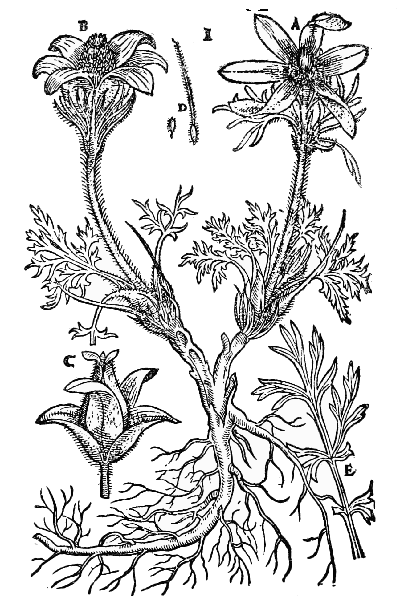
Text-fig. 72. “Pulsatilla” = Anemone pulsatilla L., Pasque-flower [Camerarius, De plantis Epitome ... Matthioli, 1586].
It is curious that Cesalpino, who, as we have pointed152 out, had arrived at the very important principle that the seed and fruit characters were of major value in classification, yet put forward a system which was distinctly inferior to that of Gaspard Bauhin, although the latter appears to have been guided by no such general principles. Probably the reason for this is to be sought in the fact that no system of classification can represent natural affinities, unless it takes into account the nature of the plant as153 a whole. It is true that, compared with the characters of the reproductive organs, the leaf-form and habit, owing to their plasticity, have to be used with great discretion as systematic criteria, but, nevertheless, no system of classification can afford to ignore them entirely. Cesalpino based his scheme too exclusively upon seed characters, to the neglect even of the structure of the flower, and, curiously enough, although he laid so much stress upon the nature of the seed, he did not grasp the fundamental distinction between the embryos of the Monocotyledons and the Dicotyledons, due to the possession of one, and two seed-leaves respectively. The chief drawback of his scheme, however, was his failure to realise that living organisms are too complex to fall into a classification based on any one feature, important as that feature may prove to be when used in conjunction with other characters.
Those herbalists, on the other hand, who attacked the problem of the classification of plants without any preconceived, academic theory, depended, one might almost say, on the glimmerings of common sense for the recognition of affinities. This was no doubt a dim and fitful illumination, but it was at least less partial than the narrow, lime-light beam of a rigid theory.
CHAPTER VII
THE EVOLUTION OF THE ART OF BOTANICAL ILLUSTRATION
 N the art of botanical illustration, evolution was by no means a simple and straightforward process. We do not find, in Europe, a steady advance from early illustrations of poor quality to later ones of a finer character. On the contrary, among the earliest extant drawings, of a definitely botanical intention, we meet with wonderfully good figures, free from such features as would be now generally regarded as archaic. The famous Vienna manuscript of Dioscorides (see pp. 8 and 85) is a remarkable example of the excellence of some of the very early work. It dates back to the end of the fifth, or the beginning of the sixth century of the Christian era. It is illustrated with brush drawings on a large scale, which in many cases are notably naturalistic, and often quite modern in appearance (Plates I, II, XV). The general habit of the plant is admirably expressed, and occasionally, as in the case of the Bean (Plate XV), the characters of the flowers and seed-vessels are well indicated. In this drawing, also, the leaves are effectively foreshortened.
N the art of botanical illustration, evolution was by no means a simple and straightforward process. We do not find, in Europe, a steady advance from early illustrations of poor quality to later ones of a finer character. On the contrary, among the earliest extant drawings, of a definitely botanical intention, we meet with wonderfully good figures, free from such features as would be now generally regarded as archaic. The famous Vienna manuscript of Dioscorides (see pp. 8 and 85) is a remarkable example of the excellence of some of the very early work. It dates back to the end of the fifth, or the beginning of the sixth century of the Christian era. It is illustrated with brush drawings on a large scale, which in many cases are notably naturalistic, and often quite modern in appearance (Plates I, II, XV). The general habit of the plant is admirably expressed, and occasionally, as in the case of the Bean (Plate XV), the characters of the flowers and seed-vessels are well indicated. In this drawing, also, the leaves are effectively foreshortened.
There are a number of other manuscript herbals in existence, illustrated with interesting figures. The Library of the University of Leyden possesses a particularly fine example33, which is ascribed to the seventh century A.D.
This work contains coloured drawings of exceptional beauty, which are smaller than those in the Vienna manuscript, but quite equally realistic.
It is however with the history of botanical figures since the invention of the printing press that we are here more especially concerned. From this epoch onwards, the history of botanical illustration is intimately bound up with the history of wood-engraving, until, at the extreme end of the sixteenth century, engraving on metal first came into use to illustrate herbals. During the seventeenth century, metal-engravings and wood-cuts existed side by side, but wood-engraving gradually declined, and was in great measure superseded by engraving on metal. The finest period of plant illustration was during the sixteenth century, when wood-engraving was at its zenith.
Botanical wood-engravings may be regarded as belonging to two schools, but it should be understood that the distinction between them is somewhat arbitrary and must not be pressed very far. One of these may perhaps be regarded as representing the last, decadent expression of that school of late classical art which, a thousand years earlier, had given rise to the drawings in the Vienna manuscript. Probably no original wood-cuts of this school were produced after the close of the fifteenth century. In the second phase, on the other hand, which culminated, artistically, if not scientifically, in the sixteenth century, we find a renaissance of the art, due to a more direct study of nature.
The first school, of which we may take the cuts in the Roman edition of the ‘Herbarium’ of Apuleius Platonicus (? 1484) as typical examples, has, as Dr Payne has pointed out, certain very well-marked characteristics. The figures of the plants (see Plates IV, V, XVI, and Text-figs. 1 and 2), which occupy square or oblong spaces, are very formal and are often represented with complete bilateral symmetry. They show no sign of having been drawn directly from nature, but look as if they were founded on previous work. They have a decorative rather than a naturalistic appearance; it seems, indeed, as if the principle of decorative symmetry controlled the artist almost against his will. These drawings are somewhat of the nature of156 diagrams by a draughtsman “who generalized his knowledge of the object.” In Dr Payne’s own words, “Such figures, passing through the hands of a hundred copyists, became more and more conventional, till they reached their last and most degraded form in the rude cuts of the Roman Herbarium, which represent not the infancy, but the old age of art. Uncouth as they are, we may regard them with some respect, both as being the images of flowers that bloomed many centuries ago, and also as the last ripple of the receding tide of Classical Art.”
The illustrations of the ‘Herbarium’ of Apuleius were copied from pre-existing manuscripts, and the age of the originals is no doubt much greater than that of the printed work. Those here reproduced are taken from a copy in the British Museum, in which the pictures were coloured, probably at the time when the book was published.
Colouring of the figures was characteristic of many of the earliest works in which wood-engraving was employed. In cases where uncoloured copies of such books exist, there are often blank spaces in the wood-cuts, which were left in order that certain details might afterwards be added in colour. The origin of wood-engraving is closely connected with the early history of playing-card manufacture. Playing-cards were at first coloured by means of stencil plates, and the same method, very naturally, came to be employed in connection with the wood-blocks used for book illustration.
The engravings in the ‘Herbarium’ of Apuleius are executed in black, in very crude outline. At least two colours, now much faded, were also employed by means of stencilling. The work was coarsely done, and the colours only “register” very roughly. Brown appears to have been used for the animals, roots and flowers, and green for the leaves. The drawings show some rather curious mannerisms. For instance, in the first cut labelled “Vettonia,” each of the lanceolate leaves is outlined continuously on the one side, but with a broken line on the other. It has been suggested that the illustrations in the ‘Herbarium’ are possibly not wood-engravings, but rude cuts in metal, excavated after the manner of a wood-block.
Plate XVI
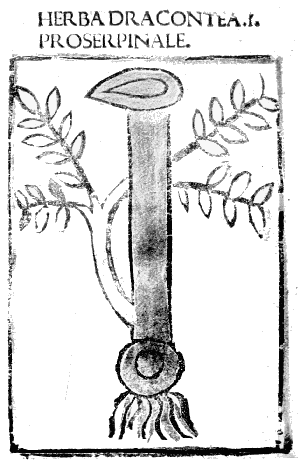
‘Dracontea’ [Herbarium Apuleii Platonici, ? 1484].
The tint represents colouring, which was probably contemporary.
We have already referred to the imaginative portrait of the Mandrake (Plate V). Figures of the animals whose 157bites or stings were supposed to be cured by the use of a particular herb, were often introduced into the drawing, as in the case of the Plantain (Text-fig. 1) which is accompanied by a serpent and a scorpion. In this figure the cross-hatching of white lines on black—the simplest possible device from the point of view of the wood-engraver—is employed with good effect. Sometimes the essential character of the plant is seized, but the way in which it is expressed is curiously lacking in a sense of proportion, as in the case of “Dracontea” (Plate XVI), one of the Arum family.
The figures in the ‘Herbarium’ are characterised by an excellent trait, which is common to most of the older herbals, namely the habit of portraying the plant as a whole, including its roots. This came about naturally because the root was often of special value from the druggist’s point of view. It is to be regretted that, in modern botanical drawings, the recognition of the paramount importance of the flower and fruit in classification has led to a comparative neglect of the organs of vegetation, especially those which exist underground.
We now come to a series of illustrations, which may be regarded as occupying an intermediate position between the classical tradition of the ‘Herbarium’ of Apuleius, and the renaissance of botanical drawing, which took place early in the sixteenth century. These include the illustrations to the ‘Book of Nature,’ and to the Latin and German ‘Herbarius,’ the ‘Ortus Sanitatis,’ and their derivatives, which were discussed in Chapters II and III.
‘Das půch der natur’ of Konrad von Megenberg occupies a unique position in the history of botany, for it is the first work in which a wood-cut representing plants was used with the definite intention of illustrating the text, and not merely for a decorative purpose. It was first printed in Augsburg in 1475, and is thus several years older than the earliest printed edition of the ‘Herbarium’ of Apuleius Platonicus which we have just discussed. The single plant drawing, which illustrates it, is probably not of such great antiquity, however, as those of the ‘Herbarium,’ for its appearance suggests that it was probably executed from nature for this book, and not copied and158 recopied from one manuscript to another before it was engraved. The illustration in question is a full-page wood-cut, showing a number of plants, growing in situ (Plate III). Several species (e.g. Ranunculus acris, the Meadow Buttercup, Viola odorata, the Sweet Violet, and Convallaria majalis, the Lily-of-the-Valley) are distinctly recognisable. It is noticeable that, in two cases in which a rosette of radical leaves is represented, the centre of the rosette is filled in in black, upon which the leaf-stalks appear in white. This use of the black background, which gives a rich and solid effect, was carried much further in later books, such as the ‘Ortus Sanitatis.’
A wood-cut, somewhat similar in style to that just described, but more primitive, occurs in Trevisa’s version of the mediæval encyclopædia of Bartholomæus Anglicus, which was printed by Wynkyn de Worde before the end of the fifteenth century. It is probably the first botanical159 figure illustrating an English book. It is reproduced in Text-fig. 19.
The illustrations to the Latin ‘Herbarius’ or ‘Herbarius Moguntinus,’ published at Mainz in 1484 (Text-figs. 3, 4, 5, 73), form the next group of botanical wood-cuts. The figures are much better than those of the ‘Herbarium’ of Apuleius, but at the same time they are, as a rule, formal and conventional, and often quite unrecognisable. The want of realism is very conspicuous in such a drawing as that of the Lily (Text-fig. 3), in which the leaves are represented as if they had no organic continuity with the stem. Some of the figures are wonderfully charming, and in their160 decorative effect recall the plant designs so often used in the Middle Ages to enrich the borders of illuminated manuscripts. This is particularly noticeable in the case of the Briony (Text-fig. 73). The conventional form of tendril here employed is also seen in other early work, such as the roof-painting of a Vine in the Chapel of St Andrew, Canterbury Cathedral, and some “Decorated” stained glass at Wells, both of which are considerably earlier in date than the ‘Herbarius Moguntinus.’
![Text-fig. 75. “Capillus Veneris” = Maidenhair Fern [Arnaldus de Villa Nova, Tractatus de virtutibus herbarum, 1499].](images/i_213.png)
Text-fig. 75. “Capillus Veneris” = Maidenhair Fern [Arnaldus de Villa Nova, Tractatus de virtutibus herbarum, 1499].
A more interesting series of figures, also illustrating the text of the Latin ‘Herbarius,’ was published in Italy a little later. The wood-cuts are believed to be mostly derived from German originals. Text-figs. 6, 57, 65, 74, 75 and 76161 are taken from a Venetian edition of 1499. These drawings are more ambitious than those in the original German issue, and, on the whole, the results are more naturalistic. The fern called “Capillus Veneris,” which is probably intended for the Maidenhair, is represented hanging from rocks over water, just as it does in Devonshire caves to-day (Text-fig. 75). Another delightful wood-cut, almost in the Japanese style, is that of an Iris growing at the margin of a stream, from which a graceful bird is drinking (Text-fig. 74).
In the very symmetrical drawing of the Peony (Text-fig. 57) there is an attempt to represent the tuberous roots, which are indicated in solid black. The no less symmetrical162 Waterlily (Text-fig. 65) is remarkable for its rhizome, on which the scars of the leaf bases are faithfully represented. This drawing is of interest, also, on account of its frank disregard of proportion. The flower stalks are drawn not more than twice as long as the breadth of the leaf! We may, I think, safely conclude that the draughtsman knew quite well that he was not representing the plant as it was, and that he intentionally gave a conventional rendering, which did not profess to be more than an indication of certain distinctive features of the plant. This attitude of the artist to his work, which is so different from that of the scientific draughtsman of the present day, is seen with great clearness in many of the drawings in mediæval manuscripts. For instance, a plant such as the Houseleek may be represented growing on the roof of a house—the plant being about three times the size of the building. No one would imagine that the artist was under the delusion that these proportions held good in nature. The little house was merely introduced in order to convey graphic information as to the habitat of the plant concerned, and the scale on which it was depicted was simply a matter of convenience. Before an art can be appreciated, its conventions must be accepted. It would be as absurd to quarrel with the illustrations we have just described, on account of their lack of proportion, as to condemn grand opera because, in real life, men and women do not converse in song. The idea of naturalistic drawings, in which the size of the parts should be shown in their true relations, was of comparatively late growth.
In 1485, the year following the first appearance of the Latin ‘Herbarius,’ the very important work known as the German ‘Herbarius,’ or ‘Herbarius zu Teutsch,’ made its appearance at Mainz. As we pointed out in Chapter II, its illustrations, which are executed on a large scale, are often of remarkable beauty. Dr Payne considered some of them comparable to those of Brunfels in fidelity of drawing, though very inferior in wood-cutting. They are distinctly more realistic than even those of the Venetian edition of the Latin ‘Herbarius,’ to which we have just referred. It is interesting, for instance, to compare the drawings of the Dodder (Text-figs. 76 and 77) in the two 163-165works. Other excellent drawings are those of the Winter Cherry (Text-fig. 78), Iris (Text-fig. 7), Lily, Chicory, Comfrey and Peony.
A pirated second edition of the ‘Herbarius zu Teutsch’ appeared at Augsburg only a few months after the publication of the first at Mainz. The figures, which are roughly copied from those of the original edition, are very inferior to them. In fact, the Mainz wood-cuts of 1485 excel those of all subsequent issues.
In the ‘Ortus Sanitatis’ of 1491, about two-thirds of the drawings of plants are copied from the ‘Herbarius zu Teutsch.’ They are often much spoiled in the process, and it is evident that the copyist frequently failed to grasp166 the intention of the original artist. The wood-cut of the Dodder (Text-fig. 80), for instance, is lamentably inferior to that in the ‘Herbarius zu Teutsch’ (Text-fig. 77). There is often a tendency, in the later work, to make the figures occupy the space in a more decorative fashion; for instance, where the stalk in the original drawing is simply cut across obliquely at the base, we find in the ‘Ortus Sanitatis’ that its pointed end is continued into a conventional flourish (cf. the figures of the Winter Cherry in the two works, Text-figs. 78 and 79). Among the original figures many, as we have already indicated, represent purely mythical subjects (e.g. Text-figs. 13 and 17).
The use of a black background, against which the stalks167 and leaves form a contrast in white, which we noticed in the ‘Book of Nature,’ is carried further in the ‘Ortus Sanitatis.’ This is shown particularly well in the Tree of Paradise (Text-fig. 12) and also in Text-figs. 10 and 81. No consistent method is followed in the coarse shading which is employed. In some cases there seems to have been an attempt at the convention, used so successfully by the Japanese, of darkening the underside of the leaf, but, sometimes, in the same figure, certain leaves are treated in this way, and others not. In some of the genre pictures, Noah’s Ark trees are introduced, with crowns consisting entirely of parallel horizontal lines, decreasing in length from below upwards, so as to give a triangular form.
An edition of the ‘Ortus Sanitatis,’ which was published168 in Venice in 1511, is illustrated in great part with wood-cuts based on the original figures. They have, however, a very different appearance, since a great deal of shading is introduced, and in some cases parallel lines are laid in with considerable dexterity.
‘The Grete Herball’ and a number of works of the early sixteenth century derived from the ‘Herbarius zu Teutsch,’ the ‘Ortus Sanitatis,’ and similar sources, are of no importance in the history of botanical illustration, since scarcely any of their figures are original. The oft-repeated set of wood-cuts, ultimately derived from the ‘Herbarius zu Teutsch,’ were also used to illustrate Hieronymus Braunschweig’s Distillation Book (Liber de arte distillandi de Simplicibus, 1500). That the conventional figures of the period did not satisfy the botanist is shown by some interesting remarks by Hieronymus at the conclusion of his work. He tells the reader that he must attend to the text rather than the figures, “for the figures are nothing more than a feast for the eyes, and for the information of those who cannot read or write34.”
During the first three decades of the sixteenth century, the art of botanical illustration was practically in abeyance in Europe. Such books as were published were chiefly supplied with mere copies of older wood-cuts. But, in 1530, an entirely new era was inaugurated with the appearance of Brunfels’ great work, the ‘Herbarum vivæ eicones,’ in which a number of plants native to Germany, or commonly cultivated there, were drawn with a beauty and fidelity which have rarely been surpassed (Text-figs. 22, 23, 24, 25, 66, 82, 83, 84). It is interesting to recall that the date 1530 is often taken, in the study of other arts (e.g. stained glass), as the limit of the “Gothic” period, and the beginning of the “Renaissance.”
Plate XVII
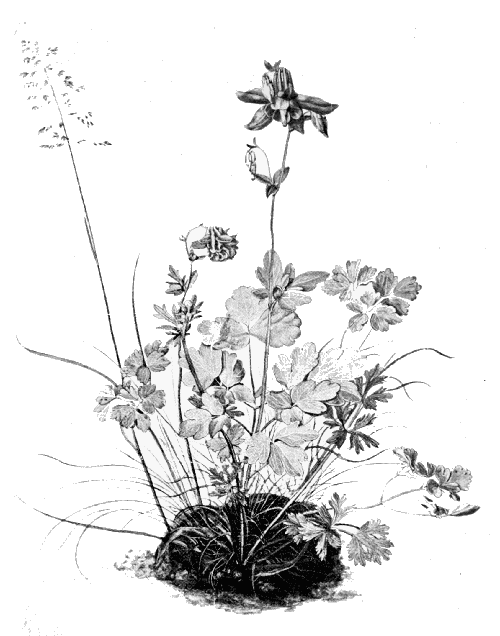
Study of Aquilegia vulgaris L., Columbine [Albrecht Dürer, 1526. Drawing in the Albertina, Vienna]. Reduced.
Brunfels’ illustrations represent a notable advance on any previous botanical wood-cuts, so much so, indeed, that the suddenness of the improvement seems to call for some special explanation. On taking a broader view of the subject, we find that, at the beginning of the sixteenth century, there was a marked advance in all the branches of 169book illustration, and not merely in the botanical side with which we are here concerned. This impetus seems to have been due to the fact that many of the best artists, above all Albrecht Dürer, began at that period to draw for wood-engraving, whereas in the fifteenth century the170 ablest men had shown a tendency to despise the craft and to hold aloof from it.
The engravings in Brunfels’ herbal and the fine books which succeeded it, should not be considered as if they were an isolated manifestation, but should be viewed in relation to other contemporary and even earlier plant drawings, which were not intended for book illustrations. Some of the most remarkable are those by Albrecht Dürer, which were produced before the appearance of Brunfels’ herbal, during the first thirty years of the sixteenth century. In each of his coloured drawings of sods of turf, known as “das grosse Rasenstück,” and “das kleine Rasenstück,” a tangled group of growing plants is portrayed exactly as it occurred in nature, with a marvellous combination of artistic charm and scientific accuracy. Prof. Killermann has been at pains to identify the genus and species of almost every plant represented, and has described the drawings as “das erste Denkmal der Pflanzenökologie.” In 1526, Dürer carried out a beautiful series of plant drawings, among the most famous of which are those of the Columbine, and the Greater Celandine. The former is reproduced on a small scale in Plate XVII; it is scarcely possible to imagine a more perfect “habit drawing” of a plant.
In Italy, Leonardo da Vinci’s exquisite studies of plants, of which Plate XVIII is an example, must also have pointed the way to a better era of herbal illustration. In his work, the artistic interest predominates over the botanical to a greater extent than is the case with Dürer’s drawings. It is strange to think that numerous editions of the ‘Ortus Sanitatis’ and similar books, with their crude and primitive wood-cuts, should have been published while such an artist as Leonardo da Vinci was at the zenith of his powers. If internal evidence alone were available, it might plausibly be maintained that the engravings in the ‘Ortus Sanitatis’ and the drawings of Leonardo da Vinci were centuries apart.
Plate XVIII

Study of Ornithogalum umbellatum L., Star of Bethlehem, and other plants [Leonardo da Vinci, 1452-1519. Drawing in the Royal Library, Windsor].
We are thus led to the conclusion that, though the engravings in Brunfels’ herbal are separated from previous botanical figures by an almost impassable gulf, they should not be regarded as a sudden and inexplicable development. The art of naturalistic plant drawing had arrived 171independently at what was perhaps its high-water mark of excellence, but it is in Brunfels’ great work that we find it, for the first time, applied to the illustration of a botanical book.
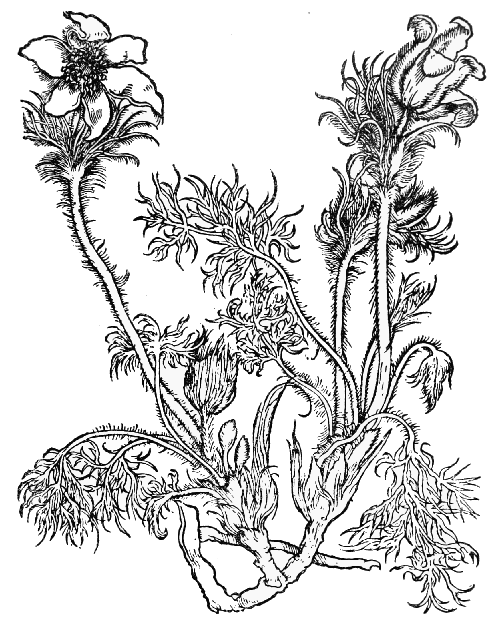
Text-fig. 83. “Kuchenschell” = Anemone pulsatilla L., Pasque-flower [Brunfels, Herbarum vivæ eicones, Vol. I. 1530]. Reduced.
The illustrations in Brunfels’ herbal were engraved, and probably drawn also, by Hans Weiditz, or Guiditius, some of whose work has been ascribed to Albrecht Dürer.172 The title ‘Herbarum vivæ eicones’—‘Living Pictures of Plants’—indicates the most distinctive feature of the book, namely that the artist went direct to nature, instead of regarding the plant world through the eyes of previous draughtsmen. This characteristic is best appreciated on comparing Brunfels’ figures with those of his predecessors. His picture of the Waterlily (Text-fig. 66), for example, contrasts notably with that of the same subject from the Venetian ‘Herbarius’ (Text-fig. 65). In the former the artist has caught the exact look of the leaves and stalks, buoyed up by the water. Throughout the work, the drawing seems to be of a slightly higher quality than the actual engraving; the lines are, to use the technical term, occasionally somewhat “rotten” or even broken.
In one respect the welcome reaction from the conventional and generalised early drawings went almost too far. Many of Brunfels’ wood-cuts were done from imperfect specimens, in which, for example, the leaves had withered or had been damaged by insects. This is clearly shown in Text-fig. 84. The artist’s ambition was evidently limited to representing the specimen he had before him, whether it was typical or not. The notion had not then been grasped that the ideal botanical drawing avoids the peculiarities of any individual specimen, and seeks to portray the characters really typical of the species. These characters can sometimes only be arrived at by a comparison of numerous specimens.
From the figures here reproduced a good idea of the style of Weiditz can be obtained. His line is usually firm and broad, and but little shading is employed. The chief merit of the drawings lies in their crisp and virile outlines.
Regarded from the point of view of decorative book illustration, the beautiful drawings of the period under consideration sometimes failed to reach the standard set by earlier work. The very strong, black, velvety line of many of the fifteenth-century wood-engravings, and the occasional use of solid black backgrounds (cf. Text-fig. 81) give a great sense of richness, especially in combination with the black letter type, with which they harmonise so admirably. A page bearing such illustrations is often more satisfying to the eye than one in which the desire to express 173-174the subtleties of plant form, in realistic fashion, has led to the use of a more delicate line. However, the primary object of the herbal illustrations was, after all, a scientific and not a decorative one, and, from this point of view, the gain in realism more than compensates for the loss in the harmonious balance of black and white.
Our chronological survey of the chief botanical wood-cuts brings us next to those published by Egenolph in 1533, to illustrate Rhodion’s ‘Kreutterbůch.’ These have sometimes been regarded as of considerable importance, almost comparable, in fact, with those of Brunfels. A careful examination of these wood-engravings leads, however, to the conclusion that practically all the chief figures in Egenolph’s book have been copied from those of Brunfels, but on a smaller scale, and reversed. It is true that the style of engraving is different, and that, as Hatton has pointed out, Egenolph’s flowing, easy, almost brush-like line is very distinct from that of Weiditz. But the fact of175 the plagiarism remains. The two figures here reproduced—the Lesser Celandine (Text-fig. 33) and the Hart’s-tongue Fern (Text-fig. 85)—are reduced copies from Brunfels.
It is interesting to notice that, as the third part of Brunfels’ great work had not appeared when Egenolph’s book was published, the latter must have been at a loss for figures of the plants which Brunfels had reserved for his third volume. We find that in the case of one such plant, the Asparagus, he solved the problem by going back to the old familiar wood-cut which had done duty in the ‘Ortus Sanitatis’ and the ‘Herbarius zu Teutsch.’
In the third volume of Brunfels’ herbal (which appeared after his death) there is a small figure, that of “Auricula muris,” which differs conspicuously in style from the other engravings, and which appears to represent a case in which the tables were turned, and a figure was borrowed from Egenolph.
In his later books, Egenolph used wood-cuts pirated from those of Fuchs and Bock, which we must now consider.
In the work of Leonhard Fuchs (Frontispiece) plant drawing, as an art, may be said to have reached its culminating point. It is true that, at a later period, when the botanical importance of the detailed structure of the flower and fruit was recognised, figures were produced which conveyed exacter and more copious information on these points than did those of Fuchs. Nevertheless, at least in the opinion of the present writer, the illustrations to Fuchs’ herbals (‘De historia stirpium,’ 1542, and ‘New Kreüterbůch,’ 1543) represent the high-water mark of that type of botanical drawing which seeks to express the individual character and habit of each species, treating the plant broadly as a whole, and not laying more stress upon the reproductive than the vegetative organs.
Fuchs’ figures are on so large a scale that the plant frequently had to be represented as curved, in order to fit it into the folio page. The illustrations here reproduced (Text-figs. 30, 31, 32, 58, 69, 70, 86, 87, 88) do not give an entirely just idea of their beauty, since the line employed in the original is so thin that it is ill-adapted to the reduction 176-177necessary here. If the drawings have any fault, it is perhaps to be found in the somewhat blank and unfinished look, occasionally produced when unshaded outline drawings are used on so large a scale. This is the case for instance in the figure of the Aloe. It may be that Fuchs had in mind the possibility that the purchaser might wish to colour the work, and to fill in a certain amount of detail for himself. The existing copies of this and other old herbals often have the figures painted, generally in a distressingly crude and heavy fashion. The colouring in many cases appears to have been done at a very early date. In the octavo edition of Fuchs’ herbal published in 1545, small versions of the large wood-cuts appeared. It is perhaps invidious to draw distinctions between the work of Fuchs and that of Brunfels, since they are both of such exquisite quality. However, merely as an expression of personal opinion, the present writer must confess to feeling that there is a finer sense of power and freedom of handling about the illustrations in Fuchs’ herbal than those of Brunfels.
Sometimes in Fuchs’ figures a wonderfully decorative spirit is shown, as in the case of the Earth-nut Pea (Text-fig. 87) which fills the rectangular space almost in the manner of an “all-over” wall-paper pattern. It must not be forgotten, when discussing wood-cuts, that the artist, who drew upon the block for the engraver, was working under peculiar conditions. It was impossible for him to be unmindful of the boundaries of the block, when these took the form, as it were, of miniature precipices under his hand. These boundaries marked out the exact limit of space which the figure could occupy. It is not surprising, under these circumstances, that the artist who drew upon the block should often seem to have been obsessed by its rectangularity, and should have accommodated his drawing to its form in a way that was unnecessary and far from realistic, though sometimes very decorative. This is exemplified in the figure of the Earth-nut Pea, to which we have just referred and also in Text-figs. 41, 44, 62, 92, 95, 101, etc. The writer has been told by an artist accustomed, in former years, to draw upon the wood for the engraver, that to avoid a rectangular effect required a distinct effort of will. At the present day, when 178-180photographic methods of reproduction are almost exclusively used, the artist is no longer oppressively conscious of the exact outline of the space which his figure will occupy.
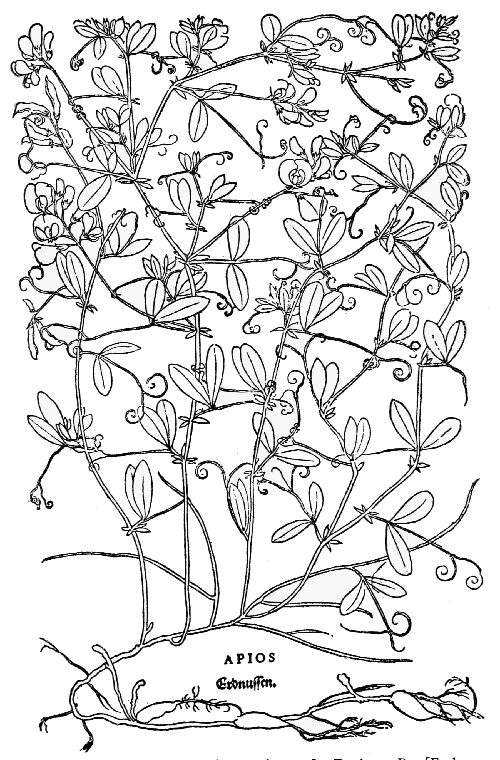
Text-fig. 87. “Apios” = Lathyrus tuberosus L., Earth-nut Pea [Fuchs, De historia stirpium, 1542]. Reduced.
The figures here reproduced show how great a variety of subjects were successfully dealt with in Fuchs’ work. The Cabbage (Text-fig. 30) is realised in a way that brings home to us the intrinsic beauty of this somewhat prosaic subject. In the Wild Arum (Text-fig. 88) the fruit and a dissection of the inflorescence are represented, so that, botanically, the drawing reaches a high level. Fuchs’ wood-cuts are nearly all original, but that of the White Waterlily appears to have been founded upon Brunfels’ figure.
We have so far spoken, for the sake of brevity, as if Fuchs actually executed the figures himself. This, however, was not the case. He employed two draughtsmen, Heinrich Füllmaurer, who drew the plants from nature, and Albrecht Meyer, who copied the drawings on to the wood, and also an engraver, Veit Růdolf Speckle, who actually cut the blocks. Fuchs evidently delighted to honour his colleagues, for at the end of the book there are portraits of all three at work (Text-fig. 89). The artist is drawing a plant with a brush fixed in a quill.
The drawing and painting of flowers is sometimes dismissed almost contemptuously, as though it were a humble art in which an inferior artist, incapable of the more exacting work of drawing “from the life,” might be able to excel. The falsity of this view is shown by the fact that the greatest of flower painters have generally been men who also did admirable figure work. Fantin-Latour is a striking modern instance, and one has but to glance at the studies of Leonardo da Vinci (e.g. Plate XVIII) and Albrecht Dürer (e.g. Plate XVII) to feel that the finest plant drawings can only be produced by a master hand, capable of achieving success on more ambitious lines. The wood-engravings in Fuchs’ herbal are a case in point. The portraits which also illustrate the book (Frontispiece and Text-fig. 89) show that the talents of the artists whom he employed were not confined to plant drawing, but were also strong in the direction of vigorous and able portraiture.
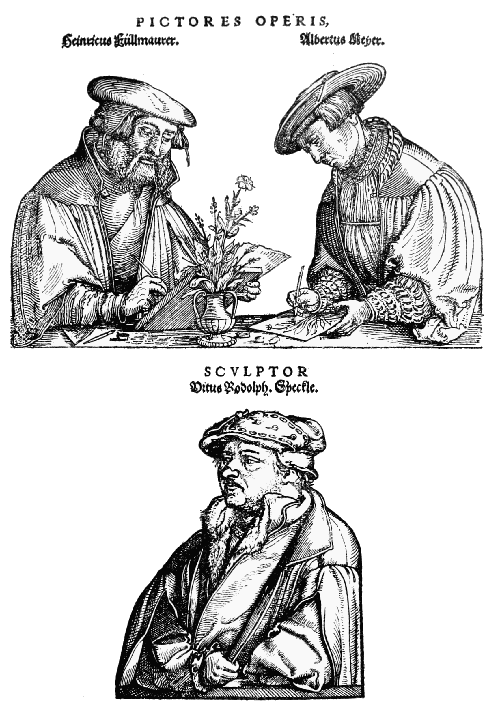
Text-fig. 89. The Draughtsmen and the Engraver employed by Leonhard Fuchs [De historia stirpium, 1542]. Reduced.
 Text-fig. 91. “Rautten” = Botrychium, Moonwort [Bock, Kreuter Bůch, 1546]. Fuchs’ gratitude to his assistants is expressed in the preface to ‘De historia stirpium,’ where he makes some183 remarks upon the illustrations, which may be translated as follows:—
Text-fig. 91. “Rautten” = Botrychium, Moonwort [Bock, Kreuter Bůch, 1546]. Fuchs’ gratitude to his assistants is expressed in the preface to ‘De historia stirpium,’ where he makes some183 remarks upon the illustrations, which may be translated as follows:—
“As far as concerns the pictures themselves, each of which is positively delineated according to the features and likeness of the living plants, we have taken peculiar care that they should be most perfect, and, moreover, we have devoted the greatest diligence to secure that every plant should be depicted with its own roots, stalks, leaves, flowers, seeds and fruits. Furthermore we have purposely and deliberately avoided the obliteration of the natural form of the plants by shadows, and other less necessary things, by which the delineators sometimes try to win artistic glory: and we have not allowed the craftsmen so to indulge their whims as to cause the drawing not to correspond accurately to the truth. Vitus Rudolphus Specklin, by far the best engraver of Strasburg, has admirably copied the wonderful industry of the draughtsmen, and has with such excellent craft expressed in his engraving the features of each drawing, that he seems to have contended with the draughtsman for glory and victory.”
How dull and colourless the phrases of modern scientific writers appear, beside the hot-blooded, arrogant enthusiasm of the sixteenth century!
Fuchs’ wood-cuts were 184extensively pirated, especially those on a reduced scale, which were published in his edition of 1545. As we have mentioned on p. 55, Hieronymus Bock [or Tragus] undoubtedly made use of them in the second edition of his ‘Kreuter Bůch’185 (1546) which was the next important, illustrated botanical work to appear after Fuchs’ herbal. An examination of the wood-cuts in Bock’s herbal seems, however, to show that his illustrations have more claim to originality than is often supposed. The figures of Wintergreen (Text-fig. 90), Moonwort (Text-fig. 91), and Strawberry (Text-fig. 27), here reproduced, are markedly different from those of Fuchs, although, in the case of the first, Fuchs’ wood-cut may have been used to some extent. The artist employed by Bock, as he himself tells us, was David Kandel, a young lad, the son of a burgher of Strasburg. His drawings are often of interest, apart from their botanical aspect. For instance, the picture of an Oak tree includes, appropriately enough, a swine-herd with his swine, the Chestnut tree gives occasion for a hedgehog (Text-fig. 92) and, in another case, a monkey and several rabbits are introduced, one of the latter holding a shield bearing the artist’s initials. The wood-cut of Trapa, the Bull-nut (Text-fig. 29), is a highly imaginative production which clearly shows that neither the artist nor the author had ever seen the plant in question.
In general character, Bock’s illustrations are neater and more conventional than those of Brunfels or Fuchs. The crowns of the trees are often made practically square so as186 to fit the block (Text-fig. 92). The figures in earlier works, such as the ‘Ortus Sanitatis,’ are recalled in Kandel’s disregard of the proportion between the size of the tree, and that of the leaves and fruits.
In point of time, the illustrations to the early editions of Mattioli’s Commentaries on the Six Books of Dioscorides follow fairly closely on those of Fuchs, but they are187 extremely different in style (Text-figs. 41, 42, 93, 94). Details such as the veins and hairs of the leaves are often elaborately worked out, while shading is much used, a considerable mastery of parallel lines being shown. The general effect is occasionally somewhat flat and dull. Some of the drawings suggest that they may have been done from dried plants, and in others the treatment is188 over-crowded. But, in spite of these defects, they form a markedly individual contribution, which is of great importance in the history of botanical illustration.
Numerous editions of Mattioli’s work appeared in various languages. In its earlier form the book had only small figures (e.g. Text-figs. 41, 42, 93, 94), but in some later editions, notably that which appeared at Venice in

Text-fig. 97. “Aconitum luteum minus” = Eranthis hiemalis L., Winter Aconite [Dodoens, Pemptades, 1583].
1565, there are large illustrations which are reproduced on a reduced scale in Text-figs. 43, 44, 95. These wood-cuts resemble the smaller ones in character, but are more decorative in effect, and often remarkably fine. Whereas in the work of Brunfels and Fuchs, the beautiful line of a single stalk is often the key-note of the whole drawing,190 in the work of Mattioli, the eye most frequently finds its satisfaction in the rich massing of foliage, fruit and flowers, suggestive of southern luxuriance. Many of his figures would require little modification to form the basis of a tapestry pattern.
Another remarkable group of wood-engravings consists of those published by Plantin in connection with the work of the three Low Country herbalists, Dodoens, de l’Écluse and de l’Obel. In the original edition of Dodoens’ herbal (‘Crǔÿdeboeck,’ published by Vanderloe in 1554), more than half the illustrations were taken from Fuchs’ octavo edition of 1545. But eventually, as we have pointed out in Chapter IV, Vanderloe parted with Fuchs’ blocks. After this, Plantin took over the publication of Dodoens’ books, and in his final collected works (‘Stirpium historiæ pemptades sex,’ 1583) the majority of the illustrations were original, and were carried out under the author’s eye (Text-figs. 37, 38, 96, 97). A few (namely those marked in the Pemptades, “Ex Codice Cæsareo”) are copied from Juliana Anicia’s manuscript of Dioscorides to which we have more than once referred. Some are also borrowed from the works of de l’Écluse and de l’Obel, since Plantin was publisher to all three botanists, and the wood-blocks engraved for them were regarded as, to some extent, forming a common stock. In fact it is often difficult to decide to which author any given figure originally belonged. This difficulty is enhanced by the fact that some were actually made for one and then used for another, before the work for which they had been originally destined was published.
There is little to be said about de l’Obel’s figures, which partook of the character of the rest of the wood-cuts for which Plantin made himself responsible. The Yellow Waterlily (Text-fig. 67) is given here as an example.
The wood-cuts illustrating the comparatively small books of de l’Écluse are perhaps the most interesting of the figures associated with this trio of botanists. The Dragon Tree (Text-fig. 98), “Sedum majus” (Text-fig. 59) and Job’s Tears (Text-fig. 39) are examples from his book on the plants of Spain, which appeared in 1576.
The popularity of the large collection of blocks got191 together by the publishing house of Plantin is shown by the frequency with which they were copied. Dr B. Daydon Jackson has pointed out that the wood-cut of the Clematis, which first appeared in Dodoens’ ‘Pemptades’ of 1583, reappears, either in identical form, or more or192 less accurately copied, in works by de l’Obel, de l’Écluse, Gerard, Parkinson, Jean Bauhin, Chabræus and Petiver. The actual blocks themselves appear to have been used for the last time when Johnson’s edition of Gerard’s herbal made its final appearance in London in 1636.
Another school of plant illustration is represented in the work of Gesner and Camerarius. As we mentioned on p. 92, Gesner’s drawings were not published during his life-time, but some of them were eventually produced193 by Camerarius, with the addition of figures of his own, to illustrate his ‘Epitome Matthioli’ of 1586 (Text-figs. 72 and 99) and also his later work. In 1751, C. J. Trew published a collection of Gesner’s drawings, many of which had never been seen before; but even then, it proved impossible to separate the work of the two botanists with any completeness, since Gesner’s drawings and blocks had passed through the hands of Camerarius, who had incorporated his own with them. A few wood-cuts however, which appeared as an appendix to Simler’s Life of Gesner, are undoubtedly Gesner’s own work. One of these is reproduced in Text-fig. 48.
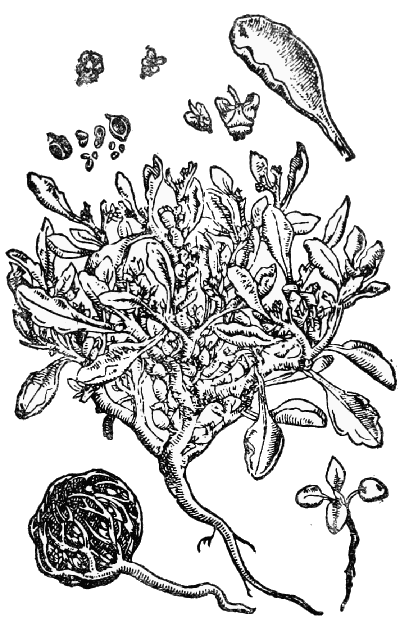
Text-fig. 100. “Rosa Hierichuntica” = Anastatica hierochuntica L., Rose of Jericho [Camerarius, Hortus medicus, 1588].
Professor Treviranus, whose work on the use of wood-engravings as botanical illustrations is so well known, considered that some of the drawings published by Camerarius in connection with his last work (‘Hortus medicus et philosophicus,’ 1588) were among the best ever produced. Examples are shown in Text-figs. 34, 35, 71, 100. Treviranus pointed out that one of their great merits lay in the selection of good, typical specimens as models. These figures are very much more botanical than those of any previous author; in fact—as Hatton has pointed out195 in ‘The Craftsman’s Plant-Book’—they are beginning to become too botanical for the artist! Camerarius often gives detailed analyses of the flowers and fruit on an enlarged196 scale (Text-fig. 99). Among the illustrations here reproduced will be seen one (Text-fig. 100) in which the seedling of the Rose of Jericho is drawn side by side with the mature plant, and another (Text-fig. 35) in which the structure of a germinating Date is shown with great clearness. This interest in seedlings gives a modern touch to the work of Camerarius.
A number of wood-blocks were cut at Lyons to illustrate d’Aléchamps’ great work, the ‘Historia generalis plantarum,’ 1586-7. Many of these figures were taken from the herbals of Fuchs, Mattioli and Dodoens, but they were often embellished with representations of insects, and detached leaves and flowers, scattered over the block with no apparent object except to fill the space. This peculiarity, which is shown in the engraving of Ornithogalum reproduced in Text-fig. 51, appears also in the illustrations of a book on Simples, by Joannes Mesua, published in Venice in 1581. In certain other wood-cuts in d’Aléchamps’ herbal, solid black is used in an effective fashion. This is the case for instance in Text-fig. 101, which is also interesting since two of the leaves bear the initials “M” and “H,” which were possibly those of the artist.
Among less important botanical wood-engravings of the sixteenth century we may mention those in the works of Pierre Belon, such as ‘De arboribus’ (1553). In this book there are some graceful wood-cuts of trees, one of which is reproduced in Text-fig. 102. The initial letters used in the present volume are taken from another of Belon’s books35.
Some specimens of the quaint little illustrations to Castor Durantes ‘Herbario Nuovo’ of 1585 are shown in Text-figs. 45, 68 and 103. It is interesting to compare his drawing of the Waterlily (Text-fig. 68) with those of the Venetian edition of the Latin ‘Herbarius’ of 1499 (Text-fig. 65), ‘The Grete Herball’ (Text-fig. 21), Brunfels’ ‘Herbarum vivæ eicones’ of 1530 (Text-fig. 66) and de l’Obel’s ‘Kruydtbœck’ of 1581 (Text-fig. 67).
The engravings in Porta’s ‘Phytognomonica’ (1588) and in Prospero Alpino’s little book on Egyptian plants (1592) are of good quality. Some curious examples of the 197former, which will be discussed at greater length in the next chapter, are shown in Text-figs. 109 and 110, and the Glasswort, one of the best wood-cuts among the latter, is reproduced in Text-fig. 47.
Passing on to the seventeenth century, we find that the ‘Prodromos’ of Gaspard Bauhin (1620) contains a number of original illustrations, but they are not very remarkable, and often have rather the appearance of having been drawn from pressed specimens. Two examples of these wood-cuts will be found in Text-figs. 49 and 62. The former is interesting as being an early representation of the Potato.
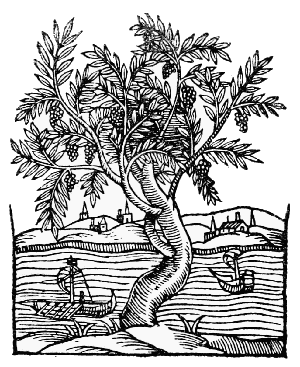
Text-fig. 103. “Lentisco del Peru” = Pistacia lentiscus L., Mastic Tree [Durante, Herbario Nuovo, 1585].
Parkinson’s ‘Paradisus Terrestris’ of 1629 contains a considerable proportion of original figures, besides others borrowed from previous writers. The engravings were made in England by Switzer. They are poor in quality, and the innovation of representing a number of species in one large wood-cut is not very successful. Text-fig. 55 shows a twig of Barberry, which is but a single item in one of these large illustrations.
Among still later wood-engravings, we may mention the large, rather coarse cuts in Aldrovandi’s ‘Dendrologia’ of 1667, one of which, the figure of the Orange, or “Mala Aurantia Chinensia,” is reproduced in Text-fig. 104, on a greatly reduced scale.
In the present chapter no attempt has been made to discuss the illustrations of those herbals (e.g. the works of Turner, Tabernæmontanus, Gerard, etc.) in which most of the wood-cuts are copied from previous books. In the majority of such cases, the source of the figures has already been indicated in Chapter IV.
This brief review of the history of botanical wood-cuts leads us to the conclusion that between 1530 and 1630, that is to say during the hundred years when the herbal was at its zenith, the number of sets of wood-engravings which were pre-eminent—either on account of their intrinsic qualities, or because they were repeatedly copied from book to book—was strictly limited. We might almost say that there were only five collections of wood-cuts of plants of really first-rate importance—those, namely, of Brunfels, Fuchs, Mattioli, and Plantin, with those of Gesner and Camerarius, all of which were published in the sixty years between 1530 and 1590. The wood-blocks of the two botanists last mentioned cannot be considered apart from one another; from the scientific point of view they show a marked advance, in the introduction of enlarged sketches of the flowers and fruit, in addition to the habit drawings. Plantin’s set included those blocks which were engraved for the herbals of de l’Obel, de l’Écluse, and the later works of Dodoens.
At the close of the sixteenth century, wood cutting on the Continent was distinctly on the wane, and had begun to be superseded by engraving on metal. The earliest botanical work, in which copper-plate etchings were used as illustrations, is said to be Fabio Colonna’s ‘Phytobasanos’ of 1592. These etchings, two of which are shown in Text-figs. 46 and 105, are on a small scale, but are extremely beautiful and accurate. The details of the flowers and fruit are often shown separately, the figures, in this respect, being comparable with those of Gesner and Camerarius, though, owing to their small size, they do not convey so much botanical information. In a later book of Colonna’s, the ‘Ekphrasis,’ analyses of the floral parts are given in even greater detail than in the ‘Phytobasanos.’ Colonna expressly mentions that he used wild plants as models wherever possible, because cultivation is apt to produce200 alterations in the form. The decorative border, surrounding each of the figures reproduced, was not printed from the copper.
In the seventeenth century, a large number of botanical books, illustrated by means of copper-plates, were produced. The majority of these were published late in the century, and thus scarcely come within our purview. A few of the earlier ones may, however, be referred to at this point. In 1611 Paul Renaulme’s ‘Specimen Historiæ Plantarum’ was published in Paris, but though this work was illustrated with good copper-plates, the effect was somewhat spoilt by the transparency of the paper. Two years later appeared the ‘Hortus Eystettensis,’ by Basil Besler, an apothecary of Nuremberg. It is a large work with enormous illustrations, mostly of mediocre quality. In the succeeding year, 1614, a book was published which has been described, probably with justice, as containing some of the best copper-plate figures of plants ever produced. This was the ‘Hortus Floridus’ of Crispian de Passe, a member of a famous family of engravers. Like Parkinson’s ‘Paradisus Terrestris,’ into which some of the figures are copied, it is more of the nature of a garden book than a herbal.
In 1615 an English edition of Crispian de Passe’s work was published at Utrecht, under the title of ‘A Garden of Flowers.’ The plates are the same as those in the original work. The artist is particularly successful with the bulbous and tuberous plants, the cultivation of which has long been such a specialty of Holland. Plate XIX is a characteristic example, but only part of the original picture is here reproduced. The soil on which the plants grow is often shown, and the horizon is placed very low, so that they stand up against the sky. This convention seems to have been characteristic, not only of the plant drawings of the Dutch artists, but also of their landscapes. In the paintings of Cuyp and Paul Potter, the sky-line is sometimes so low that it is seen between the legs of the cows and horses. This treatment was no doubt suggested by life in a flat country, but it was carried to such an extreme that the artist’s eye-level must have been almost on the ground!
The purchaser of ‘The Garden of Flowers’ receives detailed directions for the painting of the figures, which he201 is expected to carry out himself. The book is divided into four parts, appropriate to the four seasons, and each part is preceded by an encouraging verse intended to keep alive202 the owner’s enthusiasm for his task. The stanza at the beginning of the last section seems to show some anxiety on the part of the author, lest the reader should have begun to weary over the lengthy occupation of colouring the plates. It reads as follows:—
As we have already mentioned, it is not our intention to deal with the books published in the latter part of the seventeenth century. We may, however, for the sake of completeness, mention two or three examples in order to show the kind of work that was then being done. Paolo Boccone’s ‘Icones et Descriptiones’ of 1674 was illustrated with copper-plates, some of which were remarkably subtle and delicate, while others were rather carelessly executed. Among slightly later works, we may refer to a quaint little Dutch herbal by Stephen Blankaart, and to the ‘Paradisus Batavus’ of Paul Hermann, both of which belong to the last decade of the century. The latter, which is an “Elzevir” with very good copper-plates, was published after the author’s death, and dedicated, by his widow, to Henry Compton, Bishop of London.
In the plates which illustrate Blankaart’s herbal, a landscape and figures are often introduced to form a background, and the low horizon, to which we referred in speaking of the ‘Hortus Floridus,’ is a very conspicuous feature. The picture of the Winter Cherry is here reproduced as an example (Text-fig. 106). As showing the complete revolution in the style of plant illustration in two hundred years, it is interesting to compare this drawing with that of the same subject in the German ‘Herbarius’ of 1485 (Text-fig. 78). It must be confessed that the fifteenth-century wood-cut, though far less detailed and painstaking, seizes the general character of the plant in a way that the seventeenth-century copper-plate somewhat misses.
Plate XIX
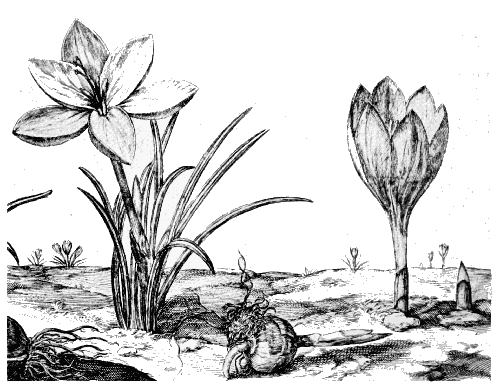
‘Crocus Byzantinus’ and ‘Crocus Montanus hispan.’ [Part of a Plate from Crispian de Passe, Hortus Floridus, 1614].
Etching and engraving on metal are well adapted to very delicate and detailed work, but from the point of view of book-illustration, wood-engraving is generally more effective. In the latter the lines are raised, and the 203method of printing is thus exactly the same as in the case of type, while in the former the process is reversed and the lines are incised. As a result, there is a harmony about a book illustrated with wood-cuts which cannot, in the nature of things, be attained, when such different processes as printing from raised type, and from incised metal, are brought together in the same volume.
CHAPTER VIII
THE DOCTRINE OF SIGNATURES AND ASTROLOGICAL BOTANY
 URING the preceding chapters, we have restricted our discussion to those writings which may be credited with having taken some part, however slight, in advancing the knowledge of plants. We have, as it were, confined our attention to the main stream of botanical progress, and its tributaries. But before concluding, it may be well to call to mind the existence of more than one backwater, connected indeed with the main channel, but leading nowhere.
URING the preceding chapters, we have restricted our discussion to those writings which may be credited with having taken some part, however slight, in advancing the knowledge of plants. We have, as it were, confined our attention to the main stream of botanical progress, and its tributaries. But before concluding, it may be well to call to mind the existence of more than one backwater, connected indeed with the main channel, but leading nowhere.
The subject of the superstitions, with which herb collecting has been hedged about at different periods, is far too wide to be dealt with in detail in the present book. We have referred in earlier chapters to the observances with which the Greek herb-gatherers surrounded their calling (p. 7) and to the mysterious dangers which are described in the ‘Herbarium’ of Apuleius as attending the uprooting of the Mandrake (p. 36). There is comparatively little reference to such matters in the works of the German Fathers of Botany or those of the greatest of their successors; indeed, as we have previously mentioned (pp. 55-58, 103, 104), Bock’s famous ‘Kreuter Bůch’ and William Turner’s herbal contain definite refutations of various superstitions.
Contemporaneously, however, with the fine series of herbals of the sixteenth and seventeenth centuries, there appeared a succession of books about plants, which had as205 their subjects one or both of two topics—the “doctrine of signatures,” and “astrological botany.” These works cannot be said to have furthered the science to any appreciable extent, but they have considerable interest, rather on account of the curious light which they throw upon the attitude of mind of their writers (and presumably their readers also) than from any intrinsic merit. One of these authors, in his preface, speaks of the “Notions” and “Observations” contained in his work, “most of which I am confident are true, and if there be any that are not so, yet they are pleasant.” The excuse that the “Notions,” cherished by the botanical mystics of the sixteenth and seventeenth centuries, were “pleasant,” even if untrue, may perhaps be offered in extenuation of the very brief discussion of their salient points, which we propose to undertake in the present chapter.
The most famous of those mystical writers who turned their attention to botany was undoubtedly Philippus Aureolus Theophrastus Bombastus of Hohenheim, better known by the name of Paracelsus (1493-1541). His portrait is shown in Text-fig. 108. He was a doctor, as206 his father had been before him, and in 1527 he became professor at Basle. Here he gave great offence by lecturing in the vulgar tongue, burning the writings of Avicenna and Galen, and interpreting his own works instead of those of the ancients. His disregard of cherished traditions, and his personal peculiarities led to difficulties with his colleagues, and he only held his post for a very short time. For the rest of his life he was a wanderer on the face of the earth, and he died in comparative poverty at Salzburg in 1541.
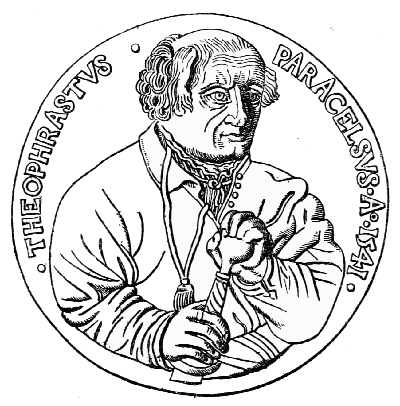
Text-fig. 108. Theophrastus von Hohenheim, called Paracelsus (1493-1541) [From a medal, see F. P. Weber, Appendix II].
The character and writings of Paracelsus are full of the strangest contradictions. Browning’s poem perhaps gives a better idea of his career than any prose account aiming at historical accuracy. His life was so strange that the imagination of a poet is needed to revitalise it for us to-day. His almost incredible boastfulness is the main characteristic that everyone remembers—the word “bombast” being, in all probability, coined from his name. In207 one of his works, after contemptuously dismissing all the great physicians who had preceded him—Galen, Avicenna and others—he remarks, “I shall be the Monarch and mine shall the monarchy be36.” The conclusion that he was something of a quack can hardly be avoided, but at the same time it must be confessed that his writings were occasionally illumined with real scientific insight, and that he infused new life into chemistry and medicine.
Paracelsus’ actual knowledge of botany appears to have been meagre, for not more than a couple of dozen plant names are found in his works. To understand his views on the properties of plants it is necessary to turn for a moment to his chemical theories. He regarded “sulphur,” “salt,” and “mercury” as the three fundamental principles of all bodies. The sense in which he uses these terms is symbolic, and thus differs entirely from that in which they are employed to-day. “Sulphur” appears to embody the ideas of change, combustibility, volatilisation and growth; “salt,” those of stability and non-inflammability; “mercury,” that of fluidity. The “virtues” of plants depend, according to Paracelsus, upon the proportions in which they contain these three principles.
The medicinal properties of plants are thus the outcome of qualities that are not obvious at sight. How, then, is the physician to be guided in selecting herbal remedies to cure the several ailments of his patients? The answer to this question given by Paracelsus is summed up in what is known as the Doctrine of Signatures.
According to this doctrine, many medicinal herbs are stamped, as it were, with some clear indication of their uses. This may perhaps be best understood by means of a quotation from Paracelsus himself (in the words of a seventeenth-century English translation). “I have oft-times declared, how by the outward shapes and qualities of things we may know their inward Vertues, which God hath put in them for the good of man. So in St Johns wort, we may take notice of the form of the leaves and flowers, the porosity of the leaves, the Veins. 1. The porositie or 208holes in the leaves, signifie to us, that this herb helps both inward and outward holes or cuts in the skin.... 2. The flowers of Saint Johns wort, when they are putrified they are like blood; which teacheth us, that this herb is good for wounds, to close them and fill them up” etc.
It is sometimes held that the real originator of the theory of signatures, in any approximation to a scientific form, was Giambattista Porta, who was probably born at Naples shortly before the death of Paracelsus. He wrote a book about human physiognomy, in which he endeavoured to find, in the bodily form of man, indications as to his character and spiritual qualities. This study suggested to him the idea that the inner qualities, and the healing powers of the herbs might also be revealed by external signs, and thus led to his famous work, the ‘Phytognomonica,’ which was first published at Naples in 1588.
Porta developed his theory in detail, and pushed it to great lengths. He supposed, for example, that long-lived plants would lengthen a man’s life, while short-lived plants would abbreviate it. He held that herbs with a yellow sap would cure jaundice, while those whose surface was rough to the touch would heal those diseases that destroy the natural smoothness of the skin. The resemblance of certain plants to certain animals opened to Porta a vast field of dogmatism on a basis of conjecture. Plants with flowers shaped like butterflies would, he supposed, cure the bites of insects, while those whose roots or fruits had a jointed appearance, and thus remotely suggested a scorpion, must necessarily be sovereign remedies for the sting of that creature. Porta also detected many obscure points of resemblance between the flowers and fruits of certain plants, and the limbs and organs of certain animals. In such cases of resemblance he held that an investigation of the temperament of the animal in question would determine what kind of disease the plant was intended to cure. It will be recognised from these examples that the doctrine of signatures was remarkably elastic, and was not fettered by any rigid consistency.
The illustrations of the ‘Phytognomonica’ are of great interest as interpreting Porta’s point of view. The part of man’s body which is healed by a particular herb, or the209 animal whose bites or stings can be cured by it, are represented in the same wood-cut as the herb. For example, the back view of a human head with a thick crop of hair is introduced into the block with the Maidenhair Fern, which is an ancient specific for baldness; a Pomegranate with its seeds exposed, and a plant of “Toothwort,” with its hard, white scale-leaves, are represented in the same figure as a set of human teeth; a drawing of a scorpion accompanies some pictures of plants with articulated seed-vessels210 (Text-fig. 109) and an adder’s head is introduced below the drawing of the plant known as the “Adder’s tongue.”
It would serve little purpose to deal in detail with the various exponents of the doctrine of signatures, such, for example, as Johann Popp, who in 1625 published a herbal written from this standpoint, and containing also some astrological botany. We will only now refer to one of the later champions of the signatures of plants, an English herbalist of the seventeenth century, who made the subject peculiarly his own. This was William Cole37, a Fellow of New College, Oxford, who lived and botanised at Putney in Surrey. He seems to have been a person of much character, and his vigorous arguments would often be very telling, were it possible to admit the soundness of his premisses.
William Cole carried the doctrine of signatures to as extreme a point as can well be imagined. His account of the Walnut, from his work ‘Adam in Eden,’ 1657, may be quoted as an illustration: “Wall-nuts have the perfect Signature of the Head: The outer husk or green Covering, represent the Pericranium, or outward skin of the skull, whereon the hair groweth, and therefore salt made of those husks or barks, are exceeding good for wounds in the head. The inner wooddy shell hath the Signature of the Skull, and the little yellow skin, or Peel, that covereth the Kernell of the hard Meninga and Pia-mater, which are the thin scarfes that envelope the brain. The Kernel hath the very figure of the Brain, and therefore it is very profitable for the Brain, and resists poysons; For if the Kernel be bruised, and moystned with the quintessence of Wine, and laid upon the Crown of the Head, it comforts the brain and head mightily.”
In Cole’s writings we meet with instances of a curious confusion of thought, which characterised the doctrine of signatures. The signature in some cases represents an animal injurious to man, and is taken to denote that the plant in question will cure its bites or stings. For instance, “That Plant that is called Adders tongue, because the stalke of it represents one, is a soveraigne wound Herbe to cure the 211biting of an Adder.” In other cases, the signature represents one of the organs of the human body, and indicates that the plant will cure diseases of that organ. For example, “Heart Trefoyle is so called, not onely because the Leafe is Triangular like the Heart of a Man, but also because each Leafe containes the perfect Icon of an Heart, and that in its proper colour, viz. a flesh colour. It defendeth the Heart against the noisome vapour of the Spleen.”
Cole seems to have possessed a philosophic mind, and to have endeavoured to follow his theories to their logical conclusion. He was much exercised because a large proportion of the plants with undoubted medicinal virtues have no obvious signatures. He concluded that a certain number were endowed with signatures, in order to set man on the right track in his search for herbal remedies; the remainder were purposely left blank, in order to encourage his skill and resource in discovering their properties for himself. A further ingenious argument is that a number of plants are left without signatures, because if all were signed, “the rarity of it, which is the delight, would be taken away by too much harping upon one string.”
Our author was evidently a keen and enthusiastic collector of herbs. In his book ‘The Art of Simpling’ (1656) he complains bitterly that physicians leave the gathering of herbs to the apothecaries, and the latter “rely commonly upon the words of the silly Hearb-women, who many times bring them Quid for Quo, then which nothing can be more sad.”
Another strong supporter in this country of the doctrine of signatures was the astrological botanist, Robert Turner. He definitely states that “God hath imprinted upon the Plants, Herbs, and Flowers, as it were in Hieroglyphicks, the very signature of their Vertues.”
It is interesting to find that the doctrine of signatures was repudiated by the best of the sixteenth-century herbalists. Dodoens, for instance, wrote in 1583 that “the doctrine of the Signatures of Plants has received the authority of no ancient writer who is held in any esteem: moreover it is so changeable and uncertain that, as far as science or learning is concerned, it seems absolutely unworthy of acceptance38.”
A later writer, Guy de la Brosse, criticised the theory very acutely, pointing out that it was quite easy to imagine any resemblance between a plant and an animal that happened to be convenient. “C’est comme des nuées,” he writes, “que l’on fait ressembler à tout ce que la fantaisie se represente, à une Gruë, à une Grenoüille, à un homme, à une armee, et autres semblables visions39.”
Both Paracelsus and Porta deprecate the use of foreign drugs, on the ground that in the country where a disease arises, there nature produces means to overcome it. This idea is one which constantly recurs in the herbals. In 1664 Robert Turner wrote, “For what Climate soever is subject to any particular Disease, in the same Place there grows a Cure.” There is ample evidence of the survival of this theory even in the nineteenth century; for instance, in the preface to Thomas Green’s ‘Universal Herbal’ of 1816 we find the remark, “Nature has, in this country, as well as in all others, provided, in the herbs of its own growth, the remedies for the several diseases to which it is most subject.” The notion persists indeed to the present day; there is a wide-spread belief among children, for example, that Docks always grow in the neighbourhood of Stinging Nettles, in order to provide a cure in situ! Whether this view contains any grain of truth or not, it certainly deserves our gratitude, since it led to Dr Maclagan’s discovery of Salicin as a cure for rheumatic fever. On the ground that in the case of malarial diseases “the poisons which cause them and the remedy which cures them are naturally produced under similar climatic conditions,” Maclagan sought and found, in the bark of the Willow, which inhabits low-lying, damp situations, this drug, which has proved so valuable in the treatment of rheumatism40.
The doctrine of signatures is not the only piece of botanical mysticism associated with the name of Paracelsus. He was also a firm believer in the influence of the heavenly 213bodies upon the vegetable world, or, in other words, in botanical astrology. He considered that each plant was under the influence of some particular star, and that it was this influence which drew the plant out of the earth when the seed germinated. He held each plant to be a terrestrial star, and each star, a spiritualised plant. Giambattista Porta also believed in a relation between certain plants and corresponding stars or planets. A figure in his ‘Phytognomonica’ here reproduced (Text-fig. 110) shows a number of “lunar plants.”
In order to appreciate the attitude in which Paracelsus214 and his followers approached the subject of the relation between plants and stars, it is necessary to realise the position which Astrology had come to occupy in the Middle Ages41.
It was in ancient Babylon that this pseudo-science mainly took its rise. Here the five planets which we now call Jupiter, Venus, Saturn, Mars and Mercury, and also the Sun and Moon, were identified, in certain senses, with seven great Gods. The movements of these heavenly bodies were supposed to represent in symbolic fashion the deeds of these Gods. It was thought possible to interpret the movements and relative positions of the planets and the sun and moon, in a way that threw light upon the fate of mankind, in so far as it depended upon the Gods in question.
Some centuries before the Christian era, Babylonian astrology began to influence the nations farther to the West. In Greece, the subject took a more personal turn and it was believed that the fate, not only of nations but of individuals, was determined in the skies, and could be foretold from the position of the planets at the time of a man’s birth. At a later period, speculation on the subject was carried further and further, until finally not only men, but all animals, vegetables and minerals were associated, either with particular planets, or with the constellations of the Zodiac.
That a belief in the influence of the moon upon plants dates back to very early times in western Europe, is shown by the statement, in Pliny’s ‘Natural History,’ that the Druids in Britain gathered the Mistletoe for medical purposes, with many rites and ceremonies, when the moon was six days old. To trace the history of astrology in detail is altogether beyond our province, but, as an example of its universal acceptance, we may recall the reference to the supreme influence of the stars in the preface of the Herbarius zu Teutsch of 1485 (see p. 19). Astrological ideas were familiar in Elizabethan England, and are reflected in many passages in Shakespeare’s plays, never perhaps more charmingly than in Beatrice’s laughing words—“there was a star danced, and under that I was born.”
Paracelsus, though his name is so well known in this 215connection, was by no means the first writer on botanical astrology. A book called ‘De virtutibus herbarum,’ erroneously attributed to Albertus Magnus, had a wide circulation from early times, being first printed in the fifteenth century. It was translated into many languages, one English version appearing about 1560 under the title ‘The boke of secretes of Albartus Magnus, of the vertues of Herbes, stones and certaine beastes.’ It does not contain very much information about plants, being mostly occupied with animals and minerals, but there are very definite references to astrology. For instance we are told that if the Marigold “be gathered, the Sunne beynge in the sygne Leo, in August, and be wrapped in the leafe of a Laurell, or baye tree, and a wolves tothe be added therto, no man shal be able to have a word to speake agaynst the bearer therof, but woordes of peace.” Concerning the Plantain we read, “The rote of this herbe is mervalous good agaynst the payne of the headde, because the signe of the Ramme is supposed to be the house of the planete Mars, which is the head of the whole worlde.”
The herbal of Bartholomæus Carrichter (1575), in which the plants are arranged according to the signs of the Zodiac, is considerably more complete and elaborate than the book to which we have just referred. It seems however impossible to discover the principle, if any, which guided the author in connecting any given herb with one sign of the Zodiac rather than another.
Much stress is laid in this herbal on the hour at which the herbs ought to be gathered, great importance being ascribed to the state of the moon at the time. We are reminded of a passage in ‘The Merchant of Venice’ where Jessica says of a bright moonlight evening—
This aspect of the subject is emphasised in a curious little book published in 1571, Nicolaus Winckler’s ‘Chronica herbarum,’ which is an astrological calendar giving information as to the appropriate times for gathering different roots and herbs.
Almost contemporaneously with Carrichter’s ‘Kreutterbůch,’ the first part of a work on astrological botany was216 published by Leonhardt Thurneisser zum Thurn. This writer, who was possessed of undoubted talent, was also an adventurer and charlatan of the first order. He was born at Basle in 1530. He learned his father’s craft, that of a goldsmith, and is said to have also helped a local doctor to collect and prepare herbs, and to have been employed to read aloud to him from the works of Paracelsus. His career in Basle came to an untimely end, for he seems to have tried to retaliate on some customers who treated him badly, by selling them gilded lead as a substitute for gold, and consequently had to flee the country when the fraud was discovered. He travelled widely, making an especial study of mining. He had an adventurous and varied life, sometimes in poverty and obscurity, sometimes in wealth and renown.
During Thurneisser’s most influential period he lived in Berlin, practising medicine, making amulets, talismans, and secret remedies which yielded large profits. He also published astrological calendars, cast nativities, and supplemented his income by the practice of usury. At this time he owned a printing press, and employed a large staff which included artists and engravers. Later on, he was pursued by a succession of misfortunes, including accusations of magic and witchcraft, which compelled him to leave Germany. Little is known of the latter part of his life; he died in the last decade of the sixteenth century.
Leonhardt Thurneisser projected a great botanical work in ten books. The first was published in Berlin in 1578, but the others never appeared. The title was ‘Historia unnd Beschreibung Influentischer, Elementischer und Natürlicher Wirckungen, Aller fremden unnd heimischen Erdgewechssen.’ A Latin version of this book, under the name, ‘Historia sive descriptio plantarum,’ was published in the same year. This first instalment deals only with the Umbellifers, which were regarded as under the dominion of the Sun and Mars. The nomenclature and the figures are not clear enough to allow individual species to be recognised. Each is drawn in an ellipse surrounded by an ornamental border, which contains mystical inscriptions denoting the properties of the plant (e.g. Plate XX). In some cases diagrams are given, showing the conjunction of the stars under which the herb should be gathered (Text-fig. 111).
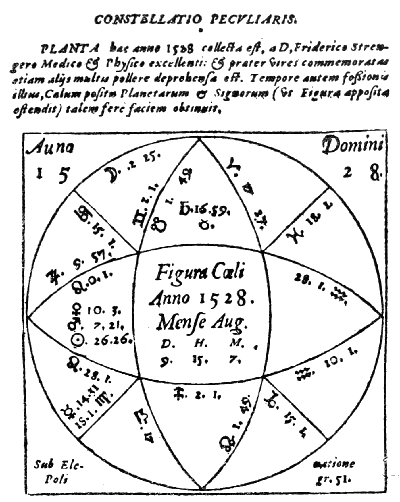
Text-fig. 111. Astrological Diagram relating to the gathering of “Cervaria fœmina” [Thurneisser, Historia sive Descriptio Plantarum, 1587].
After the manner of the ancients, Thurneisser describes plants, according to their qualities, as either male or female. He also adds a third class, typified by a child, to symbolise those whose qualities are feeble. It may perhaps be worth while to translate here a few sentences of the first chapter of the ‘Historia42,’ to show how far such writers as Leonhardt Thurneisser had departed from the pursuit of the subject upon legitimate lines. When discussing the planting of 218roots and herbs and the gathering of seeds, he declares that “it is absolutely essential that these operations should be performed so as to correspond with the stations and positions of the planets and heavenly bodies, to whose control diseases are properly subject. And against disease we have to employ herbs, with due regard of course to the sex, whichever it be, of human beings; and so herbs intended to benefit the male sex should be procured when the Sun or Moon is in some male sign [of the Zodiac], e.g. Sagittarius or Aquarius, or if this is impossible, at least when they are in Leo. Similarly herbs intended to benefit women should be gathered under some female sign, Virgo, of course, or, if that is impossible, in Taurus or Cancer.”
In the seventeenth century, England became strongly infected with astrological botany. The most notorious exponent of the subject was Nicholas Culpeper (1616-1654), who, about 1640, set up as an astrologer and physician in Spitalfields. His portrait is reproduced in Plate XXI. He created great indignation among the medical profession by publishing, under the name of ‘A Physicall Directory,’ an unauthorised English translation of the Pharmacopœia, which had been issued by the College of Physicians. That Culpeper was unpopular with orthodox medical practitioners is hardly surprising, when we consider the way in which he speaks of them in this book, as “a company of proud, insulting, domineering Doctors, whose wits were born above five hundred years before themselves.” He goes on to ask—“Is it handsom and wel-beseeming a Common-wealth to see a Doctor ride in State, in Plush with a footcloath, and not a grain of Wit but what was in print before he was born?”
Many editions of the ‘Physicall Directory’ were issued under different names. As ‘The English Physician enlarged,’ it enjoyed great popularity, and was reprinted as late as the nineteenth century. The edition of 1653 is described on the title-page as “Being an Astrologo-Physical Discourse of the Vulgar Herbs of this Nation: Containing a Compleat Method of Physick, whereby a man may preserve his Body in Health; or Cure himself, being Sick, for three pence Charge, with such things only as grow in England, they being most fit for English Bodies.”
[A Physicall Directory, 1649. Engraving by Cross.]]
Culpeper describes certain herbs as being under the dominion of the sun, the moon, or a planet, and others as under a planet and also one of the constellations of the Zodiac. His reasons for connecting a particular herb with a particular heavenly body are curiously inconsequent. He states, for example, that “Wormwood is an Herb of Mars, ... I prove it thus; What delights in Martial places, is a Martial Herb; but Wormwood delights in Martial places (for about Forges and Iron Works you may gather a Cart load of it) Ergo it is a Martial Herb.”
The author explains that each disease is caused by a planet. One way of curing the ailment is by the use of herbs belonging to an opposing planet—e.g. diseases produced by Jupiter are healed by the herbs of Mercury. On the other hand, the illness may be cured “by sympathy,” that is by the use of herbs belonging to the planet which is responsible for the disease.
Culpeper indulges in a strange maze of similar reasons to justify the use of Wormwood for affections of the eyes. “The Eyes are under the Luminaries; the right Eye of a Man, and the left Eye of a Woman the Sun claims Dominion over: The left Eye of a Man, and the right Eye of a Woman, are the priviledg of the Moon, Wormwood an Herb of Mars cures both43; what belongs to the Sun by Sympathy, because he is exalted in his House; but what belongs to the Moon by Antipathy, becaus he hath his Fal in hers.”
It is somewhat surprising to find that, in his preface, Culpeper claims that he surpasses all his predecessors in being alone guided by reason, whereas all previous writers are “as full of nonsense and contradictions as an Egg is ful of meat.”
Culpeper met with considerable opposition and criticism from his contemporaries. Shortly after his death, William Cole in his ‘Art of Simpling’ wrote scornfully of astrological botanists, “Amongst which Master Culpeper (a man now dead, and therefore I shall speak of him as modestly as I can, for were he alive I should be more plain with him) was a great Stickler; And he, forsooth, judgeth all men unfit to 220be Physitians, who are not Artists in Astrology, as if he and some other Figure-flingers his companions, had been the onely Physitians in England, whereas for ought I can gather, either by his Books, or learne from the report of others, he was a man very ignorant in the forme of Simples.”
It is interesting to notice that Cole, though he seems to the modern reader very credulous on the subject of the signatures of plants, was completely sceptical as to the association of astrology and botany. The main argument by which he tries to discredit it is an ingenious one. The knowledge of herbs is, he says, “a subject as antient as the Creation (as the Scriptures witnesse) yea more antient then the Sunne, or Moon, or Starres, they being created on the fourth day, whereas Plants were the third. Thus did God even at first confute the folly of those Astrologers, who goe about to maintaine that all vegitables in their growth, are enslaved to a necessary and unavoidable dependance on the influences of the Starres; Whereas Plants were, even when Planets were not.”
CHAPTER IX
CONCLUSIONS
 General review of the subjects discussed in the foregoing chapters brings home to us several results of some interest. Perhaps the most obvious of these is the incalculable debt which Botany owes to Medicine. An overwhelming majority of the herbalists were physicians, who were led to the study of botany on account of its connection with the arts of healing. As we have already pointed out, medicine gave the original impulse, not only to Systematic Botany, but also to the study of the Anatomy of Plants.
General review of the subjects discussed in the foregoing chapters brings home to us several results of some interest. Perhaps the most obvious of these is the incalculable debt which Botany owes to Medicine. An overwhelming majority of the herbalists were physicians, who were led to the study of botany on account of its connection with the arts of healing. As we have already pointed out, medicine gave the original impulse, not only to Systematic Botany, but also to the study of the Anatomy of Plants.
However, as the evolution of the herbal proceeded, we have shown that botany rose from being a mere hand-maid of medicine to a position of comparative independence. This is well exemplified in the history of plant classification. When the early medical botanists attempted any arrangement of their material, it was on a purely utilitarian basis; the herbs were merely classified according to the qualities which made them of value to man. But as the science grew, the need of a more systematic classification began to make itself felt, and in some of the works published in the latter half of the period we are considering, there is a distinct, if only partially successful, attempt to group the plants according to the affinities which they present when considered in themselves, and not in relation to man. The ideal of a natural system in the Vegetable Kingdom, in222 which each plant should find its inevitable place, must have been clear for instance to de l’Obel, when he wrote in the ‘Adversaria,’ of “an order, than which nothing more beautiful exists in the heavens, or in the mind of a wise man44.”
Second only to the debt of botany to medicine is its debt to certain branches of the fine arts, more especially wood-engraving. The draughtsman and engraver not only disseminated the knowledge of plants, but their work must often have revealed to the botanist features which had escaped his less highly educated and subtle eye.
As we have already pointed out, the art of plant description lagged conspicuously behind that of plant illustration. The vague and crude, but often picturesque, accounts, given by the early herbalists of the plants which they observed, contrast curiously with the technically accurate, but colourless and impersonal descriptions from the pens of modern botanists.
The rapid rise of botany, in the two centuries which we have reviewed, must have been greatly stimulated by the cosmopolitanism of the savants of the renaissance. Periods of study at a succession of different universities, and wide European travel, including visits to scientific men of various countries, seem to have formed part of the recognised equipment of the botanical student. Possibly the zeal for travel was not altogether spontaneous, but was artificially stimulated by the religious disturbances so common at the period of the Reformation and later, which often drove into exile the adherents of the Reformed Faith, among whom many botanists were numbered. This is exemplified in the cases of William Turner, Charles de l’Écluse, and the Bauhins.
It is interesting to notice that, in the works of the best herbalists of the sixteenth and seventeenth centuries, such for instance as Bock, Turner, Dodoens and Gaspard Bauhin, we find, comparatively speaking, little belief in any kind of superstition connected with plants, such as the doctrine of signatures, or astrology. A number of books dealing with such topics appeared during the period we have considered, 223but their writers form a class apart, and must not be confused with the herbalists proper, whose attitude was, on the whole, marked by a healthy scepticism which was in advance of their time. It would, naturally, be far from true to say that they were all quite free from superstition, but, considering the intellectual atmosphere of the period, their enlightenment was quite remarkable.
When we come to consider the origin of the herbal, we find that it is impossible to assign any date for its beginning. In manuscript form, herbals have existed from very early times, but, in the present book, those prior to the invention of printing have been scarcely touched upon. Our subject has been limited to the most active life-period of the printed herbal, which may be reckoned as beginning in the last quarter of the fifteenth century, with the ‘Book of Nature,’ the ‘Herbarium’ of Apuleius, and the Latin and German ‘Herbarius.’ When this active period ended is less easily decided, but in some senses it may fairly be taken as224 covering only the comparatively short space of two hundred years. There are, of course, a very large number of later herbals, belonging to the end of the seventeenth, the eighteenth, and even the nineteenth and twentieth centuries, but their importance in the history of botany appears to the present writer to be relatively small, and hence, in this volume, attention has been almost entirely confined to works which appeared before 1670.
After this period, botany rapidly became more scientific; the discovery of the function of the stamens, which was first announced in 1682, marking a very definite step in advance. As time went on, the herbal, with its characteristic mixture of medical and botanical lore, gave way before the exclusively medical pharmacopœia on the one hand, and the exclusively botanical flora on the other. As the use of home-made remedies declined, and the chemist’s shop took the place of the housewife’s herb-garden and still-room, the practical value of the herbal diminished almost to vanishing point.
The best epoch in the history of the herbal, from the point of view of book-illustration, is confined within much narrower limits than the two centuries we have been considering. The suggestion has been made, and seems thoroughly justified, that the finest period should be reckoned as falling between 1530 and 1614, that is, between the wood-cuts of Hans Weiditz in Brunfels’ ‘Herbarum vivæ eicones,’ and the copper-plates of Crispian de Passe in the ‘Hortus Floridus.’ This good period thus lasted less than one hundred years, and belongs chiefly to the sixteenth century. From the artistic point of view, its zenith is perhaps reached in the wood-engravings which illustrate Fuchs’ great work, ‘De historia stirpium’ (1542), though, from a more strictly scientific standpoint, the drawings by Camerarius and Gesner, which appeared in 1586 and 1588, may be said to bear the palm.
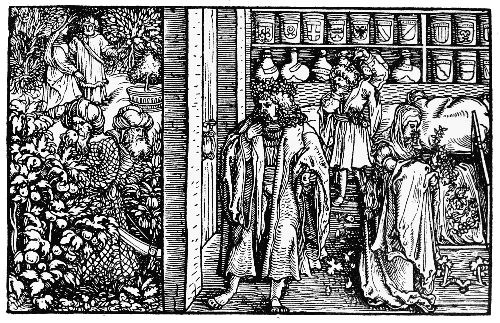
Text-fig. 113. A Herbalist’s Garden and Store-room [Das Kreüterbůch oder Herbarius. Printed by Heinrich Stayner, Augsburg, 1534].
As far as the text is concerned, the culmination of the botanical works of the period under consideration may be regarded as foreshadowed in the ‘Stirpium Adversaria Nova’ of Pena and de l’Obel (1570-71) and attained in the ‘Prodromos’ (1620) and the ‘Pinax’ (1623) of Gaspard Bauhin. In the works of the latter author, 225-226classification, nomenclature and description reach their high-water mark, though it is to de l’Obel, and to his precursor, Bock, one of the “German Fathers of Botany,” that we owe the first definite efforts after a natural system. It is pleasant to remember that Jean Bauhin, to whom his younger brother Gaspard probably owed his first botanical inspiration, was a pupil of Leonhard Fuchs at Tübingen, so that the latter has a double claim to be associated with the results of the “herbal period” at its best. We began this book with a portrait of Leonhard Fuchs, and we may well conclude with his name—that of the greatest and most typical of sixteenth-century herbalists.
APPENDIX I
A CHRONOLOGICAL LIST OF THE PRINCIPAL HERBALS AND RELATED BOTANICAL WORKS PUBLISHED BETWEEN 1470 AND 1670.
This list, which is intended for the botanist rather than the bibliographer, is far from being exhaustive, especially as regards works published in the seventeenth century. In most cases reference is made to first editions only. Subsequent editions and translations, though often numerous and important, are usually not cited unless special mention has been made of them in the text. In cases where such editions are quoted, their titles are placed beneath that of the first edition (i.e. under the date of the first edition). Independent works by the same author are, however, arranged chronologically, so that, in this list, all the works of any given author are not placed together, but must be looked for under their respective dates. These dates can generally be ascertained by reference to the text. The author’s name, or, in the case of anonymous works, the title most commonly used, is printed in heavy type. All the works enumerated have been examined personally by the author, except those of which the dates are marked with an asterisk.
? 1470
Bartholomæus Anglicus [Glanville, Bartholomew de]. Liber de proprietatibus rerum. Begins: Incipit prohemium de proprietatibus rerum fratris bartholomei anglici de ordine fratrum minorum. [? Cologne, ? 1470.] [A general work containing one section dealing with plants.]
—— (Another Edition). Liber de proprietatibus rerum. [? Westminster, ? 1495.] [A translation by Trevisa printed by Wynkyn de Worde.]
? 1475
Konrad von Megenberg [Cůnrat]. Begins: Hye nach volget das půch der natur.... Hanns Bämler. Augsburg, -75 [= 1475]. [A general work containing a section dealing with plants.]
1478
Albertus Magnus [erroneously attributed to]. Liber aggregations seu liber secretorum Alberti magni de virtutibus herbarum ... (Colophon:) per Johannem de Annunciata de Augusta. 1478.
—— (Another Edition). De virtutibus herbarum. De virtutibus lapidum. De virtutibus animalium et mirabilibus mundi. Thomas Laisne, Rouen. [? 1500.]
—— (Another Edition). The boke of secretes of Albartus Magnus, of the vertues of Herbes, stones and certaine beastes. Also a boke of the same author, of the marvaylous thinges of the world.... London. Wyllyam Copland. [? 1560.]
? 1484
Apuleius Platonicus. Begins: Incipit Herbarium Apulei Platonici ad Marcum Agrippam. [J. P. de Lignamine. Rome, ? 1484.]
1484
The Latin Herbarius [referred to by various authors as Herbarius in Latino, Aggregator de Simplicibus, Herbarius Moguntinus, Herbarius Patavinus, etc.]. Herbarius Maguntiæ impressus. [Peter Schöffer. Mainz.] 1484.
—— (Another Edition). Begins: Dye prologhe de oversetters uyt den latyn in dyetsche. [Veldener, Kuilenborg.] 1484. [A Flemish translation.]
—— (Another Edition). Begins: Incipit Tractatus de virtutibus herbarum. (Colophon:) Impressum Venetiis per Simonem Papiensem dictum Bivilaquam.... 1499. [Sometimes called ‘Herbarius Arnoldi de nova villa Avicenna.’]
1485
The German Herbarius [referred to by various authors as the Herbarius zu Teutsch, the German Ortus Sanitatis, the smaller Ortus, Johann von Cube’s Herbal, etc.]. Begins: Offt und vil habe ich. [Peter Schöffer.] Mencz, 1485.
—— (Another Edition). Begins: Offt und vil hab ich. [Sorg.] Augspurg, 1485.
1491
Ortus Sanitatis [Hortus Sanitatis.] Prohemium begins: Omnipotentis eternique dei.... (Colophon:) Jacobus Meydenbach. Moguntia, 1491.
—— (Another Edition). (Colophon:) Impressum Venetiis per Bernardinum Benalium: Et Joannem de Cereto de Tridino alias Tacuinum. 1511.
—— (Another Edition). Ortus sanitatis translate de latin en francois. Anthoine Verard. Paris, n.d. [? 1501].
—— (Another Edition). Le jardin de sante translate de latin en francoys nouvellement Imprime a Paris. On les vend a Paris en la rue sainct Jacques a lenseigne de la Rose blanche couronnee. (Colophon:) Imprime a Paris par Philippe le noir. [? 1539.]
? 1500
Macer, Æmilius [Odo]. Macer floridus De viribus herbarum. [?Paris, ? 1500 circa.]
—— (Another Edition). Herbarum varias qui vis cognoscere vires Macer adest: disce quo duce doct’ eris. (Colophon:) Impressus Parisius per Magistrum Johannem Seurre. Pro Magistro Petro Bacquelier. 1506.
—— (Another Edition). Les fleurs du livre des vertus des herbes, composé jadis en vers Latins par Macer Floride:... Le tout mis en François par M. Lucas Tremblay, Parisien.... Rouen. Martin et Honoré Mallard. 1588.
—— (Another Edition). De viribus herbarum ... secundum codices manuscriptos ... recensuit ... Ludovicus Choulant.... Lipsiae, 1832.
1500
Braunschweig, Hieronymus [Jerome of Brunswick]. Liber de arte distillandi. de Simplicibus. Johannes Grüeninger. Strassburg, 1500.
—— (Another Edition). The vertuose boke of Distyllacyon of the waters of all maner of Herbes...Laurens Andrewe. London, 1427 [= 1527].
1516
Ruellius, Johannes [Ruel, Jean]. Pedacii Dioscoridis Anazarbei de medicinali materia libri quinque.... Impressum est in ... Parrhisiorum Gymnasio ... in officina Henrici Stephani. 1516.
1517
Czerny, Johann [Johannes Niger de Praga]. Knieha lekarska kteraz slowe herbarz (= Arzneibuch, welches heisst Herbarium) Hieronymus Höltzel. Nürnberg, 1517*.
1525
Herball. Here begynneth a newe mater, the whiche sheweth and treateth of ye vertues and proprytes of herbes, the whiche is called an Herball. Rycharde Banckes. London, 1525.
—— (Another Edition). Macers Herbal. Practysyd by Docter Lynacro. Robert Wyer. n.d. [London, ? 1530.]
—— (Another Edition). A new Herball of Macer, Translated out of Laten in to Englysshe. Robert Wyer. in saint Martyns paryshe ... besyde Charynge Crosse. n.d. London. [? 1535.]
—— (Another Edition). A boke of the propreties of Herbes called an herball, wherunto is added the tyme ye herbes, Floures and Sedes shoulde be gathered ... by W. C.45 Wyllyam Copland. n.d. London. [1550.]
—— (Another Edition). A litle Herball of the properties of Herbes ... wyth certayne Additions at the ende of the boke, declaring what Herbes hath influence of certain Sterres ... Anthony Askham, Physycyon. Jhon Kynge. London, 1550.
Before 1526
Grand Herbier. Le grand Herbier en Francoys: contenant les qualites, vertus et proprietes des herbes, arbres, gommes.... Pierre Sergent. Paris, n.d.
—— (Another Edition). The grete herball whiche geveth parfyt knowlege and understandyng of all maner of herbes and there gracyous vertues.... (Colophon:) Peter Treveris. London, 1526.
—— (Another Edition). The grete herball ... (Colophon:) Imprynted at London ... by me Peter Treveris.... 1529.
1529
Theophrastus. Theophrasti de historia, et causis plantarum, Libri Quindecim. Theodoro Gaza interprete ... (Colophon:) Excussum Luteciæ, in ædibus Christiani Wechel.... 1529.
1530
Brunfelsius, Otho [Brunfels, Otto von]. Herbarum vivæ eicones... Argentorati apud Joannem Schottum. 1530, 1531, 1536.
—— (Another Edition). Contrafayt Kreüterbůch ... zů Strasszburg bey Hans Schotten. 1532, 1537.
1533
Rhodion, D. Eucharius. Kreutterbůch ... Anfenglich von Doctor Johan Cuba zusamen bracht, jetzt widerum new Corrigirt ... Mit warer Abconterfeitung aller Kreuter. Zu Franckfurt am Meyn, Bei Christian Egenolph. 1533. [A large number of editions of this work appeared, edited by Dorstenius, Lonicer and others.]
1536
Amatus Lusitanus [Castello Branco, J. R. de]. Index Dioscoridis ... Excudebat Antverpiæ Vidua Martini Cæsaris. 1536.
Ruellius, Johannes [Ruel, Jean]. De Natura stirpium libri tres. Parisiis. 1536.
1538
Turner, William. Libellus de re herbaria novus, in quo herbarum aliquot nomina greca, latina, et Anglica habes, una cum nominibus officinarum.... Londini apud Joannem Byddellum. 1538.
—— (Another Edition). Libellus de re herbaria novus ... reprinted in facsimile, with notes, modern names, and a life of the author, by Benjamin Daydon Jackson. London, 1877.
1539
Tragus, Hieronymus [Bock, Hieronymus]. New Kreutterbuch von underscheydt, würckung und namen der kreutter, ... gedruckt zu Strassburg, durch Wendel Rihel. 1539*.
—— (Another Edition). Kreuter Bůch. Wendel Rihel. Strasburg, 1546.
—— (Another Edition). De stirpium, maxime earum, quæ in Germania nostra nascuntur ... nunc in Latinam conversi, Interprete Davide Kybero ... (Colophon:) Argentorati Excudebat Wendelinus Rihelius ... 1552.
1542
Fuchsius, Leonhardus [Fuchs, Leonhard]. De historia stirpium... Basileæ, in officina Isingriniana.... 1542.
—— (Another Edition). New Kreüterbůch. Michael Isingrin. Basell, 1543.
——- (Another Edition). Leonharti Fuchsii medici, primi de stirpium historia commentariorum tomi vivæ imagines, in exiguam ... formam contractæ.... Isingrin. Basileæ, 1545.
Gesnerus, Conradus [Gesner, Konrad]. Catalogus plantarum Latinè, graecè, Germanicè, et Gallicè.... Tiguri apud Christoph. Froschouerum, 1542.
1544
Matthiolus, Petrus Andreas [Mattioli, Pierandrea]. Di Pedacio Dioscoride Anazarbeo libri cinque della historia et materia medicinale tradotta in lingua volgare italiana.... Venetia, per Nicolo de Bascarina da Pavone di Brescia, 1544*.
—— Commentarii, in libros sex Pedacii Dioscoridis Anazarbei, de medica materia.... Venetiis ... apud Vincentium Valgrisium. 1554.
—— (Another Edition). Commentarii in sex libros Pedacii Dioscoridis Anazarbei de Medica materia, ... Venetiis, Ex Officina Valgrisiana. 1565.
1548
Turner, William. The names of herbes in Greke, Latin, Englishe Duche and Frenche wyth the commune names that Herbaries and Apotecaries use. John Day and Wyllyam Setes. London, 1548.
—— (Another Edition). The Names of Herbes, A.D. 1548. Edited by James Britten. London, 1881.
1551
Turner, William. A new Herball. Steven Mierdman. London, 1551.
—— The seconde parte of Vuilliam Turners herball. Arnold Birckman. Collen, 1562.
—— The first and seconde partes of the Herbal of William Turner ... with the Third parte, lately gathered.... Arnold Birckman. Collen. 1568.
1553
Amatus, Lusitanus [Castello Branco, J. R. de]. In Dioscoridis Anazarbei de medica materia libros quinque enarrationes ... Venetiis, 1553. (Colophon:) apud Gualterum scotum.
Bellonius, Petrus [Belon, Pierre]. De arboribus coniferis, resiniferis, aliis quoque nonnullis sempiterna fronde virentibus, ... Parisiis Apud Gulielmum Cavellat, ... 1553.
—— Les Observations de plusieurs singularitez et choses memorables, trouvées en Grece, Asie, Judée, Egypte, Arabie, et autres pays estrades, ... (Colophon:) Imprimé à Paris par Benoist Prévost.... 1553.
1554
Dodonæus, Rembertus [Dodoens, Rembert]. Crǔÿdeboeck. (Colophon:) Ghedruckt Tantwerpen by Jan vander Loe.... 1554.
—— (Another Edition). Histoire des plantes,... Nouvellement traduite ... en François par Charles de Éscluse. Jean Loë. Anvers. 1557. [In the British Museum there is a copy of this book, annotated in manuscript by Henry Lyte.]
—— (Another Edition). A Nievve Herball, or Historie of Plantes:... nowe first translated out of French into English, by Henry Lyte Esquyer. At London by me Gerard Dewes.... 1578.
1559
Maranta, Bartholomæus. Methodi cognoscendorum simplicium libri tres. Venetiis, Ex officina Erasmiana Vincentii. Valgrisii, 1559.
1561
Cordus, Valerius. In hoc volumine continentur Valerii Cordi ... Annotationes in Pedacii Dioscoridis ... de Medica materia ... eiusdem Val. Cordi historiæ stirpium lib. IIII.... Omnia ... Conr. Gesneri ... collecta, et præfationibus illustrata. (Colophon:) Argentorati excudebat Josias Rihelius. 1561.
1565
Mizaldus, Antonius [Mizauld, Antoine]. Alexikepus, seu auxiliaris hortus, ... Lutetiæ, Apud Federicum Morellum.... 1565.
—— (Another Edition). Artztgarten. ... neuwlich verteutschet durch Georgen Benisch von Bartfeld ... zu Basel bey Peter Perna. 1575.
1566
Dodonæus, Rembertus [Dodoens, Rembert]. Frumentorum, leguminum, palustrium et aquatilium herbarum ... historia. Antverpiæ, Ex officina Christophori Plantini. 156646.
1568
Dodonæus, Rembertus [Dodoens, Rembert]. Florum, et coronariarum odoratarumque nonnullarum herbarum historia, Antverpiæ, Ex officina Christophori Plantini. 1568.
1569
Monardes, Nicolas. Dos libros, el uno que trata de todas as las cosas que traen de nuestras Indias Occidentales ... Impressos en Sevilla en casa de Hernando Diaz.... 1569.
—— Segunda parte del libro, de las cosas que se traen de nuestras Indias Occidentales.... En Sevilla En casa Alonso Escrivano. 1571.
—— (Another Edition). Joyfull newes out of the newe founde worlde, wherein is declared the rare and singuler vertues of diverse ... Hearbes.... Englished by John Frampton. London, W. Norton, 1577.
1570
Bombast von Hohenheim (Paracelsus). Ettliche Tractatus des hocherfarnen unnd berümbtesten Philippi Theophrasti Paracelsi.... I. Von Natürlichen dingen. II. Beschreibung etilcher kreütter. III. Von Metallen. IV. Von Mineralen. V. Von Edlen Gesteinen. Strassburg. Christian Müllers Erben. 1570.
1570-1571
Lobelius, Mathias [de l’Obel or de Lobel, Mathias] and Pena, Petrus [Pena, Pierre]. Stirpium adversaria nova. Londini. 1570. (Colophon:) Londini, 1571. ... excudebat prelum Thomæ Purfœtii.
—— (Another Edition). Nova stirpium adversaria, ... Antverpiæ Apud Christophorum Plantinum. 1576. (Colophon:) Londini, excudebat prelum Thomæ Purfœtii.
—— (Another Edition). Plantarum seu stirpium historia, ... Cui annexum est Adversariorum volumen. Antverpiæ, Ex officina Christophori Plantini. 1576.
—— (Another Edition). Kruydtbœck. T’Antwerpen. By Christoffel Plantyn. 1581.
1571
Matthiolus, Petrus Andreas [Mattioli, Pierandrea]. Compendium De Plantis omnibus, ... de quibus scripsit suis in commentariis in Dioscoridem editis.... Accessit præterea ad calcem Opusculum de itinere, quo è Verona in Baldum montem Plantarum refertissimum itur ... Francisco Calceolario ... Venetiis, In Officina Valgrisiana. 1571.
Winckler, Nicolaus. Chronica herbarum, florum, seminum, ... Augustæ Vindelicorum in officina Typographica Michaëlis Mangeri. 1571.
1574
Dodonæus, Rembertus [Dodoens, Rembert]. Purgantium aliarumque eo facientum, tum et Radicum, Convolvulorum ac deleteriarum herbarum historiæ libri iiii. Antverpiæ, Ex officina Christophori Plantini, 1574.
1575
Carrichter, Bartholomæus. Kreutterbůch ... Gedruckt zů Strassburg ... bey Christian Müller. 1575.
1576
Clusus, Carolus [l’Écluse or l’Escluse, Charles de]. Caroli Clusii atrebat. Rariorum aliquot stirpium per Hispanias observatarum Historia,...Antverpiæ, Ex officina Christophori Plantini, ... 1576.
1578
Thurneisserus, Leonhardus [Thurneisser zum Thum, Leonhardt]. Historia sive descriptio plantarum.... (Colophon:) Berlini Excudebat Michael Hentzske. 1578.
—— (Another Edition). Historia unnd Beschreibung Influentischer, Elementischer und Natürlicher Wirckungen, Aller fremden unnd Heimischen Erdgewechssen.... (Colophon:) Gedruckt zu Berlin, bey Michael Hentzsken. 1578.
—— (Another Edition). Historia sive descriptio plantarum ... Coloniæ Agrippinæ, apud Joannem Gymnicum,... 1587.
1580
Dodonæus, Rembertus [Dodoens, Rembert]. Historia vitis vinique: et stirpium nonnullarum aliarum. Coloniæ Apud Maternum Cholinum. 1580.
1581
Lobelius, Mathias [de l’Obel or de Lobel, Mathias]. Plantarum seu stirpium icones. Antverpiæ, Ex officina Christophori Plantini. 1581. [The figures of Clusus, Lobelius and Dodonæus arranged according to the scheme of Lobelius.]
1582-1583
Rauwolff, Leonhard. Leonharti Rauwolfen,... Aigentliche beschreibung der Raiss, so er vor diser zeit gegen Auffgang inn die Morgenländer,... (Colophon:) Getruckt zů Laugingen, durch Leonhart Reinmichel. 1582, 1583. [This is a book of travel, but the fourth part, which has a separate title-page, dated 1583, contains a number of wood-cuts of foreign plants.]
1583
Cæsalpinus, Andreas [Cesalpino, Andrea]. De plantis libri xvi.... Florentiæ, Apud Georgium Marescottum. 1583.
Clusius, Carolus [l’Écluse or l’Escluse, Charles de]. Car. Clusii atrebatis Rariorum aliquot Stirpium, per Pannoniam, Austriam, et vicinas ... Historia ... Antverpiæ, Ex officina Christophori Plantini. 1583.
Dodonæus, Rembertus [Dodoens, Rembert]. Stirpium historiæ pemptades sex sive libri XXX. Antverpiæ, Ex officina Christophori Plantini. 1583.
1584
Linocier, Geofroy. L’histoire des plantes, traduicte de latin en françois: ... à Paris, Chez Charles Macé.... 1584.
1585
Durante, Castor. Herbario Nuovo.... Roma, Per Iacomo Bericchia, e Iacomo Turnierii, 1585.
1586
Matthiolus, Petrus Andreas [Mattioli, Pierandrea]. De plantis Epitome utilissima ... aucta et locupletata, à D. Joachimo Camerario, ... accessit, ... liber singularis de itinere ... in Baldum montem ... auctore Francisco Calceolario Francofurti ad Moenum. 1586.
1586-1587
Dalechampius, Jacobus [d’Aléchamps or Daléchamps, Jacques]. Historia generalis plantarum,... Lugduni, apud Gulielmum Rovillium. 1586, 1587.
1588
Camerarius, Joachim. Hortus medicus et philosophicus: ... Francofurti ad Mœnum. 1588.
—— Icones accurate ... delineatæ præcipuarum stirpium, quarum descriptiones tam in Horto.... Impressum Francofurti ad Mœnum. 1588. [These figures are generally bound up with the ‘Hortus medicus.’]
Porta, Johannes Baptista [Porta, Giambattista]. Phytognomonica.... Neapoli, Apud Horatium Saluianum. 1588.
1588-1591
Theodorus, Jacobus [Theodor, Jacob, or Tabernæmontanus, Jacobus Theodorus]. Neuw Kreuterbuch, ... [Nicolaus Bassæus] Franckfurt am Mayn. 1588, 1591.
—— (Another Edition). Eicones plantarum seu stirpium. Nicolaus Bassæus, Francofurti ad Moenum, 1590. [This edition contains the figures only.]
—— (Another Edition). Neuw vollkommentlich Kreuterbuch,... gemehret, Durch Casparum Bauhinum.... Franckfurt am Mayn, Durch Nicolaum Hoffman, In verlegung Johannis Bassæi und Johann Dreutels. 1613.
1590
Matthiolus, Petrus Andreas [Mattioli, Pierandrea]. Kreuterbuch ... gemehrt und gefertigt durch Joachimum Camerarium, ... Frankfurt a/M., gedruckt bei Johann Feyerabend. 1590*.
—— (Another Edition). Kreutterbuch ... gemehret, unnd verfertigt, Durch Joachimum Camerarium ... Gedruckt zu Franckfurt am Mayn. 1600.
1592
Alpinus, Prosper [Alpino, Prospero]. De plantis Ægypti.... Venetiis ... Apud Franciscum de Franciscis Senensem. 1592.
Columna, Fabius [Colonna, Fabio]. ΦΥΤΟΒΑΣΑΝΟΣ sive plantarum aliquot historia ... Ex Officina Horatii Saluiani. Neapoli, 1592. Apud Io. Jacobum Carlinum, et Antonium Pacem.
Zaluzian, Adam Zaluziansky von. Methodi herbariæ, libri tres. Pragæ, in officina Georgii Dacziceni. 1592.
1596
Bauhinus, Caspar [Bauhin, Gaspard]. ΦΥΤΟΠΙΝΑΞ seu enumeratio plantarum.... Basileæ, per Sebastianum Henricpetri. 1596.
1597
Gerard, John [Gerarde, John]. The Herball or Generall Historie of Plantes.... Imprinted at London by John Norton. 1597.
—— (Another Edition). The Herball or Generall Historie of Plantes.... Very much Enlarged and Amended by Thomas Johnson Citizen and Apothecarye of London. London, Printed by Adam Islip, Joice Norton and Richard Whitakers. 1633. [Reprinted 1636.]
1601
Bauhinus, Caspar [Bauhin, Gaspard]. Animadversiones in historiam generalem plantarum Lugduni editam.... Francoforti, Excudebat Melchior Hartmann, Impensis Nicolai Bassæi ... 1601.
Clusius, Carolus [l’Écluse or l’Escluse, Charles de]. Caroli Clusii atrebatis, ... rariorum plantarum historia.... Antverpiæ Ex officina Plantiniana Apud Joannem Moretum. 1601.
1606
Columna, Fabius [Colonna, Fabio]. Minus cognitarum stirpium aliquot, ΕΚΦΡΑΣΙϹ.... Romæ. Apud Guilielmum Facciottum. 1606.
Pars altera. Romæ. Apud Jacobum Mascardum. 1616.
Spigelius, Adrianus. Isagoges in rem herbariam Libri Duo.... Patavii, Apud Paulum Meiettum. Ex Typographia Laurentii Pasquati. 1606.
1609
Durante, Castor. Hortulus Sanitatis, Das ist, Ein ... Gährtlin der Gesundtheit ... in unsere hoch Teutsche Sprach versetzt, Durch Petrum Uffenbachium, ... Getruckt zu Franckfort am Mäyn, durch Nicolaum Hoffmann.... 1609.
1611
Renealmus, Paulus [Reneaulme, Paul]. Specimen Historiæ Plantarum. Parisiis, Apud Hadrianum Beys ... 1611.
1613
Beslerus, Basilius [Besler, Basil]. Hortus Eystettensis ... [Eichstadt]. 1613.
1614
Passæus, Crispian [Passe, Crispin de or Crispian de]. Hortus floridus ... Extant Arnhemii Apud Ioannem Ianssonium ... 1614.
—— (Another Edition). A Garden of Flowers.... Printed at Utrecht By Salomon de Roy. 1615.
1616
Olorinus, Johannes [Sommer, Johann, aus Zwickau]. Centuria Herbarum Mirabilium Das ist: Hundert Wunderkräuter.... Magdeburgk, Bey Levin Braunss.... 1616.
—— Centuria Arborum Mirabilium Das ist: Hundert Wunderbäume.... Magdeburgk, Bey Levin Braunss.... 1616.
1619
Bauhinus, Joannes [Bauhin, Jean] and Cherlerus, J. H. [Cherler, J. H.]. J. B. ... et J. H. C. ... historiæ plantarum generalis ... prodromus.... Ebroduni, Ex Typographia Societatis Caldorianæ. 1619.
—— (Another Edition). Historia plantarum universalis ... Quam recensuit et auxit ... Chabræus ... publici fecit, Fr. Lud. a Graffenried.... Ebroduni, 1650, 51.
1620
Bauhinus, Caspar [Bauhin, Gaspard]. ΠΡΟΔΡΟΜΟΣ Theatri botanici.... Francofurti ad Mœnum, Typis Pauli Jacobi, impensis Joannis Treudelii. 1620.
1623
Bauhinus, Caspar [Bauhin, Gaspard]. ΠΙΝΑΞ theatri botanici.... Basileæ Helvet. Sumptibus et typis Ludovici Regis. 1623.
1625
Popp, Johann [Poppe, Johann]. Kräuter Buch ... nach rechter art der Signaturen der himlischen Einfliessung nicht allein beschrieben, ... Leipzig, In Verlegung Zachariæ Schürers, und Matthiæ Götzen ... 1625.
1628
Brosse, Guy de la. De la nature, vertu, et utilité des plantes.... A Paris, Chez Rollin Baragnes ... 1628.
1629
Johnson, Thomas. Descriptio itineris plantarum investigationis ... in agrum Cantianum.... (London, 1629.)*
—— (Another Edition). Descriptio Itineris Plantarum ... in Agrum Cantianum ... et Enumeratio Plantarum in Ericeto Hampstediano locisque vicinis Crescentium.... Excudebat, Tho. Cotes. [London] 1632.
Parkinson, John. Paradisi in Sole Paradisus Terrestris. A Garden of all sorts of pleasant flowers which our English ayre will permitt to be noursed up:... (Colophon:) London, Printed by Humfrey Lownes and Robert Young at the signe of the Starre on Bread-street hill. 1629.
—— (Another Edition). Paradisi in Sole Paradisus Terrestris... Faithfully Reprinted from the Edition of 1629. Methuen & Co. London, 1904.
1631
Donati, Antonio. Trattato de semplici, ... in Venetia, ... Appresso Pietro Maria Bertano. 1631.
1634
Johnson, Thomas. Mercurius Botanicus: ... Londini, Excudebat Thom. Cotes. 1634.
1640
Parkinson, John. Theatrum botanicum: The Theater of Plants. Or, an Herball of a Large Extent.... London, Printed by Tho. Cotes. 1640.
1649
Culpeper, Nicholas. A Physicall Directory or A translation of the London Dispensatory Made by the Colledge of Physicians in London ... with many hundred additions.... London, Printed for Peter Cole ... 1649.
—— (Another Edition). The English Physitian enlarged.... London, Printed by Peter Cole ... 1653.
1650
How, William. Phytologia Britannica, natales exhibens Indigenarum Stirpium sponte Emergentium. Londoni, Typis Ric. Cotes, Impensis, Octaviani Pulleyn. 1650.
1656
Bombast von Hohenheim [Paracelsus]. Paracelsus his Dispensatory and Chirurgery.... Faithfully Englished, by W. D., London: Printed by T. M. for Philip Chetwind.... 1656.
Cole, William [Coles, William]. The Art of Simpling. London, Printed by J. G. for Nath: Brook. 1656.
1657
Cole, William [Coles, William]. Adam in Eden: or, Natures Paradise.... London, Printed by J. Streater, for Nathaniel Brooke.... 1657.
1658
Bauhinus, Caspar [Bauhin, Gaspard]. Caspari Bauhini ... Theatri botanici sive historiæ plantarum ... liber primus editus opera et cura Io. Casp. Bauhini. Basileæ. Apud Joannem König. 1658.
1659
Lovell, Robert. ΠΑΜΒΟΤΑΝΟΛΟΓΙΑ, sive Enchiridion botanicum, or a compleat Herball.... Oxford, Printed by William Hall, for Ric. Davis.... 1659.
1662
Jonstonus, Johannes [Jonston or Johnstone, John]. Dendrographias Sive Historiæ Naturalis de Arboribus et Fruticibus ... libri decem.... Francofurti ad Moenum. Typis Hieronymi Polichii. Sumptibus Hæredum Matthæi Meriani. 1662.
1664
Turner, Robert. ΒΟΤΑΝΟΛΟΓΙΑ. The Brittish Physician: or, The Nature and Vertues of English Plants. London, Printed by R. Wood for Nath. Brook. 1664.
1666
Chabræus, Dominicus. Stirpium icones et sciagraphia.... Genevæ, Typis Phil. Gamoneti et Iac. de la Pierre. 1666.
1667
Aldrovandus, Ulysses [Aldrovandi, Ulisse]. Ulyssis Aldrovandi ... Dendrologiæ naturalis scilicet arborum historiae libri duo.... Bononiæ typis Jo. Baptistae Ferronii. 1667.
1670
Nylandt, Petrus. De Nederlandtse Herbarius of Kruydt-Boeck, ... t’Amsterdam, voor Marcus Doornick, ... 1670.
APPENDIX II
A LIST, IN ALPHABETICAL ORDER, OF THE PRINCIPAL CRITICAL AND HISTORICAL WORKS DEALING WITH THE SUBJECTS DISCUSSED IN THIS BOOK.
Albertus Magnus. See Fellner, S.; Meyer, E. and Jessen, C.; Pouchet, F. A.
Alcock, Randal H. Botanical Names for English Readers. London, 1876.
Amherst, the Hon. Alicia [The Hon. Mrs Evelyn Cecil]. Bibliography of Works on Gardening. Reprinted from the Second Edition of ‘A History of Gardening in England.’ London, 1897.
Apuleius Platonicus. See Cockayne, O.; Payne, J. F. (1903).
Arber, A. See Robertson, A.
Avoine, P. J. d’. See Morren, C.
Bauhin, Gaspard. See Hess, J. W.
Blades, W. The Plantin Museum. Macmillan’s Magazine. Vol. 38, p. 282. London and New York, 1878.
Breitkopf, J. G. I. Versuch den Ursprung der Spielkarten,... und den Anfang der Holzschneidekunst in Europa zu erforschen. Vol. II. Leipzig, 1801.
Britten, James. The Names of Herbes, by William Turner, A.D. 1548. Edited by James Britten. London, 1881.
Busbecq, A.-G. See Kickx, J.
Camerarius, J. See Irmisch, T. H.
Camus, Giulio. L’Opera Salernitana ‘Circa Instans’ ed il testo primitivo del ‘Grant Herbier en Francoys.’ Memorie della Regia Accademia di Scienze, Lettere ed Arti in Modena. Ser. II. Vol. IV. Mem. della Sezione di Lettere, p. 49. 1886.
Choulant, Ludwig. Botanische und anatomische Abbildungen des Mittelalters. Archiv für die zeichnenden] Künste. Jahrg. III. p. 188. Leipzig, 1857.
Choulant, Ludwig. Handbuch der Bücherkunde für die aeltere Medicin. Leipzig, 1828.
Choulant, Ludwig. Macer Floridus de viribus herbarum ... secundum codices manuscriptos ... recensuit ... Ludovicus Choulant.... Lipsiae, 1832.
Clusius, Carolus. See Istvánffi, Gy. de; Legré, Ludovic; Roze, E.; Morren, E.
Cockayne, O. Leechdoms, Wortcunning, and Starcraft of Early England. Chronicles and Memorials of Great Britain and Ireland during the Middle Ages. Rolls Series, Vol. I. 1864. [Translation of Herbarium of Apuleius Platonicus.]
Colvin, Sir Sidney. Early Engraving and Engravers in England [1545-1695]. London, 1905.
Conrad von Megenberg. See Pfeiffer, Fr.
Copinger, W. A. Supplement to Hain’s Repertorium Bibliographicum. London, 1895, 1898, 1902.
Cordus, V. See Irmisch, T. H.
Czerny, J. See Maiwald, V.
Daubeny, Charles. Lectures on Roman Husbandry. Oxford, 1857.
Degeorge, Léon. La Maison Plantin à Anvers. Deuxième édition. Bruxelles, 1878.
Dioscorides. Codex Aniciæ Julianæ picturis illustratus, nunc Vindobonensis Med. Gr. I. phototypice editus. Moderante Josepho de Karabacek. Lugduni Batavorum, 1906.
Dodoens, Rembert. See Dodonæus, Rembertus.
Dodonæus, Rembertus. See Meerbeck, P. J. van; Morren, C. and d’Avoine, P. J.
Duff, E. Gordon. Early Printed Books. [Books about Books, edited by A. W. Pollard.] London, 1893.
Fellner, Stephan. Albertus Magnus als Botaniker. Jahres-Ber. des kais. kön. Ober-Gymnasiums zu den Schotten in Wien. Wien, 1881.
Gerard, J. See Jackson, B. D.
Gesner, Konrad. See Jardine, Sir W.; Simler, Josias; Trew, C. J.
Giacosa, Piero. Magistri Salernitani nondum editi. Catalogo ragionato della esposizione di storia della medicina aperta in Torino nel 1898. Torino, 1901. [In 2 parts, text and atlas.]
Green, E. L. Landmarks of Botanical History. A study of Certain Epochs in the Development of the science of Botany. Pt. I. Prior to 1562 A.D. Smithsonian Misc. Coll. No. 1870. Pt. of Vol. 54, Washington, 1909.
Hain, Ludwig. Repertorium Bibliographicum. Stuttgart, Tübingen and Paris, 1826, 1827, 1831, 1838.
Haller, Albertus von [Haller, Albrecht von]. Bibliotheca botanica. Tiguri, 1771, 1772.
Hartmann, Franz. The Life of Philippus Theophrastus Bombast of Hohenheim known by the name of Paracelsus. 2nd ed. London, 1896.
Hatton, Richard G. The Craftsman’s Plant-Book. London, 1909.
Henslow, G. Medical Works of the Fourteenth Century together with a List of Plants Recorded in Contemporary Writings, with their Identifications. London, 1899.
Hess, J. W. Kaspar Bauhin’s, ... Leben und Charakter. Basel, 1860.
Irmisch, T. H. Ueber einige Botaniker des 16. Jahrhunderts. Öff. Prüfung des f. Schwartzburg. Gymnasiums zu Sondershausen. Sondershausen, 1862. [This memoir includes an account of Valerius Cordus and Joachim Camerarius the younger.]
Istvánffi, Gy. de. Caroli Clusii Atrebatis Icones Fungorum in Pannonis Observatorum sive Codex Clusii Lugduno Batavensis ... cura et sumptibus Dris Gy. de Istvánffi. Budapestini, 1898-1900. [The part issued in 1900 includes a biography.]
Jackson, B. Daydon. A Catalogue of Plants cultivated in the Garden of John Gerard, in the years 1596-1599. Edited ... by B. D. Jackson. London, 1876. [This work includes a life of Gerard.]
Jackson, B. Daydon. Guide to the Literature of Botany. London, 1881.
Jackson, B. Daydon. Libellus de re herbaria novus, by William Turner, originally published in 1538, reprinted in facsimile, with notes, modern names, and a life of the author by B. D. J. London, 1877.
Jackson, B. Daydon. The History of Botanic Illustration. Trans. Hertfordshire Nat. Hist. Soc. Vol. XII. p. 145, 1906 (for 1903-1905).
Jackson, J., and Chatto, W. A. A treatise on Wood Engraving, 2nd ed. London, 1861.
Jardine, Sir W. The Naturalist’s Library. Edited by Sir William Jardine. Vol. XII. Memoir of Gesner. Edinburgh, 1843.
Kickx, J. Esquisses sur les ouvrages de quelques anciens naturalistes belges. Bull, de l’acad. royale des sciences et belles-lettres de Bruxelles. Vol. V. p. 202, 1838. [This memoir deals with Auger-Gislain Busbecq.]
Killermann, Seb. Zur ersten Einführung amerikanischer Pflanzen im 16. Jahrhundert. Naturwissenschaftliche Wochenschrift. Neue Folge, Bd. VIII. p. 193, 1909.
Killermann, Seb. A. Dürers Pflanzen- und Tierzeichnungen und ihre Bedeutung für die Naturgeschichte. Studien zur deutschen Kunstgeschichte. 119. Heft. Strassburg, 1910.
Konrad von Megenberg. See Pfeiffer, Fr.
l’Écluse or l’Escluse, Charles de. See Clusius, Carolus.
Legré, Ludovic. La Botanique en Provence au XVIe siècle. Pierre Pena et Mathias de Lobel. Marseille, 1899. Louis Anguillara, Pierre Belon, Charles de l’Escluse, Antoine Constantin. Marseille, 1901.
L’Obel or Lobel, Mathias de. See Lobelius, Mathias.
Lobelius, Mathias. See Morren, E.
Macer Floridus. See Choulant, Ludwig.
Macfarlane, John. Antoine Vérard. Bibliographical Society. Illustrated Monographs, No. 7. London, 1900 [for 1899].
Maiwald, V. Geschichte der Botanik in Böhmen. Wien und Leipzig, 1904. [This book contains an account of the work of Czerny and Zaluziansky.]
Meerbeeck, P. J. van. Recherches historiques et critiques sur la vie et les ouvrages de Rembert Dodoens (Dodonæus). Malines, 1841.
Meyer, E. H. F. Geschichte der Botanik. Königsberg, 1854-1857. [The standard work on the history of botany to the end of the 16th century.]
Meyer, E. H. F., and Jessen, C. Alberti Magni ex ordine prædicatorum de vegetabilibus libri VII, ... editionem criticam ab Ernesto Meyero coeptam absolvit Carolus Jessen. Berolini, 1867.
Morren, E. Charles de l’Escluse, sa vie et ses œuvres, 1526-1609. Liége, 1875. [There are some original notes in a review of this work by B. D. Jackson, Journal of Botany, Vol. XIII. (New Series, Vol. IV.) 1875, p. 345.]
Morren, E. Matthias de l’Obel, sa vie et ses œuvres, 1538-1616. Extrait du Bull. de la Féd. des Soc. d’hort. de Belgique. Liége, 1875.
Morren, C., et d’Avoine, P. J. Éloge de Rembert Dodoëns, ... suivi de la Concordance des espèces végétales décrites et figurées par Rembert Dodoëns avec les noms que Linné et les auteurs modernes leur ont donnés. Malines, 1850.
Muther, Richard. Die deutsche Bücherillustration der Gothik und Frührenaissance (1460-1530). München und Leipzig, 1884.
Netter, William. See Peters, Hermann.
Paracelsus. See Hartmann, Franz; Strunz, Franz; Weber, F. P.
Payne, J. F. English Herbals. Trans. Bibl. Soc. Vol. IX. p. 120, 1908 (for 1906-1908) [summary of a paper].
Payne, J. F. English Herbals. Trans. Bibl. Soc. Vol. XI. p. 299, 1912 (for 1910-1911). [This article is a reprint of the earlier paper of the same title, with figures.]
Payne, J. F. Old Herbals: German and Italian. The Magazine of Art. Vol. VIII. p. 362, 1885.
Payne, J. F. On the ‘Herbarius’ and ‘Hortus Sanitatis.’ Trans. Bibl. Soc. Vol. VI. p. 63, 1903 (for 1900-1902).
Peters, Hermann. Pictorial History of Ancient Pharmacy ... Translated by Dr William Netter. Chicago, 1889.
Pfeiffer, Franz. Das Buch der Natur von Konrad von Megenberg ... herausgegeben von Dr Franz Pfeiffer. Stuttgart, 1861.
Pitton Tournefort, Josephus. Institutiones rei herbariæ. Ed. altera. Tomus primus. Parisiis, 1700. [Pp. 1-75 of this work are concerned with the history of botany.]
Plantin, C. See Blades, W.; Degeorge, L.; Rooses, M.
Pouchet, F. A. Histoire des sciences naturelles au moyen âge ou Albert le Grand et son époque, considérés comme point de départ de l’école expérimentale. Paris, 1853.
Pritzel, G. A. Thesaurus literaturæ botanicæ ... editionem novam reformatam.... Lipsiae, 1872.
Pulteney, Richard. Historical and Biographical Sketches of the Progress of Botany in England, from its Origin to the Introduction of the Linnean System. London, 1790.
Robertson, A. [Arber, A.]. English Herbals. Popular Science Monthly. Vol. LXV. p. 65, 1904.
Rooses, Max. Christophe Plantin imprimeur anversois. [2nd ed.] Anvers, 1890.
Roth, F. W. E. Jacob Theodor aus Bergzabern, genannt Tabernæmontanus. Botanische Zeitung. Jahrg. 57, Abth I. p. 105, 1899.
Roze, Ernest. Charles de l’Escluse d’Arras le propagateur de la pomme de terre au xvie siècle. Sa biographie et sa correspondance. Paris, 1899.
Sachs, Julius von. History of Botany [1530-1860]. Transl. by H. E. F. Garnsey. Oxford, 1890.
Schelenz, Hermann. Geschichte der Pharmazie. Berlin, 1904.
Simler, Josias. Vita ... Conradi Gesneri ... Tiguri excudebat Froschouerus. 1566.
Sprengel, K. P. J. Geschichte der Botanik. Altenburg und Leipzig. 1817, 18.
Sprengel, K. P. J. Theophrast’s Naturgeschichte der Gewächse. Uebersetzt und erläutert von K. Sprengel. Altona, 1822.
Strunz, Franz. Theophrastus Paracelsus. Das Buch Paragranum. Herausgegeben und eingeleitet von D. phil. Franz Strunz. Leipzig, 1903.
Tabernæmontanus, Jacobus Theodorus. See Theodor, Jacob.
Theodor, Jacob. See Roth, F. W. E.
Theophrastus. See Sprengel, K. P. J.
Treviranus, L. C. Die Anwendung des Holzschnittes zur bildlichen Darstellung von Pflanzen. Leipzig, 1855.
Trew, C. J. Librorum botanicorum catalogi duo.... Norimbergæ Stanno Fleischmanniano. 1752.
Trew, C. J. Opera botanica per duo saecula desiderata ... ex bibliotheca D. Christophori Jacobi Trew. Norimbergæ impensis Jo. Mich. Seligmanni. Typis Jo. Josephi Fleischmanni, 1751.
Turner, William. See Britten, James; Jackson, B. D.
Vérard, A. See Macfarlane, J.
Weber, F. P. A Portrait Medal of Paracelsus on his Death in 1541. Reprinted from the Numismatic Chronicle. Vol. XIII. 3rd ser., pp. 60-71. London, 1893.
Winckler, Emil. Geschichte der Botanik. Frankfurt a. M. 1854.
Wootton, A. C. Chronicles of Pharmacy. London, 1910.
Zaluziansky, A. See Maiwald, V.
FOOTNOTES:
[1] The dates refer, in each case, to the particular edition from which the figures have been copied, which is not always the first. For fuller titles and dates of first editions, see Appendix I.
[2] ῥιζοτόμοι = root-diggers.
[3] φαρμακοπῶλαι = drug-sellers.
[4] Lucian, ‘Dialogues of the Gods,’ XIII.
[5] Translated from the second (Augsburg) edition of 1485.
[6] Garden of health.
[7] “The individual herbs of the earth, called simples.”
[8] The expression in the French original is, “homme ne femme ne pourra nuire en ceste maison.”
[9] Various dates are given by different authors for the first edition of the ‘Dispensatorium,’ but 1546 seems to be the best attested. I have not seen any edition prior to 1598.
[10] The name Kammermeister or Camerarius was adopted by Joachim Camerarius the elder, in place of the family name of Liebhard.
[11] There has been some uncertainty about this date, but Meerbeck (see Appendix II) seems to have proved that 1517 is correct.
[12] The fullest and most correct form of his name is probably “Jules-Charles de l’Escluse.”
[13] University Library, Leyden, Department of Manuscripts, Codex No. 303.
[14] According to Legré, the word “Adversaria” is equivalent to “livre-journal,” i.e. day-book in the commercial sense.
[15] “quem ego emptum cupivissem, sed me deterruit pretium: nam centum ducatis indicabatur, summa cæsarei non mei marsupii. Ego instare non desinam donec cæsarem impulero ut tam præclarum autorem ex illâ servitute redimat.” Epist. IV. p. 392. [Quoted by Kickx, Bull. Acad. roy. Bruxelles, Vol. v. p. 202, 1838.]
[16] ‘Ekphrasis,’ 1616, pp. 245 etc.
[17] πίναξ = a chart or register.
[18] The n is inverted in the original, no doubt a misprint.
[19] The spelling “Gerarde” on the title-page of ‘The Herball’ is believed to be an error. See ‘A Catalogue of Plants cultivated in the garden of John Gerard,’ edited by B. D. Jackson, London, 1876.
[20] Orkney Islands.
[21] p. xlv.
[22] Hector Boethius, ‘Heir beginnis the hystory and croniklis of Scotland.... Translatit laitly in our vulgar and commoun langage, be maister Johne Bellenden.... And Imprentit in Edinburgh, be me Thomas Davidson’ [1536] (Cap. XIV. of the ‘Cosmographie’).
[23] ‘Turner on Birds: ... first published by Doctor William Turner, 1544.’ Edited by A. H. Evans, Cambridge, p. 27, 1903. [The original passage will be found in Avium præcipuarum.... Per Dn. Guilielmum Turnerum, ... Coloniæ excudebat Ioan. Gymnicus, 1544.]
[24] Quoted from Dr O. Cockayne’s translation of an Anglo-Saxon manuscript of the eleventh century. See Appendix II.
[25] The descriptions here quoted are from the edition of 1529.
[26] The expression “yelowe flowre” is an indication of the Continental origin of the Grete Herball. The plant intended is obviously not our British Oxalis acetosella L.; it may possibly be O. corniculata L.
[27] Hypericum androsæmum L.
[28] Stamen = warp or thread.
[29] ‘Minus cognitarum stirpium ... ΕΚΦΡΑΣΙϹ.’ 1616. Pars altera, Cap. XXVII. p. 62 “tam in hac, quam in aliis plantis, non enim ex foliis, sed ex flore, seminisque, conceptaculo, et ipso potius semine, plantarum affinitatem dijudicamus.”
[30] “plerisque nomen imposuimus, perspicuitatis gratia, cuius nomine communiter nota aliqua quæ à quolibet in planta observari potest, nomini addita.”
[31] “Transit etiam in arborem in quibusdam regionibus Ricinus, alibi annua stirps.”
[32] “uti à D. Mathia Lobelio...singulæ videlicet congeneres ac sibi mutuo affines, digestæ sunt.” Dedication to ‘Plantarum seu stirpium icones,’ 1581.
[33] Codex Vossianus Latinus in Quarto No. 9.
[34] “wan die figuren nit anders synd dann ein ougenweid und ein an zeigung geben ist die weder schriben noch lesen kündent.”
[35] Pierre Belon, Les Observations de plusieurs singularitez et choses mémorables.... Paris, 1553.
[36] “Ich wirdt Monarcha, unnd mein wird die Monarchey sein.” Vorrede in dem Buch Paragranum. [Theophrastus Paracelsus, ‘Das Buch Paragranum,’ Herausgegeben ... von Dr phil. Fr. Strunz, Leipzig, 1903.]
[37] The name of this botanist is spelt “Coles” on the title-pages of his works, but the spelling “Cole” appears to be more correct.
[38] “Doctrina verò de signaturis stirpium, à nullo alicuius æstimationis veterum testimonium accepit: deinde tam fluxa et incerta est, ut pro scientia aut doctrina nullatenus habenda videatur.” ‘Pemptades,’ Book I. Cap. XI. 1583.
[39] ‘De la nature, vertu, et utilité des plantes,’ p. 278, 1628.
[40] Maclagan, T. J. ‘Influenza and Salicin,’ The Nineteenth Century, Vol. XXXI. p. 337, 1892.
[41] See article on ‘Astrology,’ The Encyclopædia Britannica, eleventh edn. Cambridge, 1910.
[42] The edition of 1587 was used in making this translation.
[43] Printed “hoth” in the edition of 1653 from which these quotations are taken.
[44] “Sic enim ordine, quo nihil pulchrius in cœlo, aut in Sapientis animo,...”
[45] The initials “W. C.” may refer either to William Copland or to Walter Cary.
[46] E. H. F. Meyer (Geschichte der Botanik, Vol. 4, 1857, p. 344) refers to an edition of this work published in 1565, but I have not been able to verify this date.
INDEX
- Achillea, 144
- Adam in Eden of Cole, 210
- Adder’s-tongue Fern, 210, 211
- “Adversaria,” Definition of the word, 78
- Æmilius Macer, 40
- Æsculapius, 7, 36
- Aggregator de Simplicibus, see Herbarius, The Latin
- Albartus Magnus, see Albertus Magnus
- Albert, Bishop of Ratisbon, see Albertus Magnus
- Albert of Bollstadt, see Albertus Magnus
- Albertus Magnus, 3-5, 7, 116, 119, 120, 134-136
- Albertus Magnus, Work erroneously attributed to, 5, 215
- Aldrovandi, U., 198
- Aléchamps, J. d’, 74, 93, 97-99, 112, 143, 145, 151, 196
- Alfred, King, 35
- Algæ, 151
- “Alleluya”, 45
- Aloe, 146, 177
- Alpino, Prospero, 88-90, 196, 197
- Alpinus, P., see Alpino, P.
- Amatus Lusitanus, 9, 62
- Amber, 30, 31
- American plants, described by Monardes, 104-106
- American plants, figured by Fuchs, 62
- Anatomy of Plants, 7, 116, 221
- Andrew, L., 45, 46
- Andrewe, L., see Andrew, L.
- Anemone hepatica, 146
- Angiosperms, 151
- Annotationes ... Dioscoridis of Cordus, 66
- Antony (Marcus Antonius), 8
- Antwerp, Printing at, 70-72
- Apollo, 36
- Apothecaries’ Company, A botanical excursion of the, 113
- Apuleius Platonicus, 11-12
- Apuleius Platonicus, The Herbarium of, 11-15, 16, 28, 35-37, 155-157, 159, 204, 223
- Aquilegia, 120
- Arab physicians, 3
- Arbolayre, 24
- “Arbor tristis”, 85, 86
- Arboribus, De of Belon, 196
- Argemone, 148
- Aristolochia, 43
- Aristotelian botany, 2-5, 116-118
- Aristotle, 2-4, 6, 19, 116, 119
- Arnaldus, see Arnold de Nova Villa
- Arnold de Nova Villa, 17, 18
- Art of Simpling, The of Cole, 211, 219
- Artemisia (Wormwood or Mugwort), 36, 43, 45, 57, 58, 219
- Arum, 146, 157, 180
- Askham, Anthony, 39
- Askham’s Herbal, 39, 40
- Asparagus, 175
- Aspen, 5
- Astragalus tragacantha, 144
- Astrology, 214
- Astrology, Botanical, 39, 212-220
- Augsburg, Books printed at, 11, 14, 19, 157, 165
- “Auricula muris”, 175
- Avicenna, 21, 206, 207
- Bämler, H., 11
- Banckes, R., 38, 40
- Banckes’ Herbal, 38-40, 122
- Barberry, 197
- “Barnakle Tree”, 109-113
- Bartholomæus Anglicus, 10, 11, 38, 158
- Bartholomew de Glanville, see Bartholomæus Anglicus
- Basilisk, 32
- Basing House, Siege of, 113
- Basle, Books printed at, 60, 110
- Basle, University of, 90, 93, 94
- Bassæus, N., 68
- Batthyány, Baron Boldizsár de, 77, 78
- Bauhin, Caspar, see Bauhin, Gaspard
- Bauhin, Gaspard, 80, 88, 93, 94-96, 98, 115, 130-132, 136, 139, 140, 148, 150, 151, 152, 222, 224, 226
- Bauhin, Jean, 74, 93, 94, 96, 98, 99, 192, 222, 226
- Bauhinus, see Bauhin
- “Bausor”, 29
- Bay Tree, 215
- Bean, 3, 154
- Beech, 5
- Bellonius, P., see Belon, P.
- 248 Belon, P., 196
- “Bernicles,” Gyraldus and Octavian on, 112
- Besler, B., 200
- “Beta Cretica semine aculeato”, 130
- “Beta nigra”, 130
- Bird’s-nest Orchid, 148
- Blankaart, S., 202
- Boccone, P., 202
- Bock, H. (Tragus, H.), 35, 47, 50-58, 60, 64, 67, 68, 103, 124, 125, 138, 175, 184, 185, 222, 226
- Bodleian Library, Oxford, 35
- Boece, H., see Boethius, H.
- Boethius, H., 111, 112
- Boke of Secretes of Albartus Magnus, The, 215
- Bologna, University of, 68, 101
- Bombastus von Hohenheim, see Paracelsus
- Book of Nature, The, of Konrad von Megenberg, 10, 11, 157, 158, 167, 223
- Borage, 120
- Braunschweig, Hieronymus, 24, 45, 46, 168
- Bredwell, S., 109
- Brimen, Marie de, 78
- British Museum, The, 33, 65, 106
- Broomrape, 104, 148
- Brosse, G. de la, 117, 118, 212
- Brunfels, O., 22, 47-50, 60, 64, 67, 122, 124, 138, 162, 168-174, 175, 177, 180, 185, 189, 199
- Brunfelsius, O., see Brunfels, O.
- Bugloss, 43
- Bull-nut, 185
- Burleigh, Lord, 108
- Busbecq, A. G., 84, 85
- Butterbur, 125
- Buttercup, Meadow, 158
- Cabbage, 180
- Cæsalpinus, A., see Cesalpino, A.
- Caltha, 146
- Camerarius, J., the younger, 68, 69, 88, 92, 192-196, 199, 224
- Camus, G., 24
- Candolle, A. P. de, 140
- “Capillus Veneris”, 38, 161
- Carrichter, B., 215
- Carrot, 122
- Cary, W., 39
- Cary’s Herbal, 39
- Celandine, The Greater, 170
- Celandine, The Lesser, 175
- Centaurea rhaponticum, 107
- Centaurs, 45
- Cesalpino, A., 5, 68, 101, 116-117, 136, 151, 152, 153
- Chabræus, D., 192
- Cherler, J. H., 93
- Chestnut Tree, 185
- Chicory, 122, 165
- Chimay, Princesse de, 78
- Chiron, 36
- Choulant, Dr L., 15, 24
- Chronica herbarum of Winckler, 215
- Circa instans, 24, 140
- Clematis, 191
- Cleopatra, 8
- Clover, 146
- Clusius, C., see l’Écluse, C. de
- Cockayne, Dr O., 35
- Codex Aniciæ Julianæ, see Dioscorides
- Codex Vossianus, Leyden Library, 154
- Coffee plant, 90
- Cole, W., 210-211, 219, 220
- Coles, W., see Cole, W.
- Cologne, Books printed at, 102
- Colonna, F., 86-88, 112, 113, 138, 139, 199
- Columbine, 170
- Columna, F., see Colonna, F.
- Comfrey, 165
- Commentarii ... Dioscoridis of Mattioli, 81-85, 94, 186-190
- Composites (Compositæ), 144, 145, 151
- Compton, H., Bishop of London, 202
- Convallaria majalis (Lily-of-the-Valley), 36, 158
- Copland, W., 39
- Copland’s Herbal, 39, 40
- Coral, 43, 151
- Cordus, E., 65
- Cordus, V., 47, 65-67, 130
- Cosmographia of Sebastian Muenster, 110
- Craftsman’s Plant-Book, The, of Hatton, 195
- “Crowfoote”, 127
- Cruciferæ, 145
- Crůÿdeboeck of Dodoens, 62, 72, 106, 190
- Cryptogams, 135, 151
- Cuba, Dr J. von, see Cube, Dr J. von
- Cube, Dr J. von, 18
- Cube’s Herbal, see Herbarius, The German
- Cuckoo-pint, 45
- Cucurbita maxima, 62
- “Cukowes Meate”, 45
- Culpeper, N., 218-220
- Cuscuta (Dodder), 22, 125, 162
- Cuvier, G. L. C. F. D., 76
- Cuyp, A., 200
- Dalechampius, J., see Aléchamps, J. d’
- Daléchamps, J., see Aléchamps, J. d’
- Date seedling, 196
- Dead Nettle, 125
- Dendrologia of Aldrovandi, 198
- Desmoulins, J., 98, 99
- “Devylles Bytte”, 45
- Diana, 36, 45
- Dicotyledons, 79, 135, 136, 145, 146, 153
- Dioscorides, 8-9, 11, 21, 50, 62, 64, 66, 74, 82, 85, 88, 98, 104, 120, 136
- Dioscorides, the Vienna manuscript of (Codex Aniciæ Julianæ), 8, 85, 154, 155, 190
- Dispensatorium, The Nuremberg, 66
- 249 Distillation Book of Hieronymus Braunschweig, 45, 46, 168
- Dodder, 22, 125, 162
- Dodoens, R., 64, 68, 72-74, 76, 79, 103, 106, 108, 109, 125, 127, 133, 143, 145, 146, 190, 196, 199, 211, 222
- Dodonæus, R., see Dodoens, R.
- “Dracontea”, 157
- Dragon Tree, 190
- Drake, Sir Francis, 76
- Drosera (Sundew), 146, 151
- Duckweed, 45
- Durante, C., 85, 86, 196
- Dürer, A., 169, 170, 180
- Earth-nut Pea, 177
- Edward VI, King, 100, 101
- Egenolph, C., 62, 64-65, 70, 174, 175
- Eicones plantarum of Theodor (Tabernæmontanus), 68, 109
- Ekphrasis of Colonna, 88, 138, 139, 199
- “Elebore,”, see Hellebore
- “Elements,” The four, 19, 20, 41
- Elizabeth, Queen, 78, 100, 102
- Emo, G., 90
- Encyclopædia of Bartholomæus Anglicus, 10, 11, 38, 158, 159
- English Physician enlarged, The, of Culpeper, 218
- Epitome ... Matthioli of Camerarius, 68, 193
- Erasmus, D., 93
- Erfurt, University of, 58
- Erodium, 127
- “Everfern”, 120
- Fantin-Latour, H., 180
- “Father of British Botany, The”, 100
- Ferdinand, Archduke, 81
- Fern, 38, 55, 146, 151
- Fern, Royal, 55
- Ferrara, Books printed at, 24
- Ferrara, University of, 101
- Flavius Anicius, The Emperor, 8
- “Flower, The,” Dodoens’ definition of, 127
- Frankfort, Books published at, 64, 68
- Frederick III, Count Palatine, 68
- Frogbit, 148
- “Frogges Fote”, 45
- Fuchs, L., 47, 55, 58-64, 66, 68, 72, 80, 92, 93, 94, 98, 101, 102, 103, 106, 124, 125, 133, 138, 175-185, 186, 189, 190, 196, 199, 224, 226
- Fuchsius, L., see Fuchs, L.
- Füllmaurer, H., 180
- Fungi, 31, 77, 134, 140, 148
- Gaius Plinius Secundus, see Pliny, the Elder
- Galen, 21, 42, 206, 207
- Garden, Botanical, at Padua, 90
- Garden at Hackney, Lord Zouche’s, 78
- Garden at Nuremberg, Camerarius’, 68
- Garden in Holborn, Gerard’s, 108, 113
- Garden in Long Acre, Parkinson’s, 113
- Garden on Snow Hill, Johnson’s, 113
- Gardens, Lord Burleigh’s, 108
- Gardyn of helth, 33
- Gart der Gesuntheit, 32
- Gart d’gesuntheyt, 21
- Gentian, 138
- “Genus,” meaning of the term, 138-140
- Geraniaceæ, 145
- “Geranion”, 127
- Gerard, J., 64, 68, 103, 108-110, 113, 116, 130, 192, 199
- Gerarde, J., see Gerard, J.
- German Fathers of Botany, The, 47, 58, 65, 67, 122, 204
- Gesner, K., 68, 80, 88, 90-93, 101, 104, 138, 192, 193, 199, 224
- Ghini, L., 84, 101
- Glasswort, 90, 197
- “Goose Tree”, 109-113
- Grant Herbier, Le, 24, 40
- Grasses, 151
- Green, T., 212
- Grete Herball, The, 24, 34, 38, 40-45, 103, 121, 122, 140, 168, 196
- Grew, N., 7, 100, 116, 132
- Guiditius, H., see Weiditz, II.
- Gyraldus on “Bernicles”, 112
- Hackney, Lord Zouche’s garden at, 78
- Harpy, 32
- Hart’s-tongue Fern, 175
- Hatton, R. G., 174, 194
- “Heart Trefoyle”, 211
- Hellebore (“Elebore”), 8, 44
- Henbane (Hyoscyamus), 45, 148
- Henrietta Maria, Queen, 114
- Henry VII, King, 33, 65
- Henry VIII, King, 100, 106
- “Herbal,” Definition of the term, 11
- Herball, The Grete, 24, 34, 38, 40-45, 103, 121, 122, 140, 168, 196
- Herball, The, of Gerard, 64, 68, 108-110, 113, 130
- Herbario Nuovo of Durante, 85, 196
- Herbarium of Apuleius Platonicus, 11-13, 14, 16, 28, 35-37, 120, 155-157, 159, 204, 223
- Herbarius in Latino, see Herbarius, The Latin
- Herbarius Moguntinus, see Herbarius, The Latin
- Herbarius Patavinus, see Herbarius, The Latin
- Herbarius, The German, 13, 14, 15, 18-23, 24, 25, 28, 40, 41, 64, 120, 138, 157, 162-165, 166, 168, 175, 202, 214, 223
- Herbarius, The Latin, 13, 14, 15, 16-18, 22, 120, 138, 157, 159, 160, 161, 162, 223
- Herbarius, The Latin, Venetian edition called Arnold de Villa Nova’s herbal, 17, 18, 161, 162, 172, 196
- Herbarius zu Teutsch, see Herbarius, The German
- 250 Herbarum vivæ eicones of Brunfels, 22, 50, 122, 168-172, 196, 224
- Herbier, Le Grant, 24, 40
- Hercules, 7
- Here begynneth a newe mater, see Banckes’ Herbal
- Hermann, P., 202
- Heron, J., 33
- Histoire des plantes, L’, of Linocier, 98
- Histoire des plantes of Dodoens and de l’Écluse, 72, 127
- Histoire universelle des plantes of Jean Bauhin, 93
- Historia animalium of Gesner, 91, 104
- Historia ... Erdgewechssen of Thurneisser, 216
- Historia generalis plantarum of d’Aléchamps, 62, 94, 98-99, 143, 196
- Historia naturalis of Jonston, 110
- Historia plantarum Lugdunensis, see Historia generalis plantarum of d’Aléchamps
- Historia ... plantarum of Thurneisser, 216-218
- Historia plantarum universalis of Jean Bauhin and Cherler, 62, 93
- Historia stirpium, De, of Fuchs, 55, 58-64, 124, 125, 175-183, 185, 224
- Historia stirpium of Cordus, 66
- History of Plants of Theophrastus, 2
- Hohenheim, von, see Paracelsus
- Holborn, Gerard’s garden in, 108, 113
- Hortulus Sanitatis of Durante, 85
- Hortus Eystettensis of Besler, 200
- Hortus Floridus of de Passe, 200, 202, 224
- Hortus medicus et philosophicus of Camerarius, 68, 69, 194
- Hortus Sanitatis, see Ortus Sanitatis
- Hydra, 31
- Hydrocharis, 148
- Hyoscyamus (Henbane), 45, 148
- Hypecoum, 148
- Hypericaceæ, 145
- Hystory & croniklis of Scotland of Boethius, 111, 112
- Icones et Descriptions of Boccone, 202
- “Incunabula”, 10
- Indian Corn, 62
- Inflorescences, Theophrastus on, 2
- Ingolstadt, University of, 58
- Iris, 161, 165
- Iris fœtidissima, 8
- Isaac Judæus, 42
- Isengrin, M., see Isingrin, M.
- Isidor of Seville, 3
- Isingrin, M., 60
- Ivy, 5
- Jackson, Dr B. Daydon, 191
- James I, 78
- Jardin de Santé, Le, 33
- Jerome of Brunswick, see Braunschweig, Hieronymus
- Job’s Tears, 190
- Johnson, T., 113, 192
- Jonston, J., 110
- Joyfull newes of Monardes, 105-106
- Juliana Anicia, 8
- Juliana Anicia’s Manuscript of Dioscorides, see Dioscorides
- Jung, J., 133
- Jussieu, A. L. de, 140
- Justinian, 8
- Kammermeister, see Camerarius
- Kandel, D., 55, 185, 186
- Killermann, Prof. S., 170
- Konrad von Megenberg, 10, 157
- Kreuterbuch, Neuw, of Tabernæmontanus, see Kreuterbuch, Neuw, of Theodor
- Kreuterbuch, Neuw, of Theodor, 62, 68
- Kreuter Bůch of Bock, 55-58, 62, 138, 184-186, 204
- Kreutterbuch, New, of Bock, 55
- Kreutterbůch of Carrichter, 215
- Kreutterbůch of Rhodion, 64, 174
- Kruydtbœck of de l’Obel, 79, 146, 196
- Kynge, J., 39, 40
- Labiates, 136
- Lambeth, Tradescant’s garden at, 113
- Lamium, 120, 125
- Lathræa (Toothwort), 148, 209
- Latimer, H., 100
- Laurel, 138, 215
- l’Écluse, C., de 68, 72, 74-78, 79, 88, 93, 95, 106, 115, 125, 127, 146, 190, 192, 199, 222
- Legré, L., 78
- Leguminosæ, 151
- le Noir, Philippe, 33
- “Lentylles of the water”, 45
- l’Escluse, C. de, see l’Écluse, C. de
- Leyden, University of, 72, 74, 76, 77, 154
- Libellus de re herbaria of Turner, 101, 102
- Liber de arte distillandi of Hieronymus Braunschweig, 24, 45, 46, 168
- Liber de proprietatibus rerum of Bartholomæus Anglicus, 10, 11, 38
- Liebhard, see Camerarius
- Lignamine, J. P. de, 11
- Lily, 120, 159
- Lily-of-the-Valley, 36, 158
- Limnanthemum, 146, 147
- Linnæus, 133, 140
- Linocier, G., 98
- Listera, 146
- Litle Herball of the properties of Herbes, A 39
- l’Obel, M. de 68, 74, 78-79, 106, 109, 112, 115, 125, 136, 145, 146, 151, 190, 192, 199, 222, 226
- Lobel, M. de, see l’Obel, M. de
- Lobelius, M., see l’Obel, M. de
- Lodestone, 43, 44
- 251 Loë, J., see Vanderloe, J.
- London, Books published at, 46, 102
- Long Acre, Parkinson’s garden in, 113
- Lonicer, A., 64
- Louvain, University of, 72, 74
- Love-in-a-Mist, 145
- Lucian, 7
- Ludwig, Count Palatine, 50
- Luther, Martin, 58
- Lyte, H., 72, 73, 106-108, 125, 127
- Macer, A newe Herball of, 40
- Macer, Æmilius, 40
- Macer Floridus, 40
- Maclagan, Dr T. J., 212
- Maianthemum, 146
- Maidenhair Fern, 38, 161
- Mainz, Books printed at, 13, 14, 16, 18, 25, 159, 165
- Maison Plantin, 70-72
- “Mala Aurantia Chinensia”, 198
- “Mallowes”, 127
- Malpighi, M., 116
- Manardus, J., 50
- “Mandrag,” see Mandrake
- Mandragora, see Mandrake
- Mandrake (Mandragora), 24, 34, 36, 37, 38, 103, 148, 156, 204
- Marburg, University of, 65
- Marsh Marigold, 146
- Mary, Duchess of Suffolk, 65
- Mary, Queen, 100, 102
- Materia Medica of Dioscorides, 8, 120, 136
- Matthiolus, P. A., see Mattioli, P. A.
- Mattioli, P. A., 9, 68, 79-85, 92, 98, 103, 104, 186-190, 196, 199
- Maximilian II, The Emperor, 72, 81
- May Lily, 146
- “Mayden heere”, 38
- Melanchthon, P., 68, 75
- Mesua, J., 196
- Methodi herbariæ of Zaluziansky, 117
- Meydenbach, J., 25
- Meyer, A., 180
- Millington, Sir T., 132
- Mistletoe, 46, 124, 214
- Modena Library, 24
- Molinäus, J., see Desmoulins, J.
- Monardes, N., 104-106
- Monocotyledons, 79, 135, 145, 153
- Montpelier, University of, 74, 78, 93, 94
- Moonwort, 185
- Moretus, E. J. H., 70
- Moretus, J., 70
- Morison, R., 96, 116
- Mosses, 151
- Muenster, Sebastian, 110
- Mugwort, see Artemisia
- Munich Library, The, 11
- Musée Cluny, 31
- Musée Plantin-Moretus, 70
- “Mussherons”, 140
- Myrtle, 138
- Narcissus, 29
- Natura stirpium, De, of Ruel, 98
- Natural History of Pliny, 9, 214
- Nature, Vertu et Utilité des Plantes, De la, of de la Brosse, 118
- “Nenufar”, 122
- Neottia, 148
- Nero, 8
- Neuw Kreuterbuch of Tabernæmontanus, see Neuw Kreuterbuch of Theodor
- Neuw Kreuterbuch of Theodor, 62, 68
- New Herball, A, of Turner, 62, 102-104
- Neuw Kreüterbůch of Fuchs, 60-64, 175
- Neuw Kretterbuch of Bock, 55
- Newe Herball of Macer, A, 40
- Nicolaus Damascenus, 3, 4
- Nicotiana (Tobacco), 105, 106, 148
- Niewe Herball, A, of Lyte, 62, 64, 72, 73, 106-108, 125, 126
- Nigella, 145
- Norton, J., 68, 108, 109
- Nuphar, 146
- Nuremberg Dispensatorium, The, 66
- Nuremberg, Garden of Camerarius at, 68
- Nymphæa, 146
- Oak, 5, 138
- Observations de plusieurs singularites, Les, of Belon, 196
- Octavian on “Bernicles”, 112
- Odo, 40
- “Orage”, 122
- Orange, 198
- Orchid, Bird’s-nest, 148
- Ornithogalum, 196
- Orobanche, 104, 148
- Ortus Sanitatis, 14, 15, 18, 24, 25-33, 40, 120, 138, 157, 158, 165-168, 170, 175, 186
- Ortus Sanitatis, The German, see Herbarius, The German
- Ortus Sanitatis, The Smaller, see Herbarius, The German
- Osmunda, 55
- Oxalis, 121, 146
- Padua, Botanical Garden at, 90
- Padua, University of, 90, 94
- Pandectarius, 21
- Papaver, 148
- Papaveraceæ, 148
- “Pappus,” Fuchs’ definition of, 124-125
- Paracelsus, 205-208, 212, 213, 214
- Paradisus Batavus of Hermann, 202
- Paradisus Terrestris of Parkinson, 113-115, 197, 200
- Paris, Books published at, 33, 98
- Paris, University of, 90, 94, 98
- Parkinson, J., 113-116, 144, 192, 197, 200
- Payne, Dr J. F., 12, 15, 22, 24, 38, 155, 156, 162
- Pearls, 43
- Pegasus, 32
- 252 Pembroke College, Cambridge, 100, 102, 103
- Pemptades, see Stirpium ... pemptades sex of Dodoens
- Pena, P., 74, 78, 79
- Peony, 7, 161, 165
- “Petal,” Introduction of term, 88
- Petiver, J., 192
- Phanerogams, 135, 151
- Pharmacopœia, Culpeper’s translation of the, 218
- Pharmacopœia, The first government, 67
- Philip, Count of Nassau, 53
- Phœnix, 31
- Physicall Directory, A, of Culpeper, 218
- Phytobasanos of Colonna, 88, 113, 199
- Phytognomonica of Porta, 196, 208-210
- Phytopinax of Gaspard Bauhin, 96, 140
- Pinax theatri botanici of Gaspard Bauhin, 96, 115, 148-151, 224
- Pisa, University of, 58
- Pitton Tournefort, J., 96
- Plague, The, 58, 80, 90
- Plant Anatomy, 7, 116, 221
- Plantaginaceæ, 145
- Plantago (Plantain), 122, 146, 157
- Plantain, 122, 146, 157
- Plantarum seu stirpium historia of de l’Obel, 79
- Plantin, C., 70-74, 79, 98, 113, 146, 190, 191, 199
- Plantis Ægypti, De, of Alpino, 88-90, 196, 197
- Plantis, De, of Cesalpino, 117
- Platearius, 21
- Plato, 2
- Playing-card manufacture, 156
- Pliny, the Elder, 3, 9, 11, 137, 138, 214
- Pomegranate, 209
- Pope Sixtus IV, 11
- Poplar, 5
- Poppy, 120
- Porta, J. B., 196, 208-210, 212
- Potato, 95, 109, 130, 132, 197
- Potter, Paul, 200
- Prague, Books published at, 117
- “Prestes Hode”, 45
- Priest, Dr, 108, 109
- Primrose, 45
- “Principles,” The four, 19
- “Principles,” The three, according, to Paracelsus, 207
- Prodromos theatri botanici of Gaspard Bauhin, 95, 130, 197, 224
- Proprietatibus rerum, Liber de, of Bartholomæus Anglicus, 10, 11, 38, 158, 159
- “Prymerolles”, 45
- Půch der natur, Das, of Konrad von Megenberg, see Book of Nature, The
- Pumpkin, The Great, 62
- Quakelbeen, W., 84
- “Radiolus”, 120
- Ranunculus acris, 158
- Rariorum plantarum historia of de l’Écluse, 76
- Rariorum ... stirpium per Hispanias of de l’Écluse, 76
- Ray, J., 96, 116
- Renaulme, P., 200
- Rhabanus Magnentius Maurus, 3
- Rhodion, E., 64, 174
- Richelieu, Cardinal, 118
- Ricinus, 145
- Ridley, N., 100
- Rihel, W., 55
- Rivière, J., 70
- Rome, Books printed at, 11, 85
- Rondelet, G. 74, 76, 78
- Rose, 43, 120
- Rose of Jericho, 196
- Rosemary, 38, 39
- Royal Fern, 55
- Rudolph II, The Emperor, 72
- Ruel, J., 9, 62, 98
- Ruellius, J., see Ruel, J.
- Ruscus, 146
- Sachs, J. von, 96
- Saint Catherine, 21
- Saint John’s Wort, 207
- Saint Thomas Aquinas, 3
- Salicin, 212
- Salicornia (Glasswort), 90, 197
- Savoy and Piedmont, Duke of, 70
- Saxifrage, 145
- “Saynt Peterworte”, 45
- Schöffer, P., 16, 18
- Schott, J., 50
- Schreiber, H., 66
- “Sedum majus”, 127-130, 190
- “Sedum vulgare majus”, 128
- “Sempervivum majus”, 127-130
- Senecio, 125
- Serapio, 21
- Shepherd’s Purse, 122, 125
- “Signatures,” Doctrine of, 207-212
- Simler, J., 92, 193
- “Simples”, 35, 36, 103, 104, 196, 220
- Simpling, The Art of, of Cole, 211, 219
- Sixtus IV, Pope, 11
- Snow Hill, Johnson’s garden on, 113
- Solanaceæ, 148
- Solanum, 95, 148
- Somerset, Duke of, 101, 102
- Sonchus, 125
- Specimen Historiæ Plantarum of Renaulme, 200
- Speckle, V. R., 180, 183
- Specklin, V. R., see Speckle, V. R.
- Sprengel, K. P. J., 47, 65
- “Squamony”, 44
- Stamens, Fuchs’ definition of, 124
- Stamens, Function of, 132-133, 224
- Stirpium adversaria nova of de l’Obel, M. and Pena, P., 78, 145, 146, 222, 224
- 253 Stirpium ... pemptades sex of Dodoens, 74, 127, 145, 190, 191
- Storksbill, 127
- Strand, Lord Burleigh’s garden in the, 108
- Strasburg, Books printed at, 50, 55
- Strawberry, 185
- Sundew, 146, 151
- Switzer, A. 197
- “Tabaco,” see Tobacco
- Tabernæmontanus, J. T., see Theodor, J.
- Tamus, 146
- Tendrils, Conventionalised representations of, 160
- Theatrum botanicum of Parkinson, 115, 144
- Theobalds, Lord Burleigh’s garden at, 108
- Theodor, J. (Tabernæmontanus), 67, 68, 109, 199
- Theophrastus, 2-3, 4, 5, 6, 9, 50, 104, 116, 119, 134, 137
- Theophrastus Bombastus von Hohenheim, see Paracelsus
- Thistles, 143, 151
- Thurneisser zum Thurn, L., 216-218
- “Tithymalus characia”, 129
- Tobacco, Early record of use of, 105-106
- Toothwort (Lathræa), 148, 209
- Tournefort, J. Pitton, 96
- Tradescant, J., 113
- Tragus, H., see Bock, H.
- Trapa, 185
- “Tree bearing Geese”, 109-113
- “Tree of Knowledge”, 28
- “Tree of Life”, 28, 29
- “Tree of Paradise”, 167
- “Tree of Sorrow”, 85-86
- Treveris, P., 40
- Treviranus, L. C., 194
- Trevisa’s translation of the Encyclopædia of Bartholomæus Anglicus, 11, 38, 158, 159
- Trew, C. J., 92, 193
- Trifolium, 146
- Tübingen, University of, 58, 66, 93, 94, 226
- Turner, R., 211, 212
- Turner, W., 62, 100-104, 106, 107, 112, 125, 199, 204, 222
- Tutsan, 122
- Twayblade, 146
- Type, Movable, 16
- Uffenbach, P., 85
- Umbellifers, 136, 144, 145, 148, 151, 216
- Unicorn, 31, 115
- Universal Herbal of Green, 212
- Upas tree, 29
- Utrecht, Books published at, 200
- Valerian, 88
- Vanderloe, J., 72, 190
- Venice, Books published at, 83, 90, 161, 168, 188, 196
- Vérard, A., 33, 65
- Verbena (“Vervayn”), 43, 57
- Veronica, 62
- Vertuose boke of Distillacyon, The, of Hieronymus Braunschweig, 45, 46
- “Vervayn” (Verbena), 43, 57
- Vespasian, 8
- “Vettonia”, 156
- Vienna Library (K. k. Hofbibliothek), 8, 11, 74, 85
- Vienna Manuscript of Dioscorides, see Dioscorides
- Vinci, Leonardo da, 170, 180
- Vine, 4, 160
- Viola, 120
- Viola odorata, 158
- Violet, The Sweet, 158
- Viribus herbarum, De, of Macer Floridus, 40
- Virtutibus herbarum, De, erroneously attributed to Albertus Magnus, 5, 215
- Vita Conradi Gesneri of Simler, 92, 193
- Walnut, 210
- Waterlily, 122, 146, 162, 172, 180, 190, 196
- “Waterworte”, 38
- Weiditz, H., 50, 171, 172, 174, 224
- Wheat, 3
- William the Silent, 78, 79
- Willow, 212
- Winckler, N., 215
- Winter Cherry, 165, 166, 202
- Wintergreen, 185
- Wittenberg, University of, 66, 68
- Wolf, C., 92
- Wood-sorrel, 45, 121
- Worde, Wynkyn de, 11, 38
- Wormwood, see Artemisia
- Worthy practise of ... Leonerd Fuchsius, A, 58
- Wyer, R., 40
- Zaluziansky von Zaluzian, A., 80, 117, 151
- Zea mais, 62
- Zouche, Lord, 78
- Zurich, University of, 90, 101
CAMBRIDGE: PRINTED BY JOHN CLAY, M.A. AT THE UNIVERSITY PRESS.

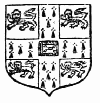
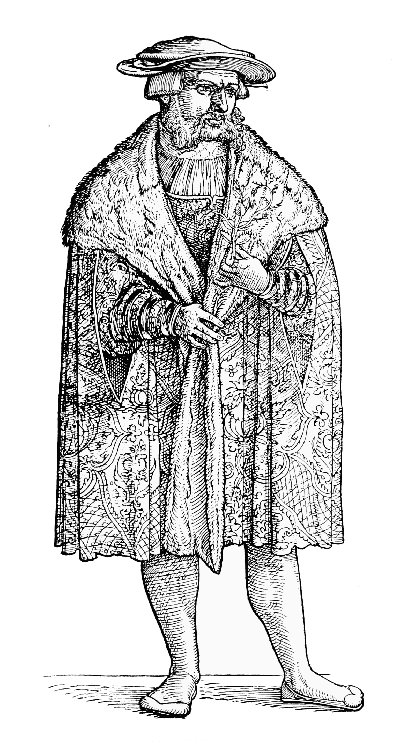
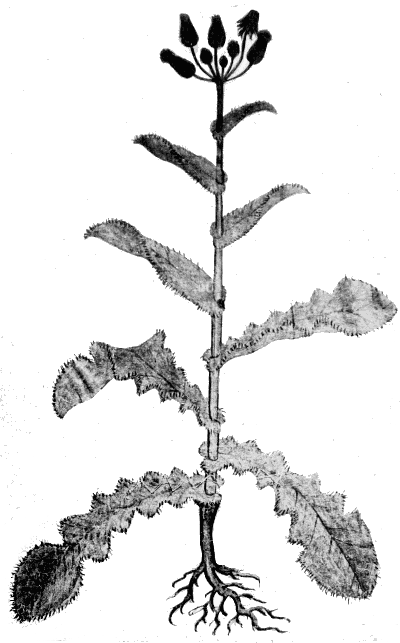


![Text-fig. 1: “Plantago” = Plantain [Herbarium Apuleii Platonici, ? 1484].](images/i_039.png)
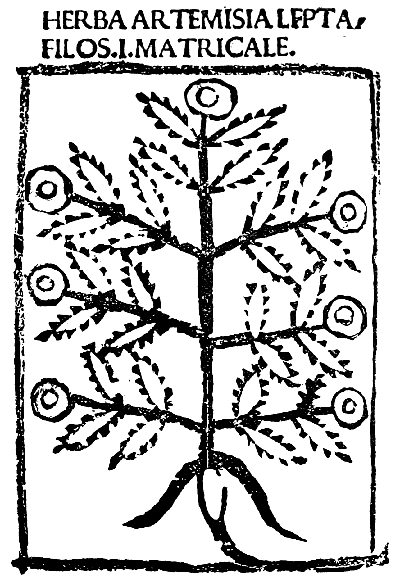
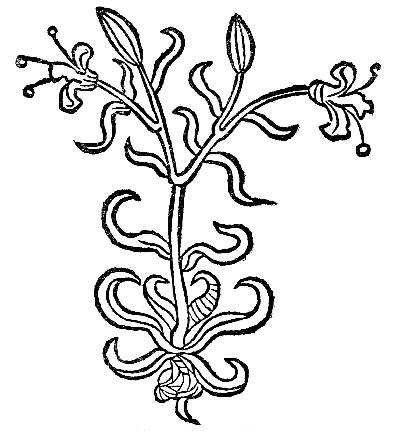
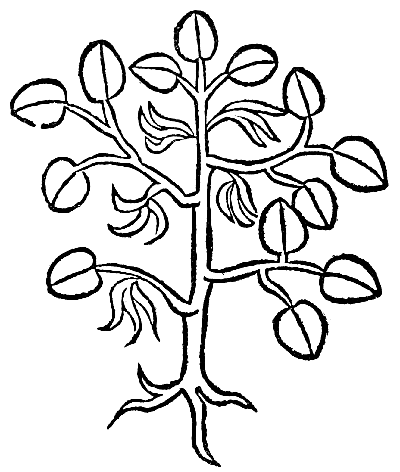
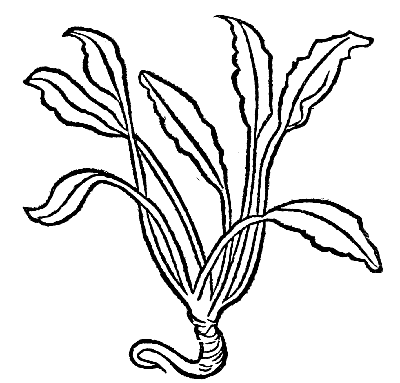
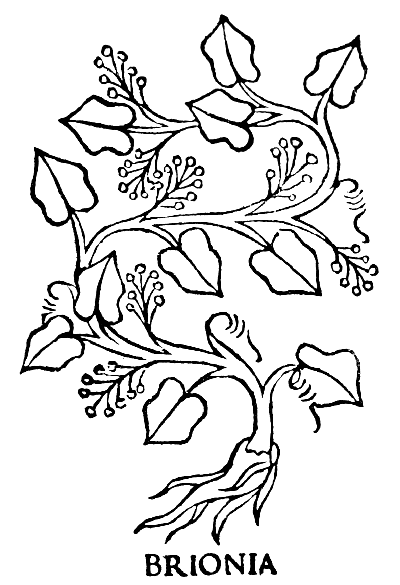
![Text-fig. 7. “Acorus” = Iris [Herbarius zu Teutsch, Mainz, 1485].](images/i_052.png)

![Text-fig. 9. “Daucus”=Carrot [Ortus Sanitatis, Mainz, 1491].](images/i_055.png)
![Text-fig. 10. “Passer” = Sparrow [Ortus Sanitatis, Mainz, 1491].](images/i_056a.png)
![Text-fig. 11. “Pavo” = Peacock [Ortus Sanitatis, Mainz, 1491].](images/i_056b.png)
![Text-fig. 12. “Arbor vel lignum vite paradisi” = Tree of Paradise [Ortus Sanitatis, Mainz, 1491].](images/i_057.png)
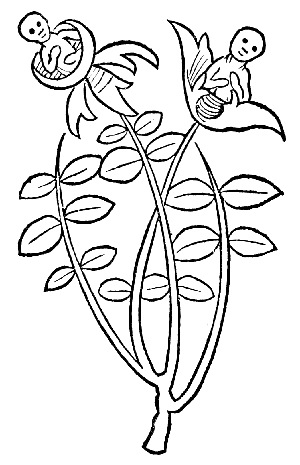
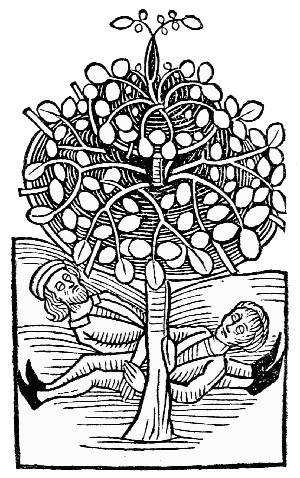
![Text-fig. 15. “Panis” = Bread [Ortus Sanitatis, Mainz, 1491].](images/i_060.png)
![Text-fig. 16. “Ambra” = Amber [Ortus Sanitatis, Mainz, 1491].](images/i_061.png)
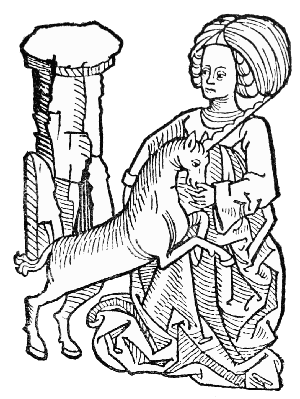
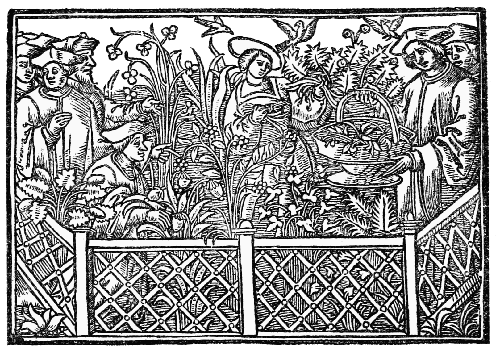
![Text-fig. 20. “Yvery” = Ivory [The Grete Herball, 1529].](images/i_073.png)
![Text-fig. 21. “Nenufar” = Waterlily [The Grete Herball, 1529].](images/i_075.png)

![Text-fig. 27. “Erdberen” = Fragaria, Strawberry [Bock, Kreuter Bůch, 1546].](images/i_085.png)
![Text-fig. 28. “Pimpernuss” = Pistacia, Pistachio-nut [Bock, Kreuter Bůch, 1546].](images/i_087.png)
![Text-fig. 29. “Tribulus aquaticus” = Trapa natans L., Bull-nut [Bock, De stirpium, 1552].](images/i_088.png)
![Text-fig. 30. “Brassicæ quartum genus” = Cabbage [Fuchs, De historia stirpium, 1542]. Reduced.](images/i_090.png)
![Text-fig. 33. “Erdöpffel” = Ranunculus ficaria L., Lesser Celandine [Rhodion, Kreutterbůch, 1533].](images/i_096.png)
![Text-fig. 34. “Ocimoides fruticosum” = Silene fruticosa L. [Camerarius, Hortus medicus, 1588].](images/i_098.png)
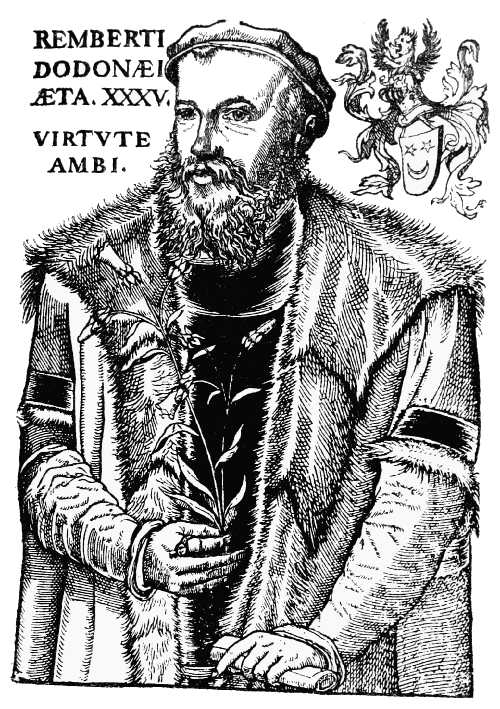
![Text-fig. 37. “Capparis” = Capparis ovata L. [Dodoens, Pemptades, 1583].](images/i_106.png)
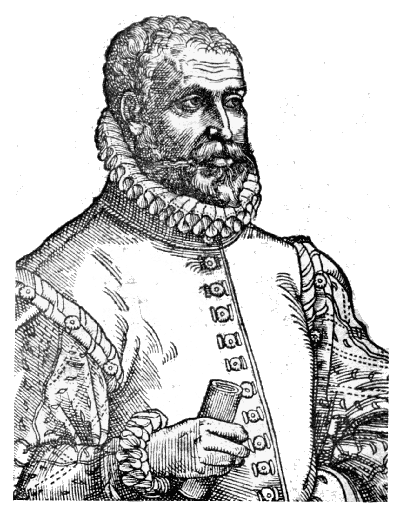
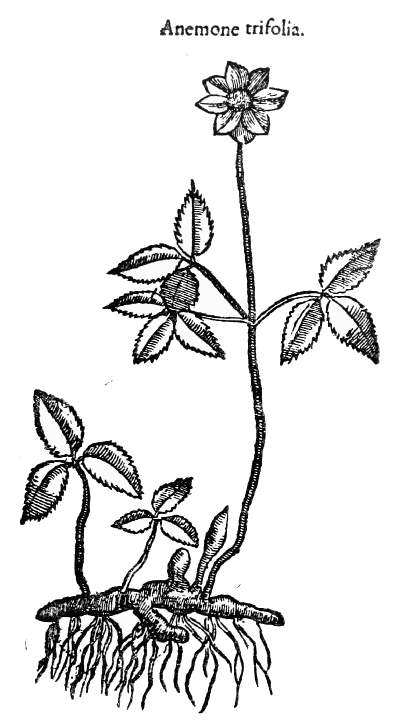
![Text-fig. 41. “Pyra” = Pyrus communis L., Pear [Mattioli, Commentarii, 1560].](images/i_118.png)
![Text-fig. 42. “Avena” = Oats [Mattioli, Commentarii, 1560].](images/i_119.png)
![Text-fig. 43. “Trifolium acetosum” = Oxalis [Mattioli, Commentarii, 1565]. Reduced.](images/i_120.png)
![Text-fig. 44. “Malus” = Pyrus malus L., Apple [Mattioli, Commentarii, 1565]. Reduced.](images/i_121.png)
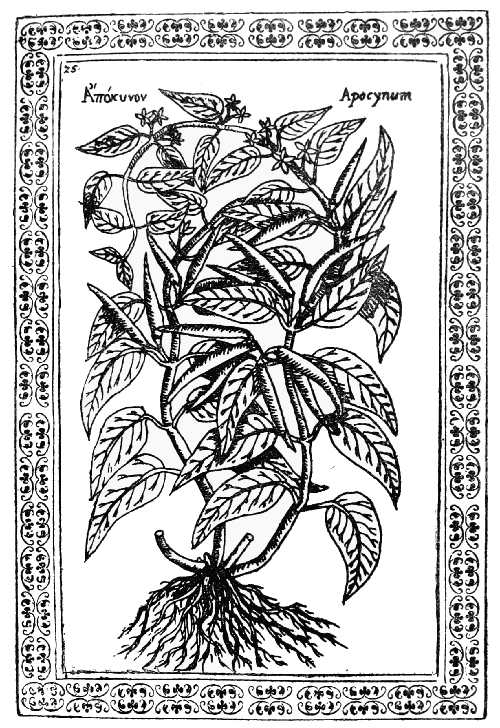

![Text-fig. 47. “Kalli” = Salicornia, Glasswort [Prospero Alpino, De plantis Ægypti, 1592].](images/i_128.png)
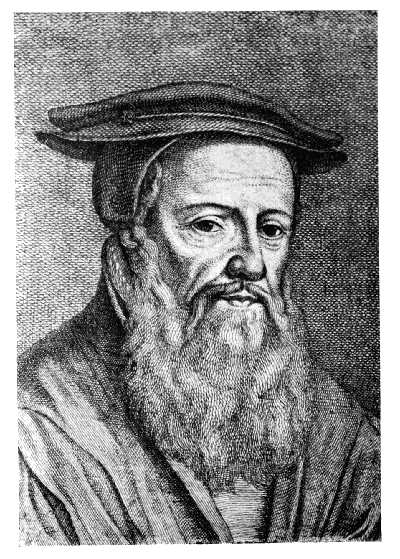
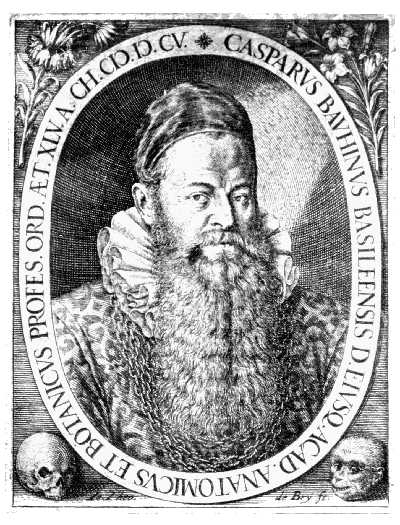
![Text-fig. 49. “Solanum tuberosum esculentum” = Potato [Bauhin, Prodromos, 1620].](images/i_138.png)
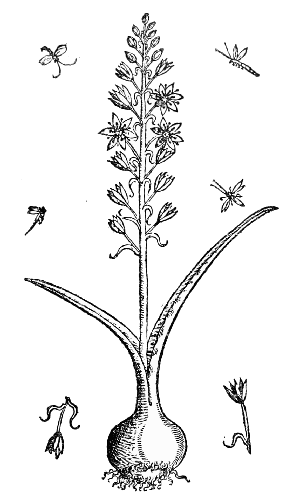
![Text-fig. 53. “Reubarbe” = Centaurea rhaponticum L. [Lyte, A Niewe Herball, 1578].](images/i_150.png)

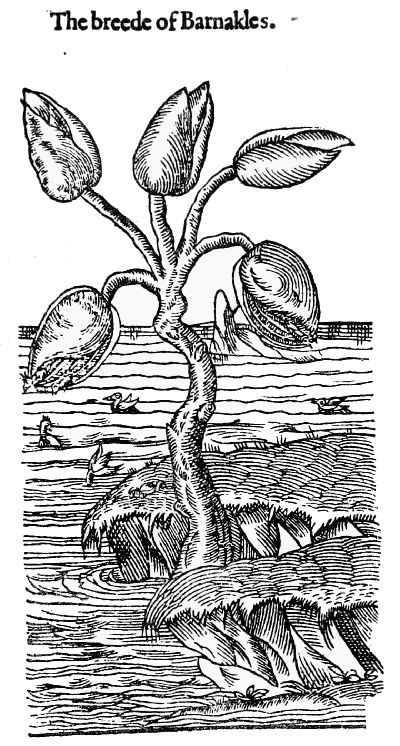
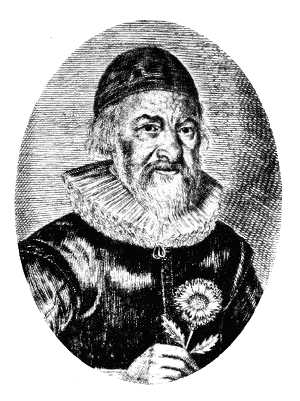
![Text-fig. 56. “Cardamomum” = ? Solanum dulcamara L., Bittersweet [Ortus Sanitatis, Mainz, 1491].](images/i_170.png)
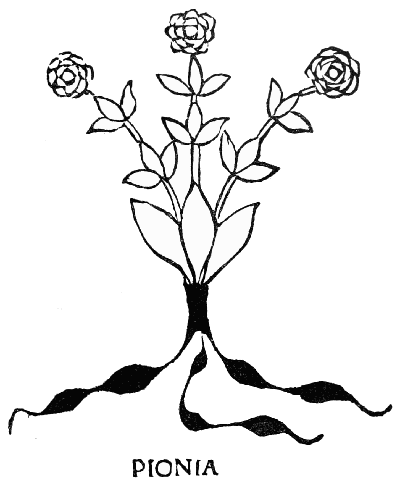
![Text-fig. 58. “Petasites” = Butterbur [Fuchs, De historia stirpium, 1542]. Reduced.](images/i_175.png)
![Text-fig. 58. “Petasites” = Butterbur [Fuchs, De historia stirpium, 1542]. Reduced.](images/i_177.png)
![Text-fig. 60. “Battata Virginiana” = Solanum tuberosum L., Potato [Gerard, The Herball, 1597].](images/i_178.png)
![Text-fig. 61. “Rose Ribwoorte” = an abnormal Plantain [Gerard, The Herball, 1597].](images/i_180.png)

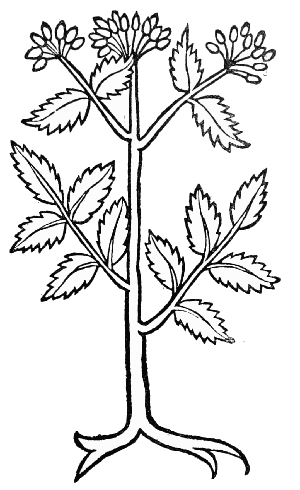

![Text-fig. 67. “Gele Plompen” = Nuphar luteum Sm., Yellow Waterlily [de l’Obel, Kruydtbœck, 1581].](images/i_191.png)
![Text-fig. 68. “Ninfea” = Waterlily [Durante, Herbario Nuovo, 1585].](images/i_193.png)
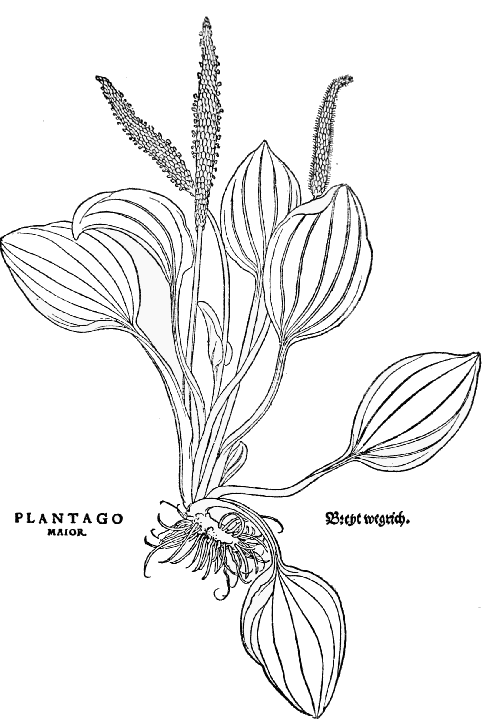
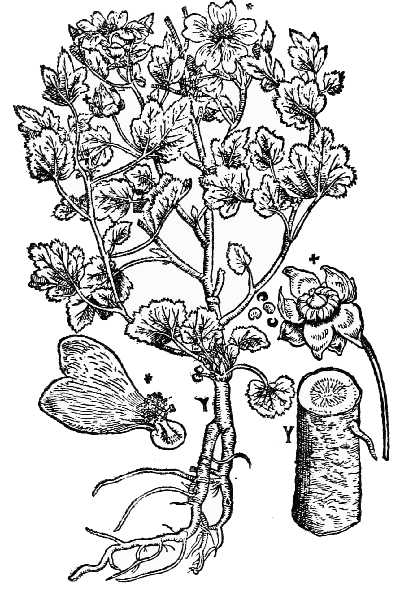
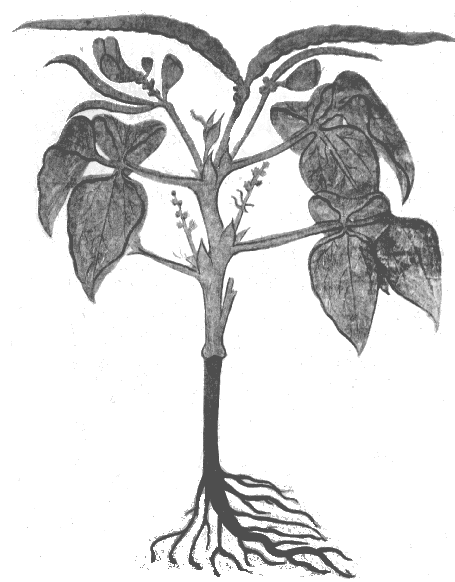
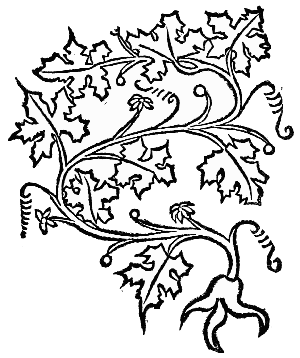
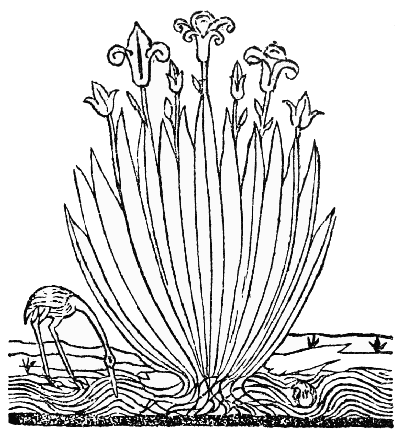
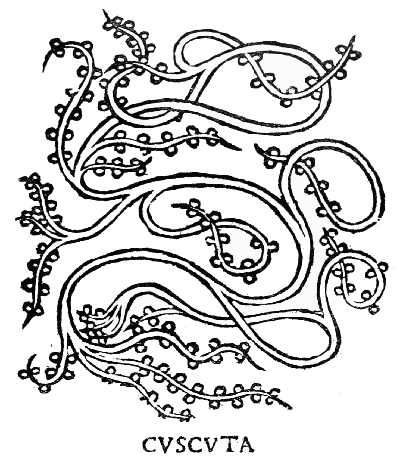
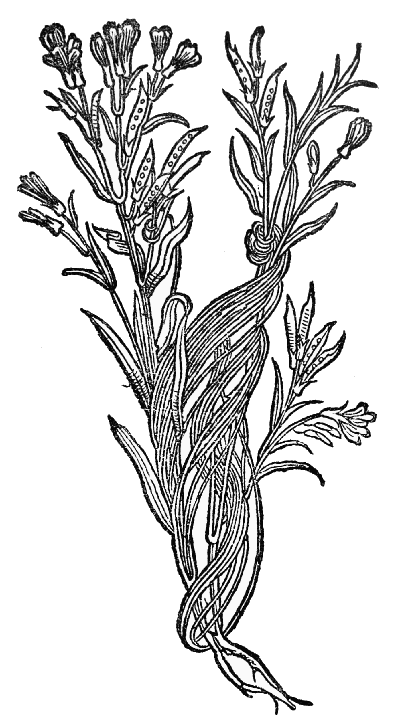
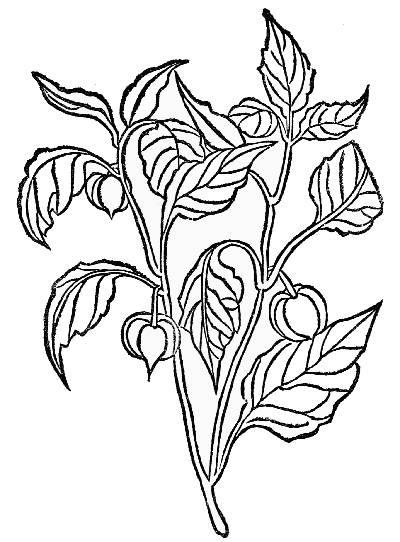
![Text-fig. 79. “Alkekengi” = Physalis, Winter Cherry [Ortus Sanitatis, Mainz, 1491].](images/i_218.png)
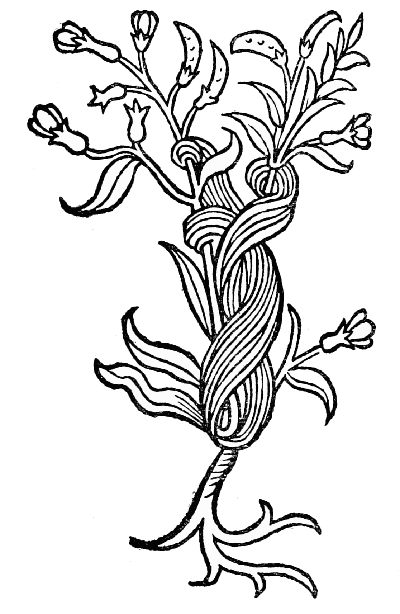
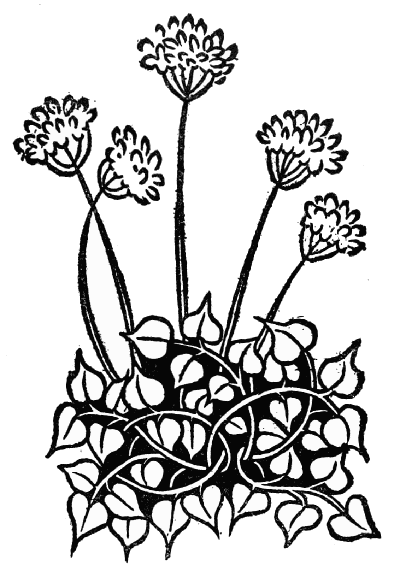
![Text-fig. 82. “Asarum” = Asarabacca [Brunfels, Herbarum vivæ eicones, Vol. I. 1530]. Reduced.](images/i_224.png)
